THE SANCTUARY (2010)
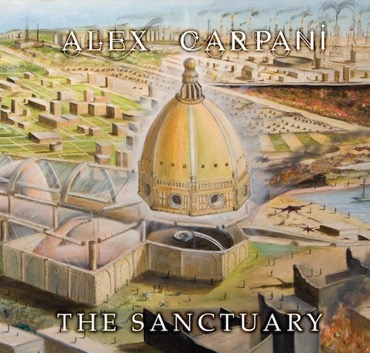
Review index:
No. 01 - MOVIMENTI PROG (Italy)
No. 02 - FLIGHT OF PEGASUS
No. 03 - HEAVY-METAL (Italy)
No. 04 - METAL.IT (Italy)
No. 05 - HARMONIC LIZARD (U.K.)
No. 06 - PROG PULSION (France)
No. 07 - HARD SOUNDS (Italy)
No. 08 - MUSIC IN BELGIUM (Belgium)
No. 09 - MUSIK REVIEWS (Germany)
No. 10 - NONSOLOPROGROCK (Italy)
No. 11 - ROCK IMPRESSIONS (Italy)
No. 12 - POWER OF METAL (Denmark)
No. 13 - MANTICORNIO (Mexico)
No. 14 - RAGAZZI MUSIC (Germany)
No. 15 - PROG GNOSIS (U.S.A.)
No. 16 - PROFIL JIMDO (France)
No. 17 - LORDS OF METAL (The Netherlands)
No. 18 - STEREO INVADERS (Italy)
No. 19 - PROGRESSIA (France)
No. 20 - PROGRESSIVE AREA (France)
No. 21 - INFORMAZIONE METAL (Italy)
No. 22 - ARLEQUINS (Italy)
No. 23 - AMAROCK (France)
No. 24 - JUST FOR KICKS (Germany)
No. 25 - PROG LOG AFTERGLOW (The Netherlands)
No. 26 - PROG-MANIA (France)
No. 27 - ATHOS ENRILE'S MUSIC BLOG (Italy)
No. 28 - ARTISTS & BANDS (Italy)
No. 29 - IO PAGES (The Netherlands)
No. 30 - TRUEMETAL.IT (Italy)
No. 31 - UNPROGGED (Italy)
No. 32 - CLASSIC ROCK (U.K.)
No. 33 - RAW & WILD (Italy)
No. 34 - QUEBEC AUDIO & VIDEO (Canada)
No. 35 - ARTROCK.SE (Sweden)
No. 36 - CHROMATIQUE (France)
No. 37 - MUSIC STREET JOURNAL (U.S.A.)
No. 38 - MERLIN PROG (Norway)
No. 39 - MUSIC BY MAIL (Denmark)
No. 40 - PROGRESSIVE-NEWSLETTER (Germany)
No. 41 - DA MUSIC (Belgium)
No. 42 - PROGRESSOR (Uzbekistan/U.K.)
No. 43 - PROGWERELD (The Netherlands)
No. 44 - HARMONIE MAGAZINE (France)
No. 45 - METALLUS (Italy)
No. 46 - DPRP (The Netherlands)
No. 47 - SINFOMUSIC (Spain)
No. 48 - TEMPI DURI (Italy)
No. 49 - PROGARCHIVES #1 (U.S.A.)
No. 50 - BACKGROUND MAGAZINE (The Netherlands)
No. 51 - PROGARCHIVES #2 (U.S.A.)
No. 52 - PROGARCHIVES #3 (U.S.A.)
No. 53 - DE BASER (Italy)
No. 54 - PROGULATOR (U.S.A.)
No. 55 - PROGMEISTER (U.K.)
No. 56 - ITALIAN PRG MAP (Italy)
No. 57 - NEO PROG (France)
No. 58 - KAKERECO MAGAZINE (Japan)
No. 59 - PROGARCHIVES #4 (U.S.A.)
No. 60 - PROGRESSIVE ROCK CENTRAL (U.S.A.)
No. 61 - EXPOSE' (U.S.A.)
No. 01
MOVIMENTI PROG (ITALY)
http://www.movimentiprog.net/modules.php?op=modload&name=Recensioni&file=view&id=3334
by Donato Zoppo
Secondo, trascinante album per l'ispirato tastierista
Avevamo ascoltato in anteprima alcuni nuovi brani di Alex Carpani al MEI 2009: in quella occasione il tastierista bolognese e la sua band avevano mostrato una grinta e una sicurezza che facevano sperare in un bel secondo disco. "The Sanctuary" conferma quella sensazione e supera in tenuta e coinvolgimento il bell'esordio di "Waterline". Se nel primo disco la presenza di Aldo Tagliapietra valorizzava le composizioni di Alex, ora i pezzi si reggono in piedi da soli, senza la necessità di special guest, fatta eccezione per Gigi Cavalli Cocchi, parte integrante del progetto. Il rock sinfonico di Carpani, nell'ereditare dal progressive storico la combinazione di elementi maschili e femminili, di spinte rock e sapori romantici, si adatta perfettamente all'atmosfera mistica ed enigmatica di questo concept, "consacrato" dalla copertina di Paul Whitehead e aperto da "Burning Braziers", un art-rock dinamico e serrato che inaugura perfettamente il nuovo lavoro. Se il riferimento del precedente cd spaziava tra Genesis e Orme, stavolta il neoprog carpaniano si fa più acceso, articolato, melodico e agevole come sempre ma intrigante, muscolare all'occorrenza. "Spirit of decadence", "Templars dream" e "Moonlight throught the ruins" ne sono uno spaccato molto convincente. L'album è prevalentemente strumentale ma non rivela momenti di noia e stanchezza. Meno fascinosa rispetto a quella di Tagliapietra, la voce di Alex rende bene e funziona nel contesto concettuale: assolutamente sfavillante il suo keyboard-playing (vedi il tourbillon di "The dance of the sacred elves" e "Entering the sanctuary"), autentico protagonista tra hammond, synth, pianoforte e mellotron. Se "Waterline" puntava di più sulle tessiture, sull'evanescenza, "The sanctuary", anche per merito di una band presente e incalzante, vira in una direzione più sanguigna, benchè non manchino episodi più rifiniti come "Memories of a wedding" e la splendida "Master of ceremonies". "The Sanctuary" dimostra che con idee, vivacità e passione è ancora possibile confezionare degli ottimi lavori di rock sinfonico. Disco più che eccellente, una delle migliori uscite prog del 2010.
No. 02
FLIGHT OF PEGASUS (GREECE)
http://www.flightofpegasus.gr/heavy_metal/index.php?option=com_content&task=blogcategory&id=1&Itemid=28&limit=9&limitstart=63
by the staff
Για το δεύτερο άλμπουμ του ο ιταλός οργανίστας έκανε μια πολύ αποτελεσματική κίνηση και εμπιστεύτηκε το εξώφυλλό του στονPaul Whitehead , σαφώς γνωστόν από τις δουλειές του για τουςGenesis . Για μια ακόμα φορά παρουσιάζει συνθέσεις εμφανέστατα εμπνευσμένες από το δεκαετία του ’70 που εύκολα μπορούν να περιγραφούν ως συμφωνικόprog . Φωνητικά δεν εμφανίζονται στην πλειονότητα των κομματιών, αλλά αυτό δεν μειώνει στο ελάχιστο το ενδιαφέρον τους. Με ωραίες στιγμές, πομπώδεις, ρυθμικές, ενίοτε παιγνιώδεις, η ακρόαση γίνεται πραγματικά ευχάριστη, παρ’ όλο που κάποιες φορές τα πράγματα στο βάθος είναι μάλλον πιο σύνθετα απ’ όσο φαντάζουν. Πρόκειται για πειστικό υλικό, ακριβώς επειδή είναι πολύ κοντά στις καταβολές του συνθέτη. Αν πάλι θεωρείτε πως αυτό το είδος δεν έχει ισχυρή θέση στη σύγχρονη σκηνή, εδώ έχετε την απόδειξη πως, όταν είναι καλοστημένο, μπορεί να κερδίζει με τον καλύτερο τρόπο πόντους επικαιρότητας. Μια κυκλοφορία που αξίζει να προσέξετε.
No. 03
HEAVY-METAL (ITALY)
http://www.heavy-metal.it/recensioni/album_templ.php?id=3235
by Andrea Rodella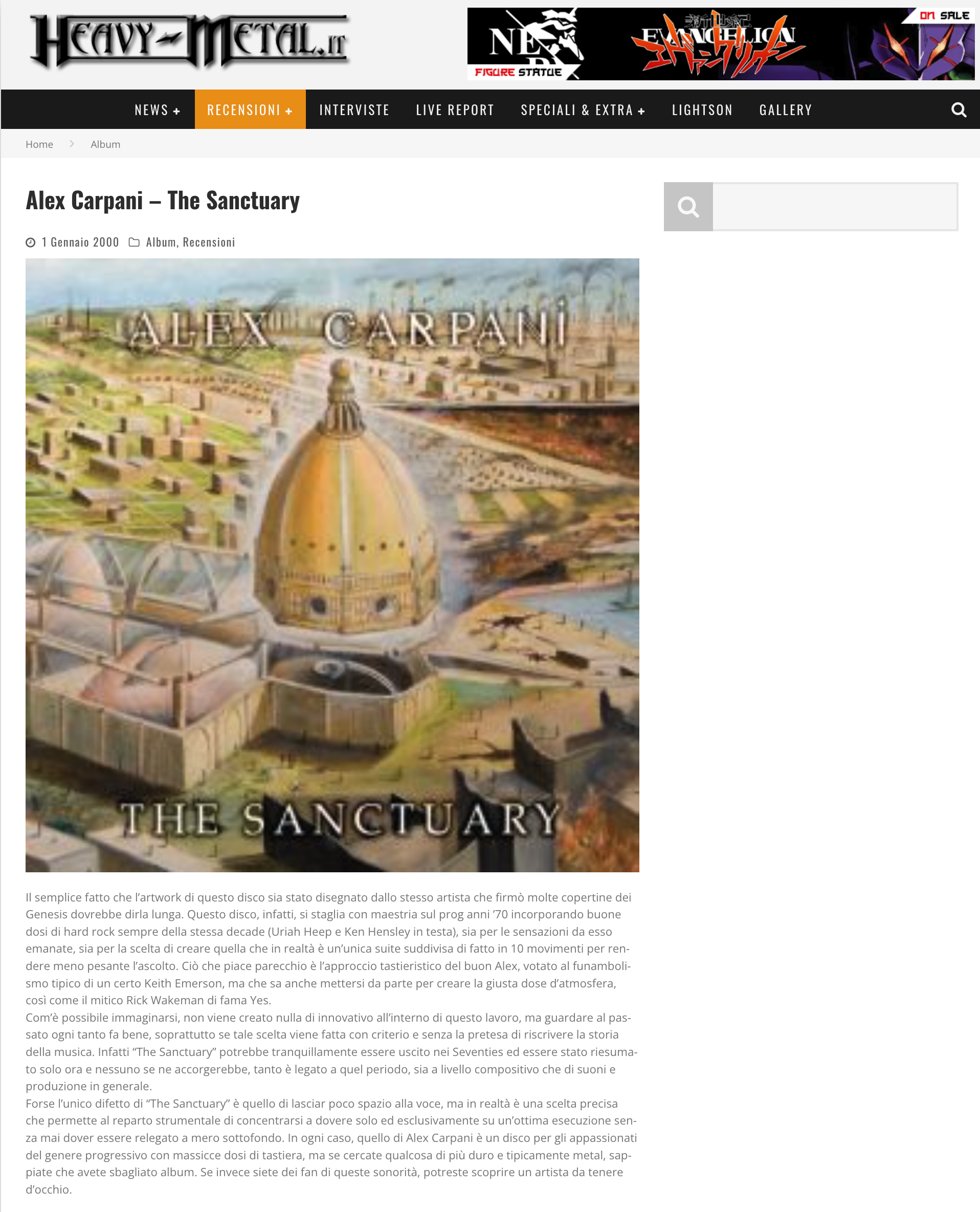
Il semplice fatto che l’artwork di questo disco sia stato disegnato dallo stesso artista che firmò molte copertine dei Genesis dovrebbe dirla lunga. Questo disco, infatti, si staglia con maestria sul prog anni ’70 incorporando buone dosi di hard rock sempre della stessa decade (Uriah Heep e Ken Hensley in testa), sia per le sensazioni da esso emanate, sia per la scelta di creare quella che in realtà è un’unica suite suddivisa di fatto in 10 movimenti per rendere meno pesante l’ascolto. Ciò che piace parecchio è l’approccio tastieristico del buon Alex, votato al funambolismo tipico di un certo Keith Emerson, ma che sa anche mettersi da parte per creare la giusta dose d’atmosfera, così come il mitico Rick Wakeman di fama Yes.
Com’è possibile immaginarsi, non viene creato nulla di innovativo all’interno di questo lavoro, ma guardare al passato ogni tanto fa bene, soprattutto se tale scelta viene fatta con criterio e senza la pretesa di riscrivere la storia della musica. Infatti “The Sanctuary” potrebbe tranquillamente essere uscito nei Seventies ed essere stato riesumato solo ora e nessuno se ne accorgerebbe, tanto è legato a quel periodo, sia a livello compositivo che di suoni e produzione in generale.
Forse l’unico difetto di “The Sanctuary” è quello di lasciar poco spazio alla voce, ma in realtà è una scelta precisa che permette al reparto strumentale di concentrarsi a dovere solo ed esclusivamente su un’ottima esecuzione senza mai dover essere relegato a mero sottofondo. In ogni caso, quello di Alex Carpani è un disco per gli appassionati del genere progressivo con massicce dosi di tastiera, ma se cercate qualcosa di più duro e tipicamente metal, sappiate che avete sbagliato album. Se invece siete dei fan di queste sonorità, potreste scoprire un artista da tenere d’occhio.
No. 04
METAL.IT (ITALY)
http://www.metal.it/album.aspx/13151/10621/
by Pippo Marino
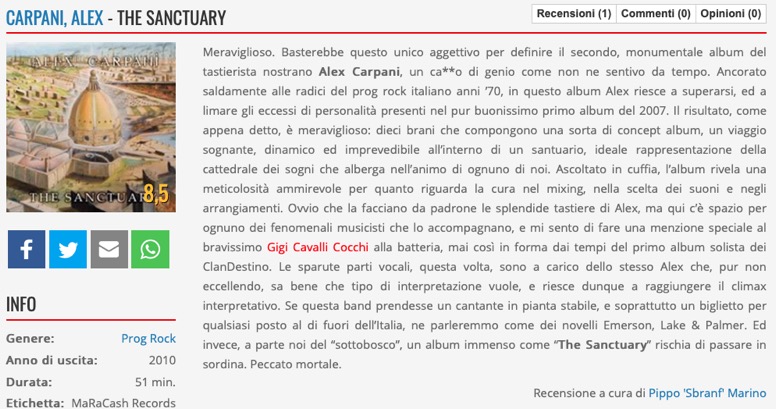
Meraviglioso. Basterebbe questo unico aggettivo per definire il secondo, monumentale album del tastierista nostrano Alex Carpani, un ca**o di genio come non ne sentivo da tempo. Ancorato saldamente alle radici del prog rock italiano anni ’70, in questo album Alex riesce a superarsi, ed a limare gli eccessi di personalità presenti nel pur buonissimo primo album del 2007. Il risultato, come appena detto, è meraviglioso: dieci brani che compongono una sorta di concept album, un viaggio sognante, dinamico ed imprevedibile all’interno di un santuario, ideale rappresentazione della cattedrale dei sogni che alberga nell’animo di ognuno di noi. Ascoltato in cuffia, l’album rivela una meticolosità ammirevole per quanto riguarda la cura nel mixing, nella scelta dei suoni e negli arrangiamenti. Ovvio che la facciano da padrone le splendide tastiere di Alex, ma qui c’è spazio per ognuno dei fenomenali musicisti che lo accompagnano, e mi sento di fare una menzione speciale al bravissimo Gigi Cavalli Cocchi alla batteria, mai così in forma dai tempi del primo album solista dei ClanDestino. Le sparute parti vocali, questa volta, sono a carico dello stesso Alex che, pur non eccellendo, sa bene che tipo di interpretazione vuole, e riesce dunque a raggiungere il climax interpretativo. Se questa band prendesse un cantante in pianta stabile, e soprattutto un biglietto per qualsiasi posto al di fuori dell’Italia, ne parleremmo come dei novelli Emerson, Lake & Palmer. Ed invece, a parte noi del “sottobosco”, un album immenso come “The Sanctuary” rischia di passare in sordina. Peccato mortale.
No. 05
HARMONIC LIZARD (UK)
ALBUM OF THE WEEK (December 7th, 2010)
http://harmoniclizard.com/?q=node/592
by Todders
MaRaCash Records have kindly sent me this album to review and it is my first exposure to Alex Caparini and his assembled musicians. According to the press release this is his second album, the first “Waterline” was an enormous success and was followed by a widely anticipated world tour. Alex Carpani composed, arranged, orchestrated and produced the whole album himself along with all the vocal duties and keyboards. The cd cover is really a work of art and it was painted by the great “Paul Whitehead” ,it really gives the album its flavour and compliments the music with its portrayal of “The Sanctuary”. The first track begins in a very mellow manner with keyboard sound bites, and a very Arabian styled guitar punctuating the landscape. There is some superb old school symphonic keyboard playing which keeps the track honest throughout, and a number of additional keyboard swirls and changing time signatures which always keep you guessing. It is a medium paced song and demonstrates the band are very skilful at producing a purely instrumental track which keeps you interested and is a good opening to the album. There are ten tracks on the album which are linked to tell a story, with this is mind we immediately flow into “Spirit Of Deadence” which yet again builds with an atmospheric opening of piano and a haunting keyboard backing before we hear the first laid back but very effective vocals on the album by Alex Carpani. The keyboards dominate the sound again with some really effective textures and swirls. The guitar at times can be heard in the background a real gentle sound but it adds a lot of dimension to the overall sound. There is also a beautiful orchestral section towards the end of this track. Creating the mood of the next track “The Dance of the Sacred Elves” perfectly we have the keyboards and guitar fighting for the dominate position within the mix, it is a real quirky number with some excellent new wave elements present. At times it can transport you back a number of years to the hey-day of progressive music but also with a refreshing new outlook on the genre at the same time. “Entering The Sanctuary” starts in a very upbeat mood with some excellent guitar work and the story telling prowess of Alex Carpani. I really love the keyboard sounds that are on this album and this track particularly is a perfect example of this. The music really manages to ebb and flow with majestic presence and even the guitar makes an impression at times when it is called upon. The vocals are not the strongest you will hear this year but as part of the overall sound they suit very well. The superbly titled “Knights and Clergymen” yet again is another keyboard dominated track with some excellent percussion and bass. The whole band seem to hit their full stride on this track, the relentless rhythm is almost hypnotic at times. The paces changes superbly well towards the end of the track with another haunting and memorable orchestrated section before finishing in a full band workout which at times is truly sublime. We move onto “Templars Dream” which contains some excellent electric guitar before propelled on a swathe of keyboard greatness and a pulsating rhythm section once again. With some superb melody at times it manages to create the required atmosphere without ever sounding overblown or pompous. The vocals are joined by a wailing guitar which follows the lyrics without drowning out the message. The keyboards are used to full effect once again but only to add to the overall experience and although there are the occasional solos they really feel a full part of the listening experience. The final vocal flourish finishes off another superb track. The next track on the journey into the sanctuary is “Memories Of A wedding” which has a very Rick Wakeman sounding piano introduction before the bass makes its move with another appearance from the guitar which keeps pace with the ever changing keyboard patterns. It is very difficult at times to know where the songs will go next but this is a good thing as you are always constantly surprised at the twist and turns. It really feels like an instrumental track until the vocals make a swift appearance before the music dominates again. Full of atmosphere and some very clever composition skills are displayed and played to an extremely high level. More symphonic greatness greats us with “Master Of Ceremonies” a beautiful piano and guitar create the path of the song before we return to the sonic greatness of the keyboard sounds Alex Carpani seems able to create with such passion and almost at will. It almost sounds avant-garde in parts but it is put together so well you can hardly feel the joins. There are a huge amount of different influences displayed on this track it evens comes with a flamenco sounding finale. “Moonlight Through The Ruins” continues this extremely enjoyable concept with another example of how to write a modern progressive rock song with it`s feet still firmly placed in honouring all the past masters of the genre. It is a slower paced song overall and is an important part of the jigsaw of this album. I love the guitar and the way it battles with the keyboard at times for its own lone voice, it never really succeeds but that doesn’t stop it from trying. The final track is titled “Leaving the Sanctuary” and it begins in quite dominant fashion with a really solid rhythm section and very melodic keyboards setting the pace to dramatic effect once again. The drums really come into their own about half way through the track, also joined by small glimpses of guitar. The keyboard playing becomes a little more extravagant towards the end of this piece and it is a fitting instrumental conclusion to a very enjoyable album. The vocals as I have mentioned before are not really the albums strong point but do seem to fit the compositions very well and don`t feel out of place. With one foot rooted in the past and one firmly in the future Alex Carpani has produced a superb concept album with “The Sanctuary”. 85/100
No. 06
PROG PULSION (FRANCE)
http://www.progpulsion.com/catalog/Nouveautes+Novembre+2010/CARPANI,+Alex+(Ita)?osCsid=mdzlwrix
by the staff
Pour son deuxième album, Alex Carpani -toujours bien entouré- nous ouvre les portes d'un Progressif 70's symphonique et contrasté. Claviers en tous genres, guitares Génesissiennes, ambiances orchestrales, "The sanctuary" tient toutes les promesses engagées avec "Waterline" il y a 3 ans. On y retient certes un esprit italien évoquant LE ORME, The Watch ou PFM, mais aussi des pointures comme YES ou ELP. Et bien sûr Paul Whitehead a conçu la pochette! Notons qu'enfin, la qualité du son, qui pouvait parfois gêner sur le 1er album, fait partie dorénavant des points forts. Excellente sortie donc!
No. 07
HARD SOUNDS (ITALY)
http://www.hardsounds.it/PUBLIC/recensione.php?id=6803
by Paolo Brilli
Avevamo già apprezzato Alex Carpani e le sue tastiere nell'esordio di 3 anni fa intitolato 'Waterline', ed eccolo tornare con il suo nuovo lavoro 'The Sanctuary' edito dalla Maracash Records. Il disco è composto da 50 minuti prettamente strumentali dove le tastiere dell'artista italiano fanno da padrone, e le sonorità sono si stampo sinfonico/prog con chiarissimi rimandi agli anni '70. Le parti vocali, eseguite questa volta da Alex stesso, sono più un accompagnamento saltuario all'interno del disco, e l'ascoltatore viene lasciato più spesso in balia della sola musica che si districa ottimamente negli arrangiamenti mai banali che vengono proposti. Il lavoro dei tre compagni di viaggio è di alto livello e ben si amalgama con l'estro e ed il chiaro predominio di Alex sul resto del gruppo (d'altronde è quello che gli si chiede in opere di questo tipo). Le dieci tracce passano quindi in maniera veloce e senza stancare, cosa non sempre facile per i dischi strumentali, dimostrando ancora una volta che siamo di fronte ad un prodotto ben fatto ed azzeccato. Inoltre ad impreziosire il tutto c'è anche la stupenda copertina disegnata da Paul Whitehead, che in passato ha collaborato tantissimo con i Genesis su copertine, disegni e bozze per i loro album. In definitiva, se amate il prog sinfonico, e specialmente le tastiere, questo è un disco da non perdere perché sicuramente saprà accontentarvi nel migliore dei modi. Per quanto riguarda Alex speriamo che possa ottenere il giusto riconoscimento anche a livello internazionale, e non rischi di passare troppo sotto banco come purtroppo accade per molti interessanti gruppi del sottobosco italiano.
Carpani colpisce ancora.
Voto: 78/100
No. 08
MUSIC IN BELGIUM (BELGIUM)
http://www.musicinbelgium.net/pl/modules.php?name=Reviews&rop=showcontent&id=4590
by Jean-Pierre Lhoir

Il y a des rencontres qui changent votre vie. C'est sans doute ce qui est arrivé à Alex Carpani quand il s'est retrouvé sur les bancs de l'école avec le fils de Keith Emerson. Ses études l'ont dirigé vers un graduat en musicologie à Bologne (Italie) avant de se consacrer aux musiques de film. Tiens donc, Keith Emerson a aussi écrit des musiques de film. Son premier album ne sort qu'en 2007, alors qu'il a 37 ans déjà. C'est "Waterline". Le projet devait être instrumental, mais finalement il fait appel à différents musiciens et au chanteur Aldo Tagliapietra (Le Orme). Cette fois, pour son 2nd opus, Alex Carpani a décidé d'assurer le chant lui-même, et c'est tant mieux car il est moins imprégné du progressif italien des années 1970. Sa voix est intense et vibrante. Elle séduit, et pourtant il semble se retenir. Espérons qu'il se lâche plus pour le 3e. À ses côtés, on trouve le batteur Gigi Cavalli Cocchi (Mangala Vallis), le guitariste Ettore Salati (ex-The Watch) et le bassiste Fabiano Spiga (ACB). Équipe réduite donc, mais de grande qualité ! L'influence de Keith Emerson et de ELP est flagrante, mais celle du grand Genesis n'est jamais bien loin non plus. La première se remarque dès "Burning Braziers" alors que la seconde envahit "Spirit Of Decadence". L'instrumental "The Dance Of The Sacred Elves" prend des airs d'un "Pictures At An Exhibition" mélangé à un "Brain Salad Surgery". Sur "Entering The Sanctuary", la guitare est plus agressive. Le chant suit parfois les traces d'un Greg Lake, même s'il n'en a pas la profondeur. La basse va chercher ses notes dans les graves groovantes pour "Knights And Clergymen". Les claviers virevoltent. L'ambiance est tantôt sombre et mystérieuse, tantôt très expressive. "Templars Dream" se tourne vers le Genesis des grandes années avec un chant intrigant, mais les claviers restent très Emerson. "Memories Of A Wedding" dégage une certaine mélancolie pour évoquer les souvenirs. La section rythmique est cependant tranchante et les breaks sont nombreux. "Master Of Ceremonies" développe un symphonisme emersonnien avant de basculer vers une ambiance genesienne époque "Selling England By The Pound". L'ombre de Genesis est toujours présente sur "Moonlight Through The Ruins" avec une envolée grandiose et un passage torturé. Le début classique de "Leaving The Sanctuary" cède vite la place à des ambiances changeantes et une tension qui grimpe au fil du temps. Ce deuxième opus d'Alex Carpani séduit. La production est bien meilleure, le mixage aussi. Le chant est plus personnel et Carpani a une très belle voix qu'il devrait développer. Enfin, il nous présente ici un ensemble plus cohérent, peut-être aussi parce qu'il a enregistré le tout avec une équipe réduite. À découvrir si vous aimez le progressif des seventies.
No. 09
MUSIK REVIEWS (GERMANY)
http://www.musikreviews.de/reviews/2010/Alex-Carpani/The-Sanctuary/
by Thoralf Koß
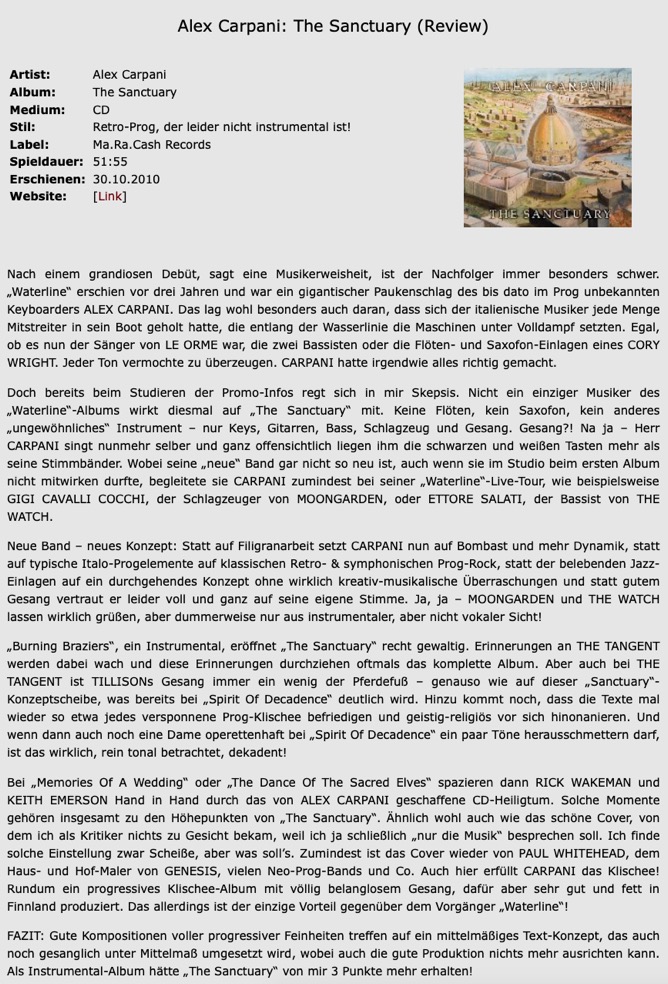
Nach einem grandiosen Debüt, sagt eine Musikerweisheit, ist der Nachfolger immer besonders schwer. „Waterline“ erschien vor drei Jahren und war ein gigantischer Paukenschlag des bis dato im Prog unbekannten Keyboarders ALEX CARPANI. Das lag wohl besonders auch daran, dass sich der italienische Musiker jede Menge Mitstreiter in sein Boot geholt hatte, die entlang der Wasserlinie die Maschinen unter Volldampf setzten. Egal, ob es nun der Sänger von LE ORME war, die zwei Bassisten oder die Flöten- und Saxofon-Einlagen eines CORY WRIGHT. Jeder Ton vermochte zu überzeugen. CARPANI hatte irgendwie alles richtig gemacht. Doch bereits beim Studieren der Promo-Infos regt sich in mir Skepsis. Nicht ein einziger Musiker des „Waterline“-Albums wirkt diesmal auf „The Sanctuary“ mit. Keine Flöten, kein Saxofon, kein anderes „ungewöhnliches“ Instrument – nur Keys, Gitarren, Bass, Schlagzeug und Gesang. Gesang?! Na ja – Herr CARPANI singt nunmehr selber und ganz offensichtlich liegen ihm die schwarzen und weißen Tasten mehr als seine Stimmbänder. Wobei seine „neue“ Band gar nicht so neu ist, auch wenn sie im Studio beim ersten Album nicht mitwirken durfte, begleitete sie CARPANI zumindest bei seiner „Waterline“-Live-Tour, wie beispielsweise GIGI CAVALLI COCCHI, der Schlagzeuger von MOONGARDEN, oder ETTORE SALATI, der Bassist von THE WATCH. Neue Band – neues Konzept: Statt auf Filigranarbeit setzt CARPANI nun auf Bombast und mehr Dynamik, statt auf typische Italo-Progelemente auf klassischen Retro- & symphonischen Prog-Rock, statt der belebenden Jazz-Einlagen auf ein durchgehendes Konzept ohne wirklich kreativ-musikalische Überraschungen und statt gutem Gesang vertraut er leider voll und ganz auf seine eigene Stimme. Ja, ja – MOONGARDEN und THE WATCH lassen wirklich grüßen, aber dummerweise nur aus instrumentaler, aber nicht vokaler Sicht! „Burning Braziers“, ein Instrumental, eröffnet „The Sanctuary“ recht gewaltig. Erinnerungen an THE TANGENT werden dabei wach und diese Erinnerungen durchziehen oftmals das komplette Album. Aber auch bei THE TANGENT ist TILLISONs Gesang immer ein wenig der Pferdefuß – genauso wie auf dieser „Sanctuary“-Konzeptscheibe, was bereits bei „Spirit Of Decadence“ deutlich wird. Hinzu kommt noch, dass die Texte mal wieder so etwa jedes versponnene Prog-Klischee befriedigen und geistig-religiös vor sich hinonanieren. Und wenn dann auch noch eine Dame operettenhaft bei „Spirit Of Decadence“ ein paar Töne herausschmettern darf, ist das wirklich, rein tonal betrachtet, dekadent! Bei „Memories Of A Wedding“ oder „The Dance Of The Sacred Elves“ spazieren dann RICK WAKEMAN und KEITH EMERSON Hand in Hand durch das von ALEX CARPANI geschaffene CD-Heiligtum. Solche Momente gehören insgesamt zu den Höhepunkten von „The Sanctuary“. Ähnlich wohl auch wie das schöne Cover, von dem ich als Kritiker nichts zu Gesicht bekam, weil ich ja schließlich „nur die Musik“ besprechen soll. Ich finde solche Einstellung zwar Scheiße, aber was soll’s. Zumindest ist das Cover wieder von PAUL WHITEHEAD, dem Haus- und Hof-Maler von GENESIS, vielen Neo-Prog-Bands und Co. Auch hier erfüllt CARPANI das Klischee! Rundum ein progressives Klischee-Album mit völlig belanglosem Gesang, dafür aber sehr gut und fett in Finnland produziert. Das allerdings ist der einzige Vorteil gegenüber dem Vorgänger „Waterline“! FAZIT: Gute Kompositionen voller progressiver Feinheiten treffen auf ein mittelmäßiges Text-Konzept, das auch noch gesanglich unter Mittelmaß umgesetzt wird, wobei auch die gute Produktion nichts mehr ausrichten kann. Als Instrumental-Album hätte „The Sanctuary“ von mir 3 Punkte mehr erhalten!
No. 10
NONSOLOPROGROCK (ITALY)
http://nonsoloprogrock.blogspot.com/2010/12/alex-carpani.html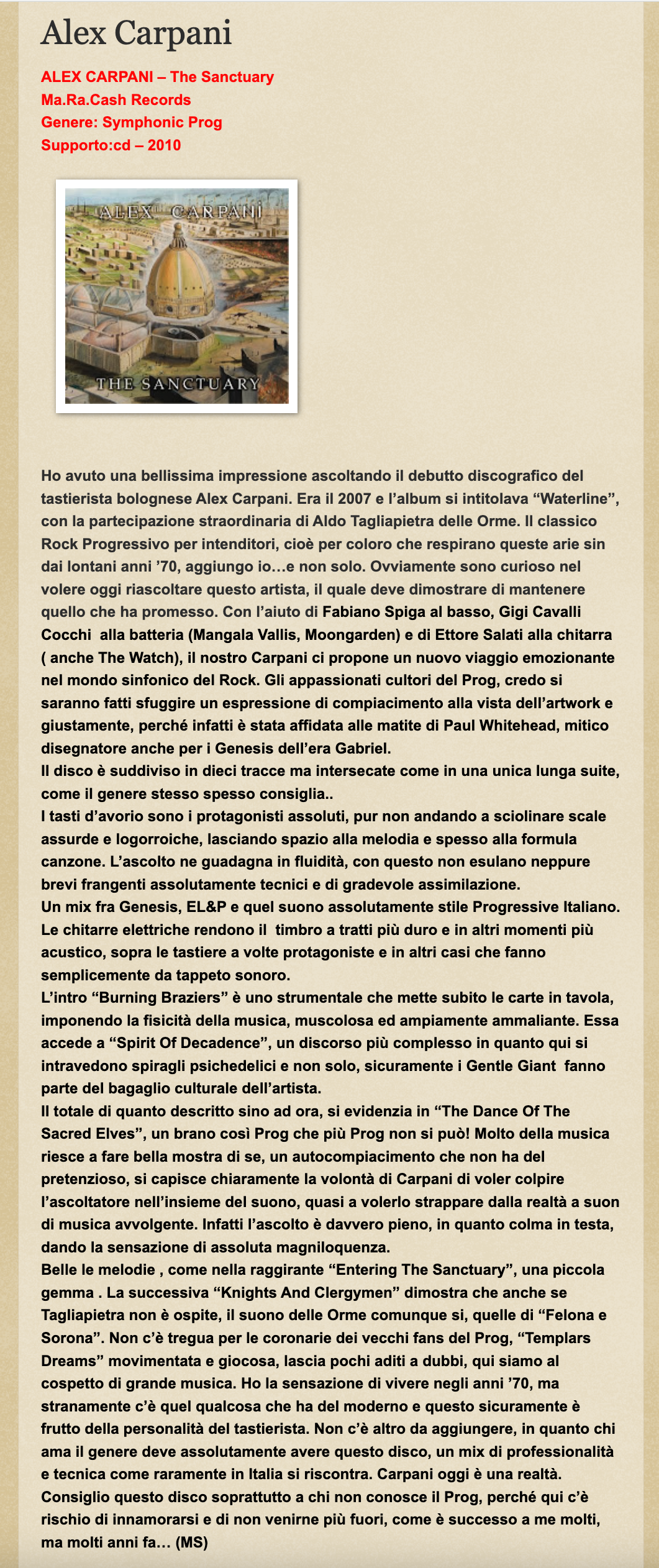
No. 11
ROCK IMPRESSIONS (ITALY)
http://www.rock-impressions.com/carpani2.htm
by Massimo Salari
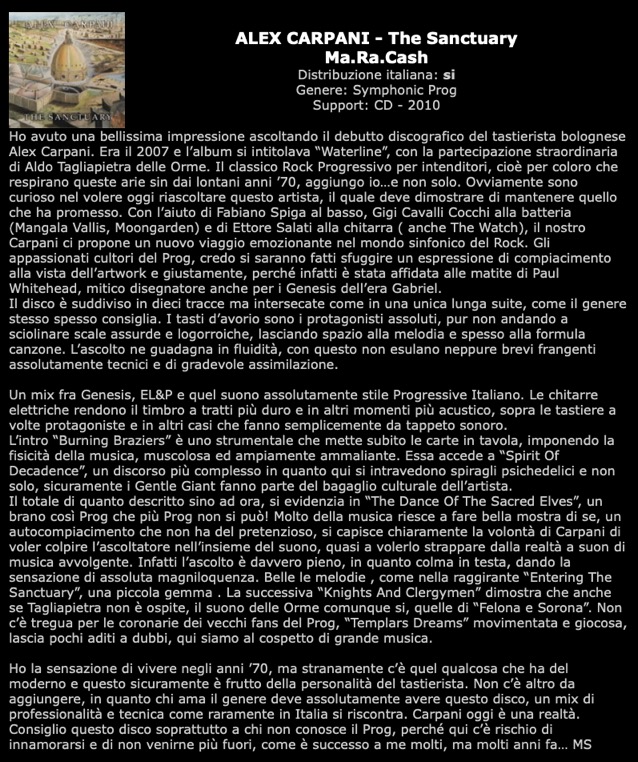
Ho avuto una bellissima impressione ascoltando il debutto discografico del tastierista bolognese Alex Carpani. Era il 2007 e l’album si intitolava “Waterline”, con la partecipazione straordinaria di Aldo Tagliapietra delle Orme. Il classico Rock Progressivo per intenditori, cioè per coloro che respirano queste arie sin dai lontani anni ’70, aggiungo io…e non solo. Ovviamente sono curioso nel volere oggi riascoltare questo artista, il quale deve dimostrare di mantenere quello che ha promesso. Con l’aiuto di Fabiano Spiga al basso, Gigi Cavalli Cocchi alla batteria (Mangala Vallis, Moongarden) e di Ettore Salati alla chitarra ( anche The Watch), il nostro Carpani ci propone un nuovo viaggio emozionante nel mondo sinfonico del Rock. Gli appassionati cultori del Prog, credo si saranno fatti sfuggire un espressione di compiacimento alla vista dell’artwork e giustamente, perché infatti è stata affidata alle matite di Paul Whitehead, mitico disegnatore anche per i Genesis dell’era Gabriel. Il disco è suddiviso in dieci tracce ma intersecate come in una unica lunga suite, come il genere stesso spesso consiglia.. I tasti d’avorio sono i protagonisti assoluti, pur non andando a sciolinare scale assurde e logorroiche, lasciando spazio alla melodia e spesso alla formula canzone. L’ascolto ne guadagna in fluidità, con questo non esulano neppure brevi frangenti assolutamente tecnici e di gradevole assimilazione. Un mix fra Genesis, EL&P e quel suono assolutamente stile Progressive Italiano. Le chitarre elettriche rendono il timbro a tratti più duro e in altri momenti più acustico, sopra le tastiere a volte protagoniste e in altri casi che fanno semplicemente da tappeto sonoro. L’intro “Burning Braziers” è uno strumentale che mette subito le carte in tavola, imponendo la fisicità della musica, muscolosa ed ampiamente ammaliante. Essa accede a “Spirit Of Decadence”, un discorso più complesso in quanto qui si intravedono spiragli psichedelici e non solo, sicuramente i Gentle Giant fanno parte del bagaglio culturale dell’artista. Il totale di quanto descritto sino ad ora, si evidenzia in “The Dance Of The Sacred Elves”, un brano così Prog che più Prog non si può! Molto della musica riesce a fare bella mostra di se, un autocompiacimento che non ha del pretenzioso, si capisce chiaramente la volontà di Carpani di voler colpire l’ascoltatore nell’insieme del suono, quasi a volerlo strappare dalla realtà a suon di musica avvolgente. Infatti l’ascolto è davvero pieno, in quanto colma in testa, dando la sensazione di assoluta magniloquenza. Belle le melodie , come nella raggirante “Entering The Sanctuary”, una piccola gemma . La successiva “Knights And Clergymen” dimostra che anche se Tagliapietra non è ospite, il suono delle Orme comunque si, quelle di “Felona e Sorona”. Non c’è tregua per le coronarie dei vecchi fans del Prog, “Templars Dreams” movimentata e giocosa, lascia pochi aditi a dubbi, qui siamo al cospetto di grande musica. Ho la sensazione di vivere negli anni ’70, ma stranamente c’è quel qualcosa che ha del moderno e questo sicuramente è frutto della personalità del tastierista. Non c’è altro da aggiungere, in quanto chi ama il genere deve assolutamente avere questo disco, un mix di professionalità e tecnica come raramente in Italia si riscontra. Carpani oggi è una realtà. Consiglio questo disco soprattutto a chi non conosce il Prog, perché qui c’è rischio di innamorarsi e di non venirne più fuori, come è successo a me molti, ma molti anni fa… (MS)
No. 12
POWER OF METAL (DENMARK)
http://www.powerofmetal.dk/reviews10/carpani_review.htm
by the staff
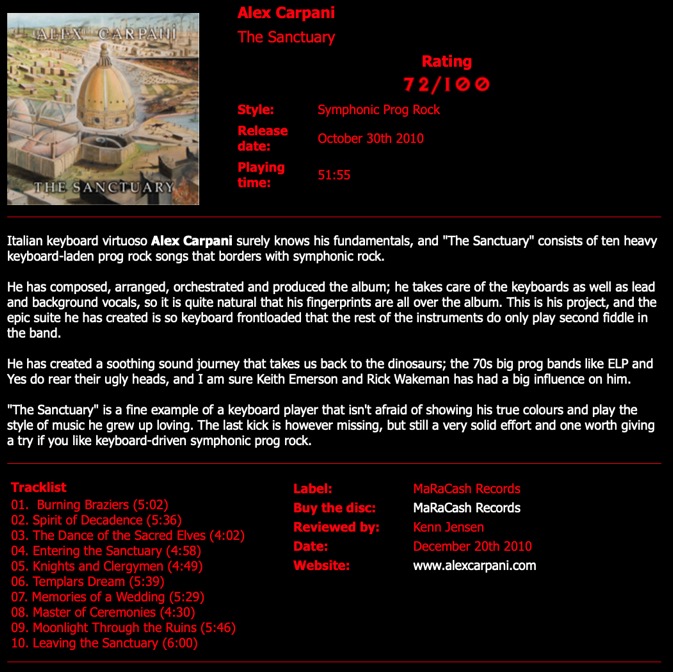
Italian keyboard virtuoso Alex Carpani surely knows his fundamentals, and "The Sanctuary" consists of ten heavy keyboard-laden prog rock songs that borders with symphonic rock. He has composed, arranged, orchestrated and produced the album; he takes care of the keyboards as well as lead and background vocals, so it is quite natural that his fingerprints are all over the album. This is his project, and the epic suite he has created is so keyboard frontloaded that the rest of the instruments do only play second fiddle in the band. He has created a soothing sound journey that takes us back to the dinosaurs; the 70s big prog bands like ELP and Yes do rear their ugly heads, and I am sure Keith Emerson and Rick Wakeman has had a big influence on him. "The Sanctuary" is a fine example of a keyboard player that isn't afraid of showing his true colours and play the style of music he grew up loving. The last kick is however missing, but still a very solid effort and one worth giving a try if you like keyboard-driven symphonic prog rock. 72/100
No. 13
MANTICORNIO (MEXICO)
http://www.manticornio.com/rock-progresivo/C/CARPANI-Alex/scanctuary.php
by Alfredo Tapia Carreto
El álbum oficial de estudio #2 de Alex CARPANI (teclados, canto) —músico italiano quien se acompaña en esta realización con Fabiano SPIGA (bajo), Marco FABBRI (batería) y Ettore SALATI (guitarras, pedales)— es una muestra del avance progresivo que un artista comprometido con la calidad es capaz de lograr, gracias a un impresionante portafolios estilístico. Como ya debes saber*, CARPANI se ha desarrollado en varios ámbitos musicales, enfocándose a la música rock progresiva desde mediados del decenio del 2000 y proyectando esta faceta por primera vez con su álbum "Waterline", concepto muy bien recibido en los circuitos progresivos. A tres años de aquél, su progresivo clásico sinfónico se exalta en un nuevo CD, el que te presento aquí. "The Sanctuary" «El Santuario» es uno de esos discos de rock progresivo-progresivo, bien educado como el qué más. Su estilo es tan ortodoxo que uno no puede dejar de hallar similitudes en bandotas como The NICE o ELP, gracias sobre todo al incisivo timbre de teclados análogos. El canto no es precisamente lo mejor aquí, pero al menos no se abusa de él y su presencia no lastima el tímpano como ocurre a veces con músicos prodigio, reflejando en cambio la buena tradición mediterránea. "The Sanctury" es un álbum para quien le gusta el progresivo clásico sinfónico sin desviaciones, solaz de quien prefiere el timbre itálico. Enhorabuena, Alex, y éxito con tu nominación al Mejor Álbum Italiano en los Prog Awards. Apreciaciòn personal de l'àlbum: 8+/10
No. 14
RAGAZZI MUSIC (GERMANY)
http://www.ragazzi-music.de/alexcarpani10.html
by Volkmar Mantei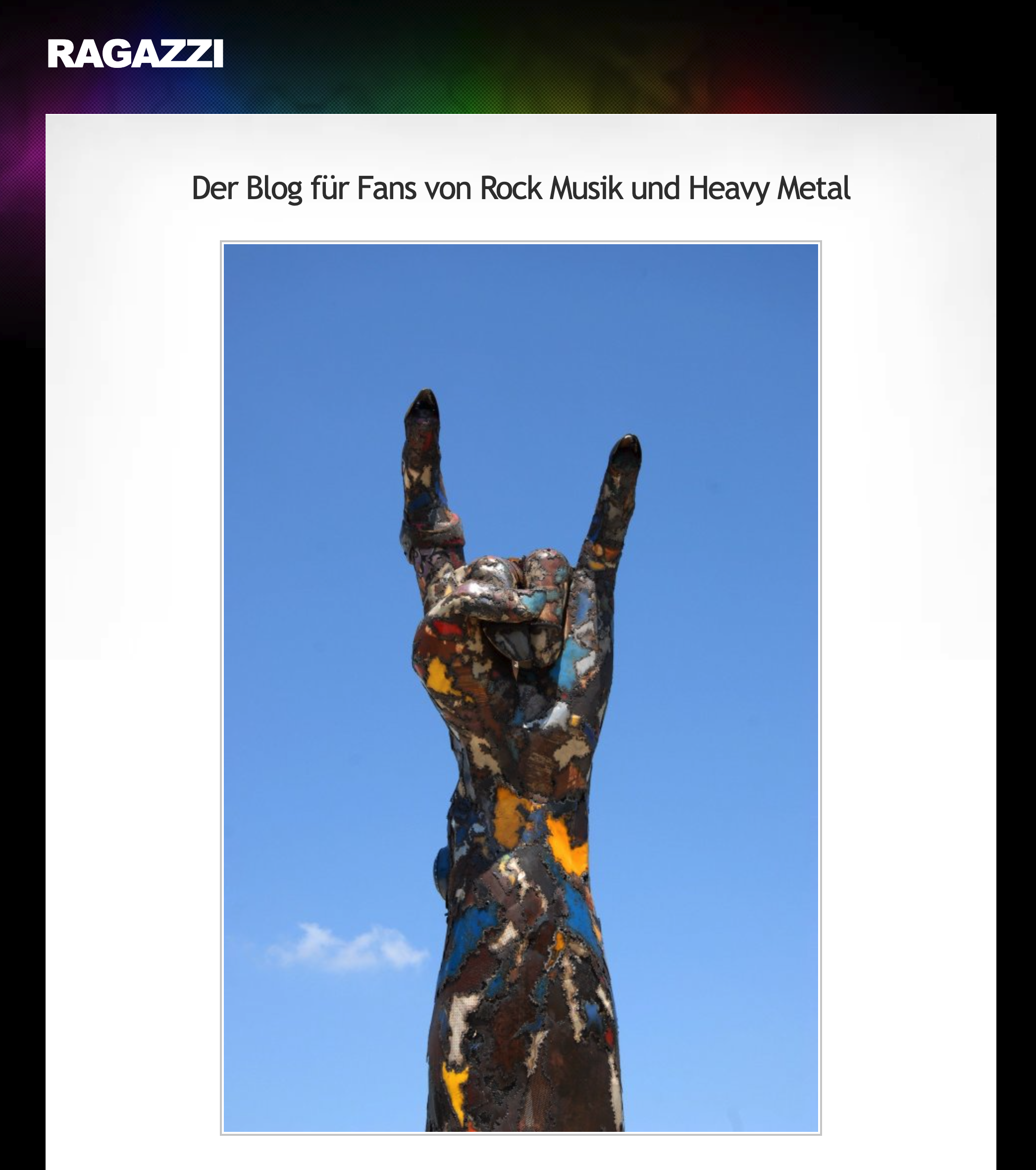
Der Begriff 'progressiv' ist in der Rockmusik in den letzten Jahren geradezu explodiert, da ist längst wieder Marktpotential, so wird alles damit verbunden, was sich in irgendeiner Form damit verkaufen lässt. Das dehnt und verändert die Begrifflichkeit - und auch wenn Schubladen eher Spaß als Orientierung sind - hat ein Jeder in sich so seine Vorstellungen seiner Musik, und einen Namen dafür. Alex Carpani sorgt mit "The Sanctuary" nach "Waterline" (2007) erneut dafür, dass der Begriff ‚progressiv' an seine Wurzeln reicht. Feinster, verspielter, symphonisch-komplexer Progressive Rock, facettenreich, lyrisch, druckvoll, mal bombastisch, mal melancholisch, hier nostalgisch, dort verzückt, hier malerisch herbstlich, dort närrisch sommerlich, in unendlichen Klangfarben und von großem Schöngeist - so sind die 10 Stücke seines neuen Albums. Die Alex Carpani Band besteht neben Alex (voc, keys) aus Ettore Salati (g), Fabiano Spiga (b) und Marco Fabbri (dr) sowie Giacomo Pacini (dr) - eingespielt wurden die Stücke jedoch von Schlagzeuger Gigi Cavalli Cocchi - alle Musiker sind illustre Techniker, die Songs lebhaft und dynamisch; flott und rasant fließen die Stücke dahin, in allen auch düsteren Komplexen von geradezu fröhlich-forscher Lebendigkeit, stets eher licht und verspielt als nachdenklich, unglaublich romantisch und von schwebenden, aber vollen Keyboardsounds transportiert. Alex Carpani steht ganz in der italienischen Progressive Rock Tradition, seine Themen sind lebensfroh und forsch, weniger kopflastig als eher ein Stück machohaft in der stolzen Handschrift und in aller sensiblen Lyrik von starker Gefühlswallung. Wo eben noch ein schweres Orgelmotiv eine instrumentale Note beherrschte, drückt nun viel dichteres, schwereres Mellotron sich über die Orgel, bombastisch erhaben dröhnt der Song, bis die Schwere einbricht und kindlich verspielte Lyrik sanft und zart fort fließt. Alex Carpani legt keinen Wert darauf, tagesaktuell zu klingen, was den Songs nur gut tut. So wird nichts vermischt, was der Zuhörer und geneigte Fan nicht vermischt haben will. Carpani erweist sich als großer Fan der alten Rock Progressive Italiano Schule und er tut alles und alles sehr gut, diese alte Schule in seiner Musik virtuos fortzuführen. Trotz aller Reminiszenzen ist das Album originell und eigenständig, wird keine Band, kein Vorbild kopiert, ist Alex Carpanis Handschrift stets deutlich und kraftvoll. Meine Empfehlung!
No. 15
PROG GNOSIS (U.S.A.)
http://www.proggnosis.com/PGRelease.asp?RID=33626
by Ron Vermulst
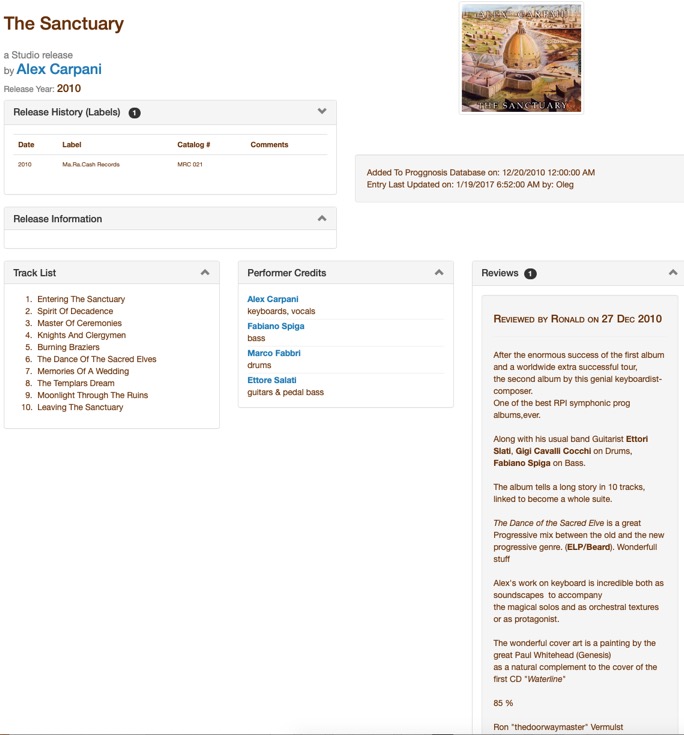
After the enormous success of the first album and a worldwide extra successful tour, the second album by this genial keyboardist-composer. One of the best RPI symphonic prog albums, ever. Along with his usual band Guitarist Ettori Slati, Gigi Cavalli Cocchi on Drums, Fabiano Spiga on Bass. The album tells a long story in 10 tracks, linked to become a whole suite. The Dance of the Sacred Elve is a great Progressive mix between the old and the new progressive genre. (ELP/Beard). Wonderfull stuff.
Alex's work on keyboard is incredible both as soundscapes to accompany the magical solos and as orchestral textures or as protagonist. The wonderful cover art is a painting by the great Paul Whitehead (Genesis) as a natural complement to the cover of the first CD "Waterline”. 85/100
No. 16
PROFIL JIMDO (FRANCE)
http://profil.jimdo.com/descriptions-d-albums-reviews/
by the staff
Pour son deuxième album, Alex CARPANI, toujours bien entouré, nous ouvre les portes d'un Progressif 70's symphonique et contrasté. Claviers en tous genres, guitares Génesissiennes, ambiances orchestrales, "The Sanctuary" tient toutes les promesses engagées avec "Waterline" il y a 3 ans. On y retient certes un esprit italien évoquant LE ORME, The WATCH ou PFM. Et bien sûr Paul Whitehead a conçu la pochette! Notons qu'enfin, la qualité du son, qui pouvait parfois gêner sur le 1er album, fait partie dorénavant des points forts.
No. 17
LORDS OF METAL (THE NETHERLANDS)
http://www.lordsofmetal.nl/showreview.php?id=17881&lang=en
by Hans Dehing
This story is mainly addressed at the historians and archaeologists among you. Carpani’s offering is, shall we say, altmodic (the lover of the genre may read “vintage” instead). No no, all the songs are freshly penned but they do find their origin in times long gone by. Alex has no problem with letting us know, that in former times everything was better. It might help if I told you that Alex Carpani is a keyboard player by trade. And this leads seamlessly to the Tony Bankses en Keith Emersons of the progworld, heroes-wise. See, this information makes it easy to create a frame of reference. The fore mentioned men (Banks and Emerson) are becoming a little rusty in the paws so there is no harm in musing about the future. Carpani keeps all his options open so he can function as cultural heir to whoever succumbs first. The song ‘The Dance Of The Sacred Elves’ reminds of Emerson, Lake & Palmer so much, that it gave me the creeps. I, as a fan of that group, do not really mind that likeness, but with that it has to be said that remakes are rarely as good as the original and that the book is almost always better, too. And looking at the other eminence grise we can safely conclude that Carpani can easily take over, should Banks end up in a box, six feet under. And again, the likeness is eerie. Oh, apart from the vocals, that is. Because, whose voice is more hoarse, than Peter Gabriel’s, back in the day. Exactly, no one’s. But hey, you as a lover of the genre (or as an old hippie, if you will) are likely to come to good terms with this album. The blueprints are so much high-profile, though, that copying is almost pointless. I could very well understand if a sigh of “let me just play ‘Selling England By The Pound’ again” escaped your lips. It happened to me too. Rating: 68/100
No. 18
STEREO INVADERS (ITALY)
http://www.stereoinvaders.com/index.php?option=com_content&view=article&catid=1:cd&id=4596:alex-carpani-the-sanctuary-&Itemid=16
by Thiess
Seconda uscita discografica per il Rock Progressivo di Alex Carpani, tastierista che si avvicina, a livello attitudinale, ai mostri sacri Genesis ed Emerson Lake & Palmer. Il sound dell’Italico artista si affaccia poi a toni orchestrali che, per sfumature e raffinatezza, si accostano ad Ennio Morricone. Detto questo, “The Sanctuary” è un connubio sfavillante di sacralità e riflessi di sole in un pindarico vetro dalla moltitudine di colori. Tecnicamente nulla da eccepire, full-lenght prettamente strumentale che non annoia, rapendo indubbiamente l’attenzione. Il viaggio tra maestose mura si fa sempre più emozionante via via che la curiosità viene stimolata dalle mille note prodotte. Zampilli di una fontana dall’acqua sorgiva, cielo limpido da cui scendiamo in picchiata attraversando vie ricolme di storia e persone. Il lavoro in questione ci riporta indietro nel tempo, così da far un balzo nel passato agli albori del genere, diventando un Art-Rock dai retrogusti raffinatissimi e precisi. Tutto perfetto, ma cosa manca? Beh, forse manca un po’ di personalità, perché i canoni del Progressive sono fin troppo rispettati e sostanzialmente, di nuovo, non c’è nulla. Questo neo, però, non offusca la luce di un disco solare ed ineccepibile artisticamente, capace di incidere ed emozionare con la propria sensibilità.
No. 19
PROGRESSIA (FRANCE)
http://www.progressia.net/chroniques/2915-alex-carpani-the-sanctuary
by Jérome Walczak
Après Waterline, son précédent disque ouvertement marqué par les années soixante-dix et sur lequel les influences d'ELP et de Genesis étaient légions, le Franco-Italien, encouragé par un succès critique mérité, récidive avec un entêtement qu'il est bon de souligner. L'artiste continue ainsi d'assumer totalement la filiation directe évoquée et ne s'encombre pas d'esbroufes techniques qui seraient de simples prétextes pour faire moderne. Si le chant sur son précédent album laissait à désirer, l'écueil est ici très simplement contourné puisqu'il assume désormais lui-même la totalité des parties vocales. Avec à ses côtés le batteur Gigi Cavalli Cocchide (Mangalla Vallis), le guitariste Ettore Salati qui officia un temps avec The Watch et Fabiano Spiga à la basse, l'ensemble tient la route tout en bénéficiant d'une production très honorable. Finalement, loin d'être original par son attachement bien trop prononcé à ELP et leur Brain Salad Surgery (« Burning Braziers », « The Dance of the Sacred Elves »), il reste émouvant de constater que presque quarante ans après, ce style réussit encore à faire mouche en termes d'émotions. Un petit anachronisme réussi, qui saura trouver son public et qu'il est sympathique de soutenir. 6/10
No. 20
PROGRESSIVE AREA (FRANCE)
http://www.progressive-area.com/index.php?option=com_content&task=view&id=1807&Itemid=2
by Mick Rogers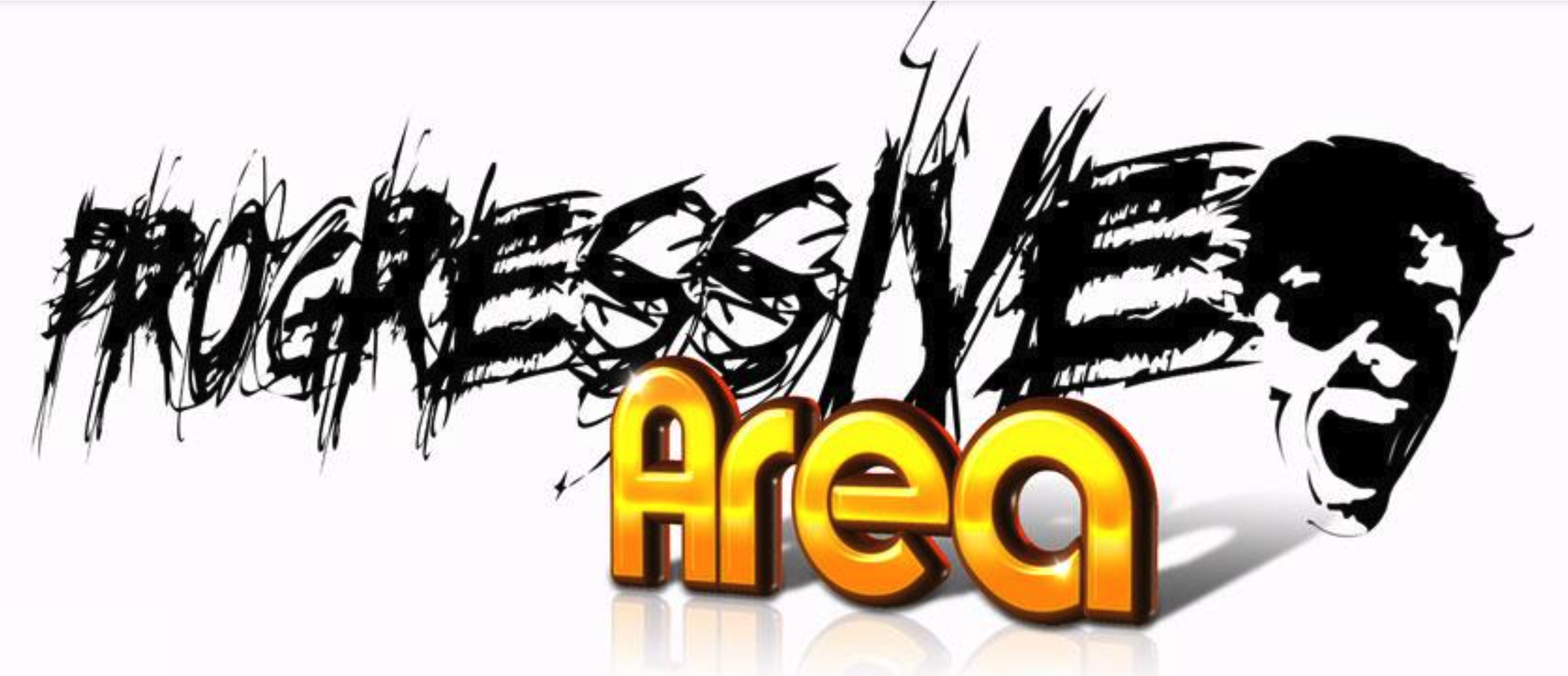
Après le grand succès de son premier album "Waterline", rapporté au monde du progressif bien sur, Alex CARPANI nous revient avec "The sanctuary" sous la houlette iconographique de Paul "Genesis" WHITEHEAD.
Si dans "Waterline" Alex avait bénéficié du concours d'Aldo TAGLIAPIETRA, cette fois ci il accueille dans son équipe Gigi Cavalli COCCHI batteur chez MANGALA VALLIS et MOONGARDEN. Petit rappel génétique : Alex est né en Suisse d'un père italien et d'une mère française. Il a commencé à étudier la musique à l'âge de six ans (précoce le bougre) pour ensuite passer par l'université musicologique de Bologne et la réputée C.E.T, l'une des plus fameuses écoles de musique en Italie. Il tient probablement son amour pour le prog et surtout pour les claviers de sa rencontre avec Aaron EMERSON son camarade de classe en Suisse et fils de... oui oui... lui même !!!!! Il s'est spécialisé dans la musique de films et a reçu de nombreuses récompenses dans le monde entier. Il arrive dans notre petit monde du rock progressif avec un très solide bagage musical après avoir formé un duo au début des années quatre vingt dix appelé GEMINI, également après avoir travaillé avec entre autres MOGOL, l'un des plus célèbres compositeurs italiens de l'époque. Pour "The sanctuary" il a fait relativement simple puisque l'opus présente dix titres de durée proche (entre quatre et six minutes) la moitié sont instrumentaux et l'autre chantée mais sans exagération. Le titre introductif "Burning Braziers" est l'un de mes préférés avec bien sur une hégémonie des claviers à tendance filmographie (normal compte tenu de ce qui a été mentionné plus haut). "Spirit of Decadence", après une délicate introduction pianistique, s'envole vers des sphères plus énergiques avant un retour vocalisé et orchestral plus soft - très beau titre également. La patte emersonienne se retrouve dans "The Dance of Sacred Elves" instrumental à la manière filmographique encore dans sa partie centrale et un final qui crachote comme un bon vieux vinyle. "Entering The Sanctuary" nous offre quelques incursions incisives d'Ettore SALATI sur les claviers jouissifs du maitre de cérémonie. J'apprécie un peu moins le chant d'Alex sauf dans la partie finale où il fait référence à Aldo TAGLIAPIETRA. Pas de chant pour "Knights & Clergymen", le titre où la section rythmique est le mieux mise en valeur sur l'ensemble du cd, peut être à égalité avec "Templars Dream", le morceau suivant, ce dernier bénéficiant en outre d'interventions guitaristiques de bon niveau et toujours sous le feu des touches d'Alex CARPANI - écoutez bien les sonorités de moog un vrai régal !!! On s'y croirait... où çà ?... à un mariage... dans l'introduction du septième titre où la guitare d'Ettore fait des merveilles et les variations claviéristiques du "patron" nous emporte dans un impalpable tourbillon. "Master of Ceremonies" est sous influence pianistique essentiellement avec un superbe solo du six cordiste une petite minute avant le terme où Ettore SALATI nous la fait à l'hispanique. "Moonlight Through The Ruins" est le titre le plus progressif selon moi, le plus inspiré seventies en tout cas, le plus genesissien. Les claviers sont banksiens comme ce n'est pas permis et les guitares hacketiennes en diable. Bon là c'est plus que de l'inspiration !!! "Leaving The Sanctuary", le titre conclusif symbolise un retour vers des rivages emersoniens sans les excès de Keith. C’est le plus long du disque, purement instrumental, agréable sans être génial. Pour conclure nous avons affaire à un bon disque de rock progressif italien malgré un chant plutôt moyen et des transitions quelque peu abruptes entre les morceaux. A consommer mais sans excès ! Surtout en période de fêtes...
No. 21
INFORMAZIONE METAL (ITALY)
http://informazionemetal.blogspot.com/2011/01/alex-carpani-sanctuary.html
by Salvatore Mazzarella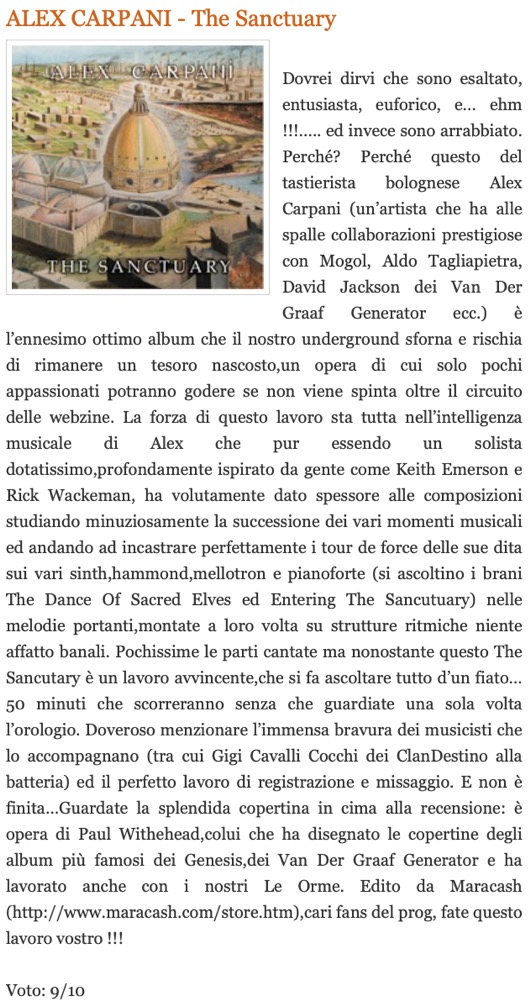
Dovrei dirvi che sono esaltato, entusiasta, euforico, e... ehm !!!..... ed invece sono arrabbiato. Perché? Perché questo del tastierista bolognese Alex Carpani (un’artista che ha alle spalle collaborazioni prestigiose con Mogol, Aldo Tagliapietra, David Jackson dei Van Der Graaf Generator ecc.) è l’ennesimo ottimo album che il nostro underground sforna e rischia di rimanere un tesoro nascosto,un opera di cui solo pochi appassionati potranno godere se non viene spinta oltre il circuito delle webzine. La forza di questo lavoro sta tutta nell’intelligenza musicale di Alex che pur essendo un solista dotatissimo,profondamente ispirato da gente come Keith Emerson e Rick Wackeman, ha volutamente dato spessore alle composizioni studiando minuziosamente la successione dei vari momenti musicali ed andando ad incastrare perfettamente i tour de force delle sue dita sui vari sinth,hammond,mellotron e pianoforte (si ascoltino i brani The Dance Of Sacred Elves ed Entering The Sancutuary) nelle melodie portanti,montate a loro volta su strutture ritmiche niente affatto banali. Pochissime le parti cantate ma nonostante questo The Sancutary è un lavoro avvincente,che si fa ascoltare tutto d’un fiato…50 minuti che scorreranno senza che guardiate una sola volta l’orologio. Doveroso menzionare l’immensa bravura dei musicisti che lo accompagnano (tra cui Gigi Cavalli Cocchi dei ClanDestino alla batteria) ed il perfetto lavoro di registrazione e missaggio. E non è finita…Guardate la splendida copertina in cima alla recensione: è opera di Paul Withehead,colui che ha disegnato le copertine degli album più famosi dei Genesis,dei Van Der Graaf Generator e ha lavorato anche con i nostri Le Orme. Edito da Maracash (http://www.maracash.com/store.htm), cari fans del prog, fate questo lavoro vostro !!!
No. 22
ARLEQUINS (ITALY)
http://www.arlequins.it/pagine/articoli/alfa/corpo.asp?ch=4598
by Jessica Attene
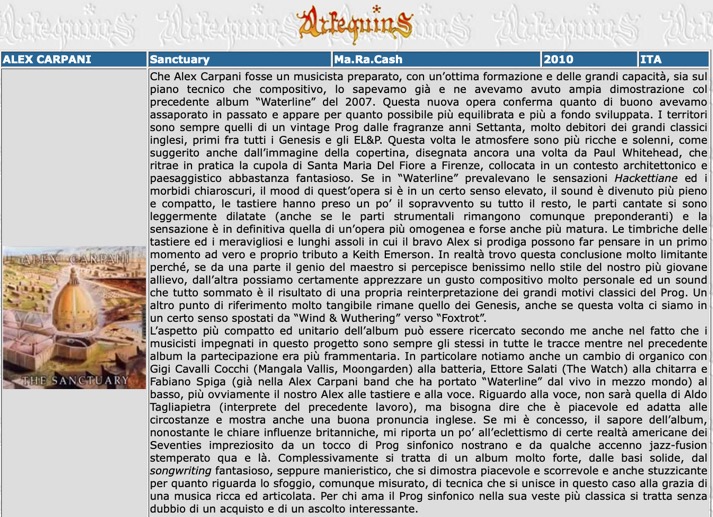
Che Alex Carpani fosse un musicista preparato, con un’ottima formazione e delle grandi capacità, sia sul piano tecnico che compositivo, lo sapevamo già e ne avevamo avuto ampia dimostrazione col precedente album “Waterline” del 2007. Questa nuova opera conferma quanto di buono avevamo assaporato in passato e appare per quanto possibile più equilibrata e più a fondo sviluppata. I territori sono sempre quelli di un vintage Prog dalle fragranze anni Settanta, molto debitori dei grandi classici inglesi, primi fra tutti i Genesis e gli EL&P. Questa volta le atmosfere sono più ricche e solenni, come suggerito anche dall’immagine della copertina, disegnata ancora una volta da Paul Whitehead, che ritrae in pratica la cupola di Santa Maria Del Fiore a Firenze, collocata in un contesto architettonico e paesaggistico abbastanza fantasioso. Se in “Waterline” prevalevano le sensazioni Hackettiane ed i morbidi chiaroscuri, il mood di quest’opera si è in un certo senso elevato, il sound è divenuto più pieno e compatto, le tastiere hanno preso un po’ il sopravvento su tutto il resto, le parti cantate si sono leggermente dilatate (anche se le parti strumentali rimangono comunque preponderanti) e la sensazione è in definitiva quella di un’opera più omogenea e forse anche più matura. Le timbriche delle tastiere ed i meravigliosi e lunghi assoli in cui il bravo Alex si prodiga possono far pensare in un primo momento ad vero e proprio tributo a Keith Emerson. In realtà trovo questa conclusione molto limitante perché, se da una parte il genio del maestro si percepisce benissimo nello stile del nostro più giovane allievo, dall’altra possiamo certamente apprezzare un gusto compositivo molto personale ed un sound che tutto sommato è il risultato di una propria reinterpretazione dei grandi motivi classici del Prog. Un altro punto di riferimento molto tangibile rimane quello dei Genesis, anche se questa volta ci siamo in un certo senso spostati da “Wind & Wuthering” verso “Foxtrot”. L’aspetto più compatto ed unitario dell’album può essere ricercato secondo me anche nel fatto che i musicisti impegnati in questo progetto sono sempre gli stessi in tutte le tracce mentre nel precedente album la partecipazione era più frammentaria. In particolare notiamo anche un cambio di organico con Gigi Cavalli Cocchi (Mangala Vallis, Moongarden) alla batteria, Ettore Salati (The Watch) alla chitarra e Fabiano Spiga (già nella Alex Carpani band che ha portato “Waterline” dal vivo in mezzo mondo) al basso, più ovviamente il nostro Alex alle tastiere e alla voce. Riguardo alla voce, non sarà quella di Aldo Tagliapietra (interprete del precedente lavoro), ma bisogna dire che è piacevole ed adatta alle circostanze e mostra anche una buona pronuncia inglese. Se mi è concesso, il sapore dell’album, nonostante le chiare influenze britanniche, mi riporta un po’ all’eclettismo di certe realtà americane dei Seventies impreziosito da un tocco di Prog sinfonico nostrano e da qualche accenno jazz-fusion stemperato qua e là. Complessivamente si tratta di un album molto forte, dalle basi solide, dal songwriting fantasioso, seppure manieristico, che si dimostra piacevole e scorrevole e anche stuzzicante per quanto riguarda lo sfoggio, comunque misurato, di tecnica che si unisce in questo caso alla grazia di una musica ricca ed articolata. Per chi ama il Prog sinfonico nella sua veste più classica si tratta senza dubbio di un acquisto e di un ascolto interessante.
No. 23
AMAROCK (FRANCE)
http://www.amarokprog.net/critiques_36429_31321.html
by Cyrille Delanlssays
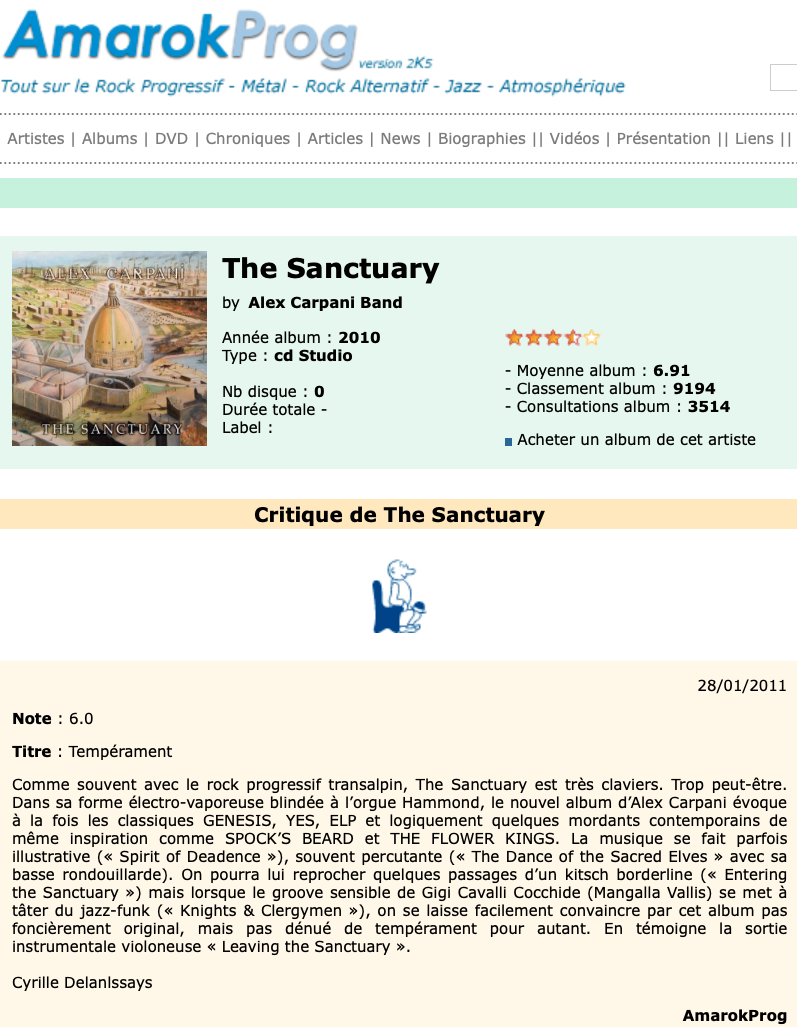
Comme souvent avec le rock progressif transalpin, The Sanctuary est très claviers. Trop peut-être. Dans sa forme électro-vaporeuse blindée à l’orgue Hammond, le nouvel album d’Alex Carpani évoque à la fois les classiques GENESIS, YES, ELP et logiquement quelques mordants contemporains de même inspiration comme SPOCK’S BEARD et THE FLOWER KINGS. La musique se fait parfois illustrative (« Spirit of Deadence »), souvent percutante (« The Dance of the Sacred Elves » avec sa basse rondouillarde). On pourra lui reprocher quelques passages d’un kitsch borderline (« Entering the Sanctuary ») mais lorsque le groove sensible de Gigi Cavalli Cocchide (Mangalla Vallis) se met à tâter du jazz-funk (« Knights & Clergymen »), on se laisse facilement convaincre par cet album pas foncièrement original, mais pas dénué de tempérament pour autant. En témoigne la sortie instrumentale violoneuse « Leaving the Sanctuary ».
No. 24
JUST FOR KICKS (GERMANY)
http://www.justforkicks.de/detail.asp?id=11630&sid=403102M62N78N197N62&uid=0&lid=2
by JFK Staff
Der Begriff 'progressiv' ist in der Rockmusik in den letzten Jahren geradezu explodiert, da ist längst wieder Marktpotential, so wird alles damit verbunden, was sich in irgendeiner Form damit verkaufen lässt. Das dehnt und verändert die Begrifflichkeit - und auch wenn Schubladen eher Spaß als Orientierung sind - hat ein Jeder in sich so seine Vorstellungen seiner Musik, und einen Namen dafür. Alex Carpani sorgt mit "The Sanctuary" nach "Waterline" (2007) erneut dafür, dass der Begriff ‚progressiv' an seine Wurzeln reicht. Feinster, verspielter, symphonisch-komplexer Progressive Rock, facettenreich, lyrisch, druckvoll, mal bombastisch, mal melancholisch, hier nostalgisch, dort verzückt, hier malerisch herbstlich, dort närrisch sommerlich, in unendlichen Klangfarben und von großem Schöngeist - so sind die 10 Stücke seines neuen Albums. (ragazzi music) After the enormously successful debut album, and an acclaimed tour that took Alex and his band to every corner of Europe, the brand new album from this genial composer-keyboardist is finally ready.
Tracklist:
01. Burning Braziers 5.02
02. Spirit Of Decadence 05.36
03. The Dance Of The Sacred Elves
4.02 04. Entering The Sanctuary 4.58
05. Knights And Clergymen 4.49
06. Templars Dream 5.39
07. Memories Of A Wedding 5.29
08. Master Of Ceremonies 04.30
09. Moonlight Through The Ruins 5.46
10. Leaving The Sanctuary 06.00
Artwork by Paul Whitehead
LineUp: Alex Carpani - lead and back vocals, keyboards Gigi Cavalli Cocchi - drums and percussion Ettore Salati - acoustic and electric guitars Fabiano Spiga - bass
No. 25
PROG LOG AFTERGLOW (THE NETHERLANDS)
http://progopinion.blogspot.com/2011/01/wat-een-week.html
by Harry 'JoJo' de Vries
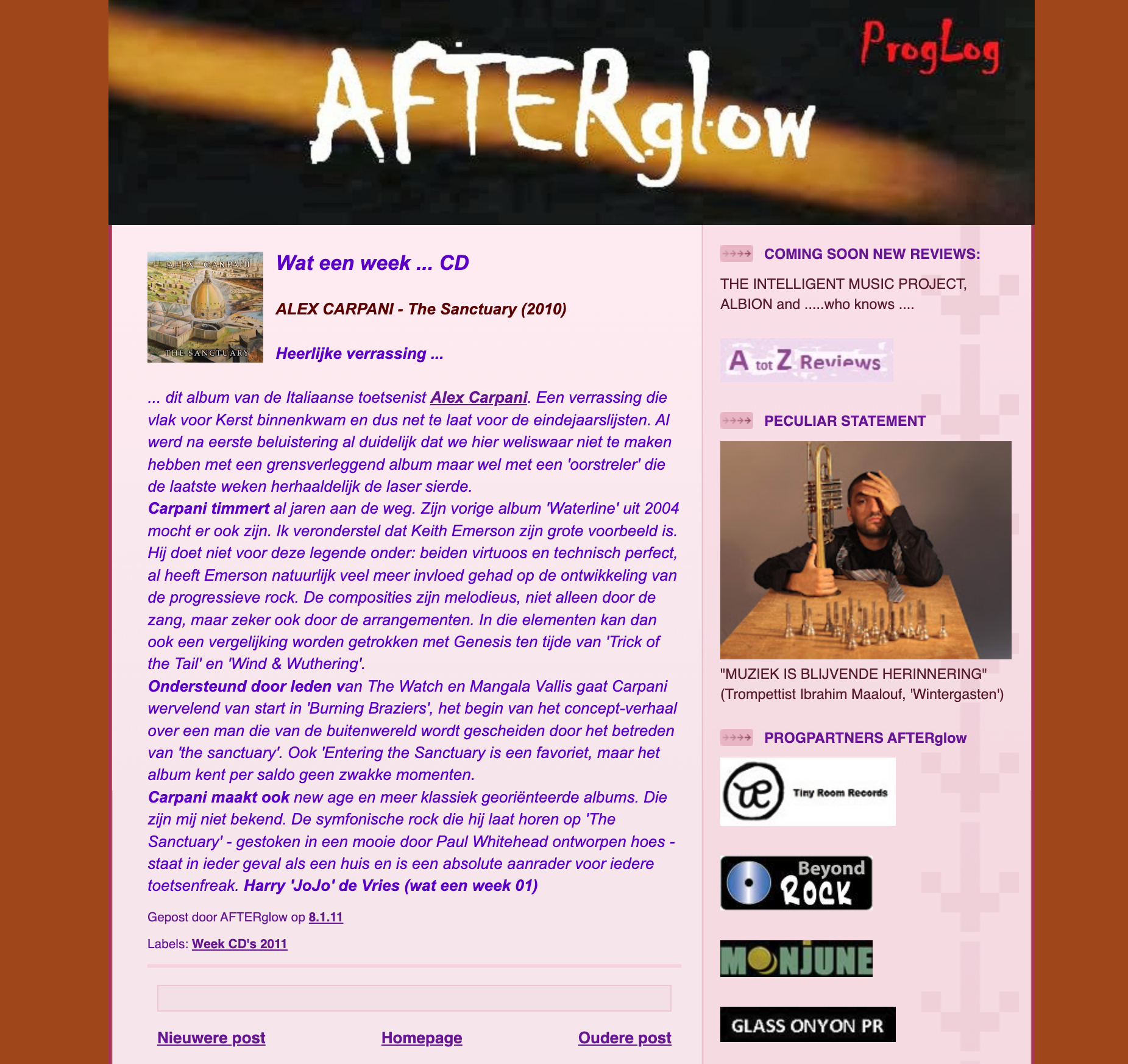
Heerlijke verrassing ...
... dit album van de Italiaanse toetsenist Alex Carpani. Een verrassing die vlak voor Kerst binnenkwam en dus net te laat voor de eindejaarslijsten. Al werd na eerste beluistering al duidelijk dat we hier weliswaar niet te maken hebben met een grensverleggend album maar wel met een 'oorstreler' die de laatste weken herhaaldelijk de laser sierde. Carpani timmert al jaren aan de weg. Zijn vorige album 'Waterline' uit 2004 mocht er ook zijn. Ik veronderstel dat Keith Emerson zijn grote voorbeeld is. Hij doet niet voor deze legende onder: beiden virtuoos en technisch perfect, al heeft Emerson natuurlijk veel meer invloed gehad op de ontwikkeling van de progressieve rock. De composities zijn melodieus, niet alleen door de zang, maar zeker ook door de arrangementen. In die elementen kan dan ook een vergelijking worden getrokken met Genesis ten tijde van 'Trick of the Tail' en 'Wind & Wuthering'. Ondersteund door leden van The Watch en Mangala Vallis gaat Carpani wervelend van start in 'Burning Braziers', het begin van het concept-verhaal over een man die van de buitenwereld wordt gescheiden door het betreden van 'the sanctuary'. Ook 'Entering the Sanctuary is een favoriet, maar het album kent per saldo geen zwakke momenten. Carpani maakt ook new age en meer klassiek georiënteerde albums. Die zijn mij niet bekend. De symfonische rock die hij laat horen op 'The Sanctuary' - gestoken in een mooie door Paul Whitehead ontworpen hoes - staat in ieder geval als een huis en is een absolute aanrader voor iedere toetsenfreak.
No. 26
PROG-MANIA (FRANCE)
http://www.prog-mania.com/index.php?file=Forum&page=viewtopic&forum_id=5&thread_id=2124
by 'alfa' (administrator)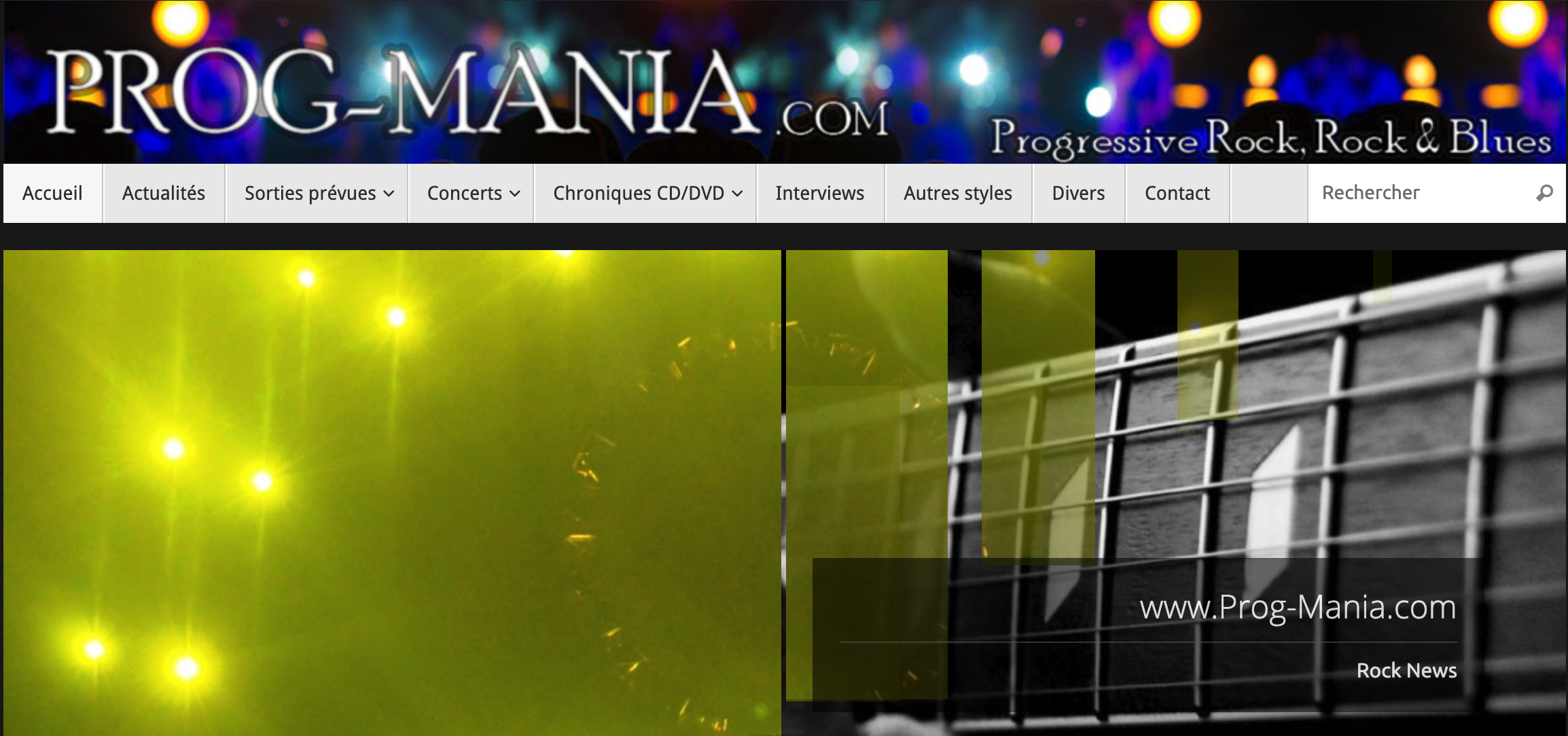
Alex Carpani avait fait une entrée tout à fait honorable dans le monde Prog’ classique années 70’ avec son 1er album « Waterline », sorti en 2007. Dans les points notables à évoquer pour ce nouvel album, il faut parler du chant qui est pris en main d’une manière plutôt réussie par Alex Carpani, ainsi que de très nombreuses parties de claviers, et d'une production dont la qualité a fait de nets progrès pour devenir excellente. La musique de Alex Carpani lorgne toujours vers les années 70’ – les années « Selling England By The Pound » de Genesis, par exemple. Cependant de nombreuses touches de modernité et d’originalité apparaissent ici et là, ce qui fait que cet album n'est pas en déphasage avec notre 3ème millénaire. Alex Carpani a trouvé l’équilibre et l’alchimie qui permettra aux amateurs de ce style de musique qui a bientôt 40 ans, de se replonger dans un passé riche en émotions et de le faire revivre, sans tomber (loin de là) dans le désuet. 16/20
No. 27
ATHOS ENRILE'S MUSIC BLOG (ITALY)
http://athosenrile.blogspot.com/2011/02/alex-carpani-sanctuary.html
by Athos Enrile

Senza scomodare teorie filosofiche legate ai “corsi e ricorsi storici”, tutto ciò che è stato accantonato per far posto al “nuovo” e alla necessità di progredire, prima o poi ritorna, mascherato anch’esso da nuovo, ma immutato nella sostanza.
Vale nella moda, nella politica, in ogni aspetto della vita culturale, e quindi nella musica. Se abbiamo tempo di aspettare, se abbiamo la fortuna di avere lunga vita, la ruota in movimento ci riporterà cose già vissute, alcune positive, altre un po’ meno, e… se avessi tenuto nel cassetto le mie scarpe a punta e i pantaloni scampanati da adolescente, forma fisica a parte, li avrei potuti riutilizzati dopo qualche lustro, dimenticando la mia età, anch’essa in movimento. Certa musica è stata messa in un angolo troppo velocemente, ma… la qualità paga. Volendo giocare sul significato letterale di “musica prog”, si potrebbe dire che la dinamicità, l’esigenza della progressione, hanno portato ad una veloce evoluzione del genere, sino alla dichiarazione di “morte avvenuta”.
E ora siamo nuovamente davanti al fenomeno della musica “New Prog”, che non potrà avere il successo del prototipo, perché il mondo è cambiato, e in questo caso direi… purtroppo. Ma la qualità non ha niente a che vedere con la musica che ci viene propinata ogni giorno dai “circuiti ufficiali”; mi riferisco a quel concetto che emerge nel corso dell’intervista con Alex Carpani, quando si arriva a delineare l’immagine di “immortalità della musica”, quello che da sempre io appiccico alla “Prog Music”.
Una lunga premessa la mia, perché davanti all’argomento “musicacheamo”, divento prolisso e logorroico, così come mi ammutolisco davanti alla costruzione ad hoc fatta per il pubblico che compra.
“The Sanctuary”, nuovo disco di Alex Carpani, è un capolavoro e di questo non ho dubbi. Esagero? Un capolavoro secondo i miei canoni, secondo il mio metro di giudizio, che è quello di un uomo influenzato dal vissuto, da tutta la musica, una certa musica, vista ed ascoltata nel momento in cui essa nasceva. Nella vita accadono spesso episodi che riusciranno a condizionarla, anche se sul momento non appaiono fondamentali. Alex, per sua stessa ammissione è stato “fulminato sulla via di Damasco” da un incontro avvenuto da bambino, in Svizzera, quello con Keith Emerson, e questo spiega molto a chi ascolta attentamente la musica di Carpani. Spiacevoli, a volte, le citazioni e i paragoni, ma ho trovato nell’album una miscela micidiale, che per gli addetti ai lavori si può semplificare con “l’unione tra la genialità di ELP e le soluzioni armoniche stile Genesis”. Dieci brani che costituiscono una suite, dieci "episodi" composti, arrangiati, orchestrati, prodotti da Carpani, con un risultato davvero sorprendente.
Ho trovato “il vocal” di Alex “caratterizzante”. Forse cantare è per lui un fatto contingente più che una passione, ma fornire un tocco personale e distintivo vale milioni di volte di più di standardizzati esercizi di estensione e potenza. Le tastiere sono ovviamente alla base di questo “The Sanctuary”. Sin dal primo ascolto (fondamentale per me), ho avuto sentore di qualcosa di nuovo, che passa attraverso la grande tecnica e la genialità di Carpani, seguendo certamente linee guida stilate da alcuni miti di inizio anni ’70, ma la freschezza e l’originalità delle soluzioni proposte rendono di fatto il disco come “unico”. Alex Carpani si è avvalso della collaborazione di Gigi Cavalli Cocchi ala batteria e percussioni, Ettore Salati alle chitarre e Fabiano Spiga al basso.
Da evidenziare la copertina realizzata dal mitico Paul Whitehead, in una sorta di filo conduttore che lega il passato al presente. Il mio piccolo contributo alla causa della buona musica è la condivisione, cosa che perseguo quotidianamente. “The Sanctuary” avrà senza dubbio un posto di privilegio nella mia azione di diffusione capillare.
No. 28
ARTISTS AND BANDS (ITALY)
http://www.artistsandbands.org/ita/modules/recensioni/detailfile.php?lid=2200
by Eric G. Laterza
Comincio ad ascoltare The Sanctuary e all’improvviso parte un flashback: sono nella casa di un compagno di quinta elementare, lo seguo nella stanza del fratello maggiore, dove, su alcune mensole, è ordinatamente conservata una impressionante collezione di 33 giri, il mio amico sfila dal secondo ripiano una copertina color crema con impresse strane figure, apre l’album, prende con accortezza il nero vinile dalla busta interna e lo posa sul piatto di un giradischi dal coperchio in plastica fumé, appena la puntina affonda nei primi solchi si diffonde una musica magica… Oggi The Sanctuary rinnova quella antica magia ed il merito va tutto ad Alex Carpani che ha concepito un’opera d’arte (e questa definizione non è esagerata), curandone anche arrangiamenti, orchestrazioni e produzione. Questo artista italiano ha un curriculum da far impallidire qualsiasi musicista, avendo composto ed inciso oltre trenta dischi, nei quali ha affrontato generi differenti: electro-jazz, acid-jazz, jazz-rock, musica ispirata ai testi di alcuni importanti poeti contemporanei (Sanguineti e Finardi), musica ambient, new age, elettronica (utilizzando la sigla al.en.ca., acronimo di Alex Enrico Càrpani), colonne sonore per spettacoli teatrali e soprattutto rock progressivo. L’amore verso la musica progressive e la passione per le tastiere cresce anche a seguito dell’incontro (avvenuto quando Alex aveva 7 anni) con Keith Emerson, nel periodo in cui il tastierista inglese accompagnava il proprio figlio Aaron nel collegio gestito dai genitori di Alex in Svizzera. Progressive era anche il precedente Waterline del 2007, concept album sul tema del “pelo dell'acqua”, al quale aveva collaborato, per le parti vocali, Aldo Tagliapietra delle Orme. Per eseguire dal vivo in Italia e all'estero i brani tratti da Waterline si forma la Alex Carpani Band (ACB), che nel tempo è divenuta una delle realtà più significative della nuova scena progressive italiana. Sul finire del 2010 viene dunque pubblicato The Sanctuary, dove, ad accompagnare Alex, troviamo Ettore Salati, Fabiano Spiga (rispettivamente chitarrista e bassista della ACB) e Gigi Cavalli Cocchi (già batterista con Mangala Vallis, Moongarden e Clan Destino, band del primo Ligabue). La copertina è stata realizzata da Paul Whitehead (già autore delle cover di Nursery Cryme e Foxtrot dei Genesis, Pawn Hearts dei Van der Graaf Generator e Smogmagica de Le Orme) e rappresenta un uomo disteso, come in un sarcofago, all’interno di un santuario (per inciso, la cupola del dipinto rievoca quella di Santa Maria del Fiore del Brunelleschi). L’idea suggerita dalla copertina è quella di un uomo recluso nel santuario ed isolato dal mondo esterno, l’immagine può celare vari significati e/o metafore, per immediata associazione viene da pensare all’Uomo (inteso come genere umano) oppresso dalle regole e dalle convenzioni e schiavo dei giudizi e condizionamenti esterni o, forse, allo Spirito (nel senso di Anima) prigioniero del corpo e quindi al ciclo della Vita stessa nel suo svolgersi “nascita – esistenza – morte” (come sembrerebbero suggerire i titoli dei brani “Entering the Sanctuary” e “Leaving the Sanctuary”). Al di là di quelli che posso essere i significati reconditi (effettivi o presunti), ci troviamo comunque davanti ad un’unica storia, musicata come una lunga suite anche se suddivisa in dieci brani, quasi tutti interamente strumentali, dove le sporadiche parti cantate sono utili alla narrazione. Tutto il disco è un caleidoscopio di colori, suoni, immagini e sensazioni. “Burning Braziers” inizia con una atmosfera liquida rotta dall’ingresso di basso, tastiere e batteria, ed è quasi possibile vedere il fumo e respirare odore di incenso; “Spirit of Decadence” comincia con un pianoforte romantico e termina con un coro femminile alla Ennio Morricone. In “The Dance of the Sacred Elves”, l’immagine di folletti impazziti appare davanti ai nostri occhi. “Entering the Sanctuary”, con una chitarra lievemente distorta, una fine punteggiatura di basso e una giostra di tastiere, è un vero omaggio ai Genesis. “Knights and Clergymen”, in un alternarsi di momenti incalzanti e passaggi più riflessivi, ci regala un assolo di hammond da manuale. In “Templars Dream” il frammento di piano è suonato alla maniera di Keith Emerson e la chitarra solista ricama splendide note sotto il cantato; “Memories of a Wedding” è un brano stupendo, emozionale, pulsante, introdotto da un pianoforte appassionato e con vari inserimenti del moog dove risalta l’uso del “pitch bending”. Segue “Masters of Ceremonies”, con la sua atmosfera da colonna sonora e la chitarra solista che si tuffa in un flamenco finale. L’arpeggio sognante di “Moonlight through the Ruins” è vera poesia, mentre “Leaving the Sanctuary”, brano magniloquente, con una bella orchestrazione, una batteria scoppiettante e uno splendido crescendo posto a circa tre quarti del brano, è il degno sigillo ad un lavoro strepitoso. Grande musica, senza ombra di dubbio. Le partiture sono complesse, ma tutto scorre in modo fluido e limpido. Il tocco del “genio” sta proprio in questo: far sembrare semplice e lineare una struttura molto articolata. Basta, infatti, qualche ascolto per assimilare il tema portante che rende riconoscibile e memorizzabile ciascun brano. In tutto il disco dominano sintetizzatori, hammond, moog, pianoforte, non c’è un cedimento, non una nota fuori posto, la tecnica è sopraffina, è come se il talento di Wakeman, Emerson e Banks fosse confluito in un unico artista. Questo album è ARTE allo stato puro, per la perizia con cui è suonato e, soprattutto, per la sua capacità di rievocare sensazioni e suscitare profonde emozioni. Imperdibile per chi ama la Musica vera. … Spengo il lettore e sorrido per quel ricordo lontano riemerso in un flashback, liberato dalla prigione del tempo, per quella copertina color crema con impresse quelle strane figure …un’infermiera, un cacciatore, un brigante, una vecchina che si specchia in una fanciulla… e per le magiche note dei Genesis compresse nei solchi di A trick of the tail. 95/100
No. 29
iO PAGES (THE NETHERLANDS)
http://www.iopages.nl/indexuk.html
by Erik Neuteboom
Alex Carpani was born in the Swiss city Montreux in 1970 with an Italian father and a French mother. On his sixth he was taught organ, then piano and also writing compositions. The way he discovered progressive rock is very special: he was in the same class as the son of Keith Emerson named Aaron, at his home he got familiar with ELP and Alex loved it! In 1993 he released his first solo album entitled Hypothesis, followed by numerous projects including the very interesting CD Waterline in 2007 featuring Aldo Tagliapietra (Le Orme), Tony Spada (Holding Pattern) and Paul Whitehead (designer of the early Genesis LP’s). On his new solo album The Sanctuary, drummer Gigi Cavalli Cocchi (Mangala Vallis and Moongarden) and guitar player Ettore Salati (ex-The Watch and recently The RedZen and SoulenginE) are invited as guest musicians. Listening to the 10 compositions on The Sanctuary I was often carried away to Vintage Keyboard Heaven due to the sound of flashy Minimoog synthesizer flights, majestic Mellotron choirs, sparkling Grand piano and sumptuous Hammond organ (especially in the ELP inspired Templar’s Dream and swirling solo’s in Knights And Clergymen). Ettore Salati’s guitar work is in the shadow of the lush keyboards but he plays very tasteful and varied, from powerful riffs to flowing and sensitive runs with hints of Steve Hackett (like in Entering The Sanctuary). And in Master Of Ceremonies he delivers a captivating duel on flamenco guitar with Mellotron choirs, goose bumps! Some tracks contain English vocals, these sound decent but not on the level of the other instruments. I am sure that singing in their wonderful native language would have given these songs more emotional depth. Nonetheless, this new effort by Alex Carpani and his musical friends has turned into a very pleasant progrock experience with the focus on exciting vintage keyboards, recommended!
No. 30
TRUEMETAL.IT (ITALY)
http://www.truemetal.it/reviews.php?op=albumreview&id=9664
by Lorenzo Bacega
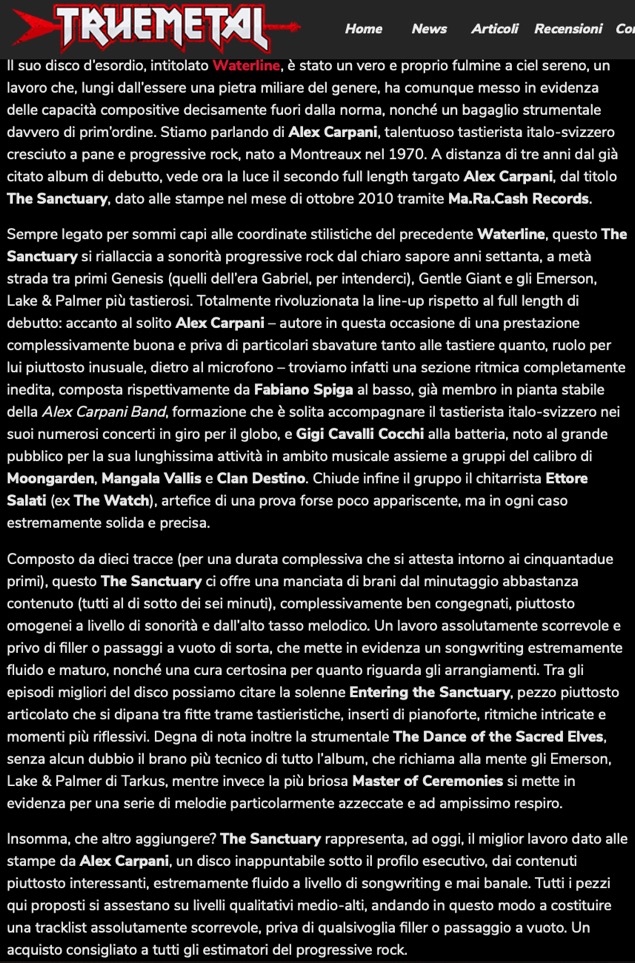
Il suo disco d'esordio, intitolato Waterline, è stato un vero e proprio fulmine a ciel sereno, un lavoro che, lungi dall'essere una pietra miliare del genere, ha comunque messo in evidenza delle capacità compositive decisamente fuori dalla norma, nonché un bagaglio strumentale davvero di prim'ordine. Stiamo parlando di Alex Carpani, talentuoso tastierista italo-svizzero cresciuto a pane e progressive rock, nato a Montreaux nel 1970. A distanza di tre anni dal già citato album di debutto, vede ora la luce il secondo full length targato Alex Carpani, dal titolo The Sanctuary, dato alle stampe nel mese di ottobre 2010 tramite Ma.Ra.Cash Records. Sempre legato per sommi capi alle coordinate stilistiche del precedente Waterline, questo The Sanctuary si riallaccia a sonorità progressive rock dal chiaro sapore anni settanta, a metà strada tra primi Genesis (quelli dell'era Gabriel, per intenderci), Gentle Giant e gli Emerson, Lake & Palmer più tastierosi. Totalmente rivoluzionata la line-up rispetto al full length di debutto: accanto al solito Alex Carpani – autore in questa occasione di una prestazione complessivamente buona e priva di particolari sbavature tanto alle tastiere quanto, ruolo per lui piuttosto inusuale, dietro al microfono – troviamo infatti una sezione ritmica completamente inedita, composta rispettivamente da Fabiano Spiga al basso, già membro in pianta stabile della Alex Carpani Band, formazione che è solita accompagnare il tastierista italo-svizzero nei suoi numerosi concerti in giro per il globo, e Gigi Cavalli Cocchi alla batteria, noto al grande pubblico per la sua lunghissima attività in ambito musicale assieme a gruppi del calibro di Moongarden, Mangala Vallis e Clan Destino. Chiude infine il gruppo il chitarrista Ettore Salati (ex The Watch), artefice di una prova forse poco appariscente, ma in ogni caso estremamente solida e precisa. Composto da dieci tracce (per una durata complessiva che si attesta intorno ai cinquantadue primi), questo The Sanctuary ci offre una manciata di brani dal minutaggio abbastanza contenuto (tutti al di sotto dei sei minuti), complessivamente ben congegnati, piuttosto omogenei a livello di sonorità e dall'alto tasso melodico. Un lavoro assolutamente scorrevole e privo di filler o passaggi a vuoto di sorta, che mette in evidenza un songwriting estremamente fluido e maturo, nonché una cura certosina per quanto riguarda gli arrangiamenti. Tra gli episodi migliori del disco possiamo citare la solenne Entering the Sanctuary, pezzo piuttosto articolato che si dipana tra fitte trame tastieristiche, inserti di pianoforte, ritmiche intricate e momenti più riflessivi. Degna di nota inoltre la strumentale The Dance of the Sacred Elves, senza alcun dubbio il brano più tecnico di tutto l'album, che richiama alla mente gli Emerson, Lake & Palmer di Tarkus, mentre invece la più briosa Master of Ceremonies si mette in evidenza per una serie di melodie particolarmente azzeccate e ad ampissimo respiro. Insomma, che altro aggiungere? The Sanctuary rappresenta, ad oggi, il miglior lavoro dato alle stampe da Alex Carpani, un disco inappuntabile sotto il profilo esecutivo, dai contenuti piuttosto interessanti, estremamente fluido a livello di songwriting e mai banale. Tutti i pezzi qui proposti si assestano su livelli qualitativi medio-alti, andando in questo modo a costituire una tracklist assolutamente scorrevole, priva di qualsivoglia filler o passaggio a vuoto. Un acquisto consigliato a tutti gli estimatori del progressive rock. 80/100
No. 31
UNPROGGED (ITALY)
http://www.unprogged.com/showthread.php?t=6228
by Luigi Cattaneo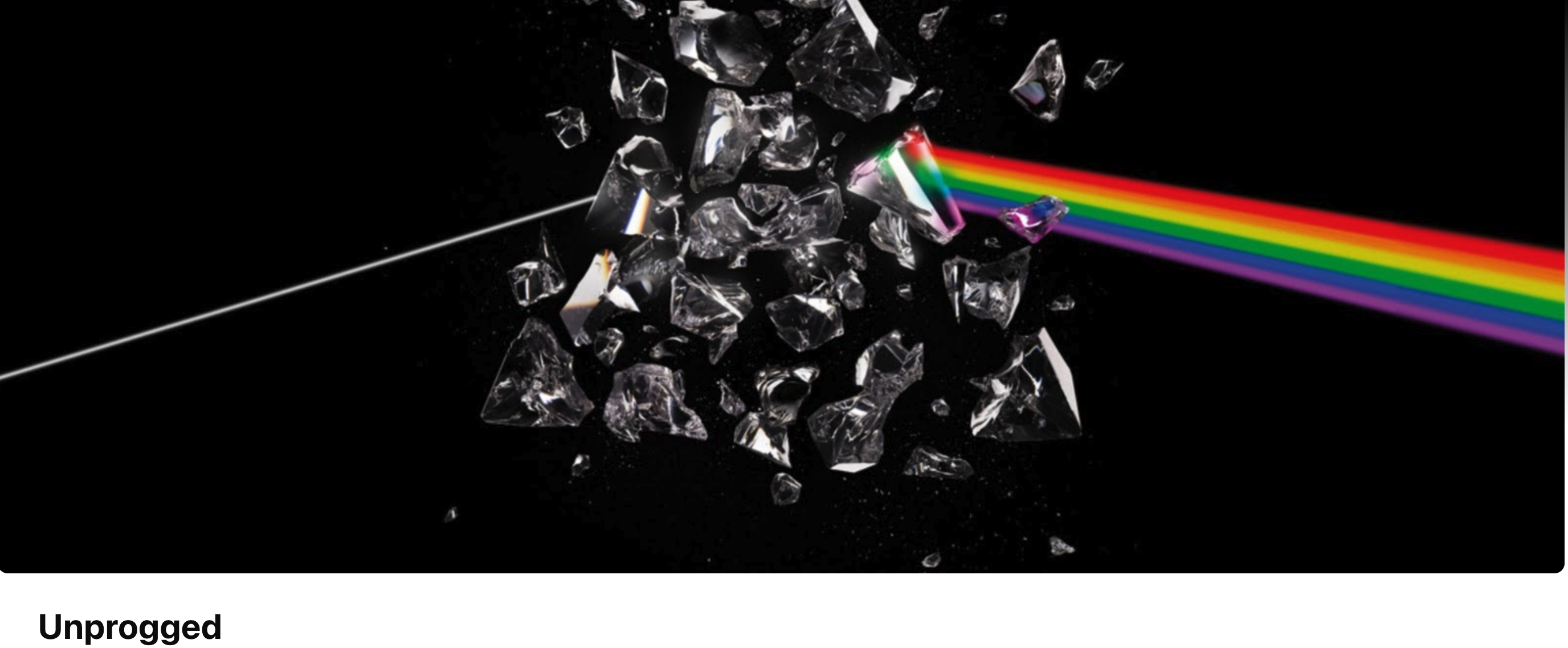
Dopo il fortunato e valido esordio del 2007 (Waterline) torna con una prova ancora più matura il compositore e tastierista Alex Carpani, che qui si avvale di ottimi musicisti come Gigi Cavalli Cocchi (Moongarden, Mangala Vallis) alla batteria, Ettore Salati (The Watch, Red Zen) alla chitarra e Fabiano Spiga al basso. Con Waterline Carpani aveva mostrato una capacità di scrittura brillante e sicura, anche se molto rivolta alla storia del rock progressivo, sia inglese che italiano e difatti si era avvalso della collaborazione con uno dei personaggi chiave della produzione nazionale come Aldo Tagliapietra, cantante delle Orme. Dopo 3 anni di grandi soddisfazioni che hanno portato il tastierista ad un vero e proprio tour mondiale con tappe in Giappone, Germania e Francia, solo per citare alcuni paesi toccati dal gruppo, Carpani propone dieci brani legati tra loro a formare una sorta di suite progressiva. Per far questo decide di occuparsi personalmente delle parti vocali e di non attuare sostanziali modifiche alla struttura e al sound del disco precedente che tanto interesse aveva suscitato tra appassionati e critici. Quindi The Sanctuary procede piacevolmente con un alternanza di brani strumentali e cantati e con riferimenti continui ad alcuni nomi tutelari del progressive rock come Genesis ed Emerson Lake & Palmer. L’inizio è affidato alla strumentale Burning braziers, perfetta per introdurre l’album e portare l’ascoltatore nel mood sonoro tanto caro a Carpani che mostra da subito tutte le sue doti tastieristiche, coadiuvato dallo splendido lavoro dei musicisti a sua disposizione. Qui c’è tutto ciò che ci si può aspettare da uno strumentale progressivo, quindi atmosfera e cambi di tempo, virtuosismo e senso della melodia. Spirit of decadence suggestiva e malinconica, piace soprattutto per la sua capacità di avvolgere ed ammaliare l’ascoltatore. Qui Carpani predilige un impianto maggiormente collettivo e meno solistico e l’unica (lieve) pecca è forse la voce del leader che non convince del tutto, pur non risultanto fastidiosa o piatta. Ovvio però che un cantante di ruolo avrebbe giovato un po’ a tutto l’album. Si torna ad uno strumentale con The Dance of the Sacred Elves dove ovviamente le tastiere di Carpani sono nuovamente grandi protagoniste e ci guidano in sonorità che spaziano dal rock progressivo alla classica passando per accenni che richiamano al jazz. Grande tecnica strumentale e uno sguardo costante alla musica degli Emerson Lake & Palmer, grande fonte d’ispirazione per il musicista di origine svizzera. Il finale si aggancia alla successiva Entering the Sanctuary, brano dove forte è la presenza del moog, soprattutto nella prima parte. Nella seconda metà, prettamente strumentale, la band struttura il brano in maniera più articolata con Carpani eccellente al pianoforte, una sezione ritmica a proprio agio in trame sottilmente aggrovigliate e Salati attento a creare sonorità riflessive e fluide. Knights and Clergymen è un’ altra ispirata e splendida composizione strumentale, con Carpani abilissimo anche nel destreggiarsi con l’organo hammond in un alternanza continua di passaggi ora più rapidi ora più meditativi. Ancora l’ombra di Keith Emerson è presente in Templars dream dove è finalmente più preponderante rispetto agli altri brani la chitarra di Salati che sfodera il suo talento punteggiando egregiamente il corollario sonoro tastieristico di Carpani. Davvero splendida è Memories of a Wedding che introdotta da un delicato pianoforte esplode attraverso una sezione ritmica pulsante e sanguigna su cui si inseriscono le note sempre stranianti del moog. Strumentale è la seguente Master of ceremonies, episodio brillante e piacevole ma che non aggiunge molto a quanto ascoltato sin ora. Decisamente meglio Moonlight through the Ruins che si presenta come brano sognante e delicato, salvo poi avventurarsi in un momento strumentale degno delle migliori progressive band. In chiusura Leaving the Sanctuary, epica e dal piglio orchestrale, riporta ancora una volta agli anni d’oro del rock progressivo. Complessivamente si tratta di un lavoro più che valido, suonato ottimamente e molto curato in fase di arrangiamento. Anche se qualche passaggio non particolarmente brillante è presente direi che non ci sono brani da scartare o aggiunti esclusivamente per allungare la durata dell’album. La scrittura di Carpani si è affinata ulteriormente rispetto a Waterline, pur rimanendo all’interno di un panorama sonoro molto omogeneo e di grande rispetto verso i giganti del progressive inglese dei ’70. Oltre a ciò aggiungerei che Carpani, incredibile alle tastiere, non ha una voce memorabile e che forse andava sfruttato meglio il talento di Salati. Questo non pregiudica comunque la riuscita finale di The Sanctuary ma lascia in me aperta la sensazione che il prossimo possa essere il disco della definitiva consacrazione. Voto: 5 su 6
No. 32
CLASSIC ROCK (UK)
http://www.classicrockmagazine.com/
by Natasha Sharf
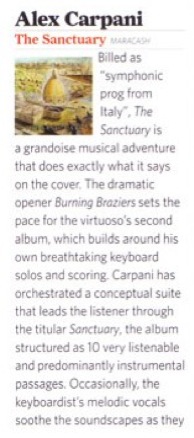
No. 33
RAW & WILD (ITALY)
http://www.rawandwild.com/review/review.php?id=Alex+Carpani
by G.F. Cassatella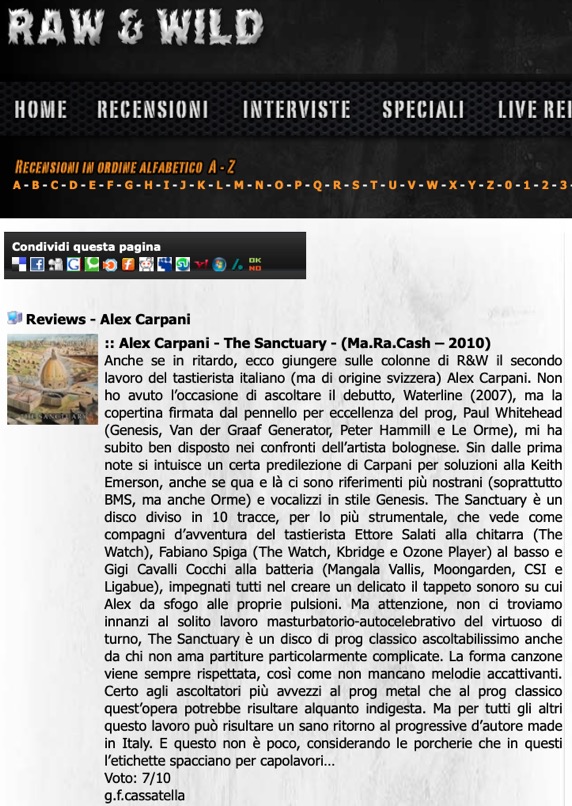
Anche se in ritardo, ecco giungere sulle colonne di R&W il secondo lavoro del tastierista italiano (ma di origine svizzera) Alex Carpani. Non ho avuto l’occasione di ascoltare il debutto, Waterline (2007), ma la copertina firmata dal pennello per eccellenza del prog, Paul Whitehead (Genesis, Van der Graaf Generator, Peter Hammill e Le Orme), mi ha subito ben disposto nei confronti dell’artista bolognese. Sin dalle prima note si intuisce un certa predilezione di Carpani per soluzioni alla Keith Emerson, anche se qua e là ci sono riferimenti più nostrani (soprattutto BMS, ma anche Orme) e vocalizzi in stile Genesis. The Sanctuary è un disco diviso in 10 tracce, per lo più strumentale, che vede come compagni d’avventura del tastierista Ettore Salati alla chitarra (The Watch), Fabiano Spiga (The Watch, Kbridge e Ozone Player) al basso e Gigi Cavalli Cocchi alla batteria (Mangala Vallis, Moongarden, CSI e Ligabue), impegnati tutti nel creare un delicato il tappeto sonoro su cui Alex da sfogo alle proprie pulsioni. Ma attenzione, non ci troviamo innanzi al solito lavoro masturbatorio-autocelebrativo del virtuoso di turno, The Sanctuary è un disco di prog classico ascoltabilissimo anche da chi non ama partiture particolarmente complicate. La forma canzone viene sempre rispettata, così come non mancano melodie accattivanti. Certo agli ascoltatori più avvezzi al prog metal che al prog classico quest’opera potrebbe risultare alquanto indigesta. Ma per tutti gli altri questo lavoro può risultare un sano ritorno al progressive d’autore made in Italy. E questo non è poco, considerando le porcherie che in questi tempi le etichette spacciano per capolavori… Voto: 7/10
No. 34
QUEBEC AUDIO & VIDEO (CANADA)
http://www.quebecaudio.com
by Richard Guay
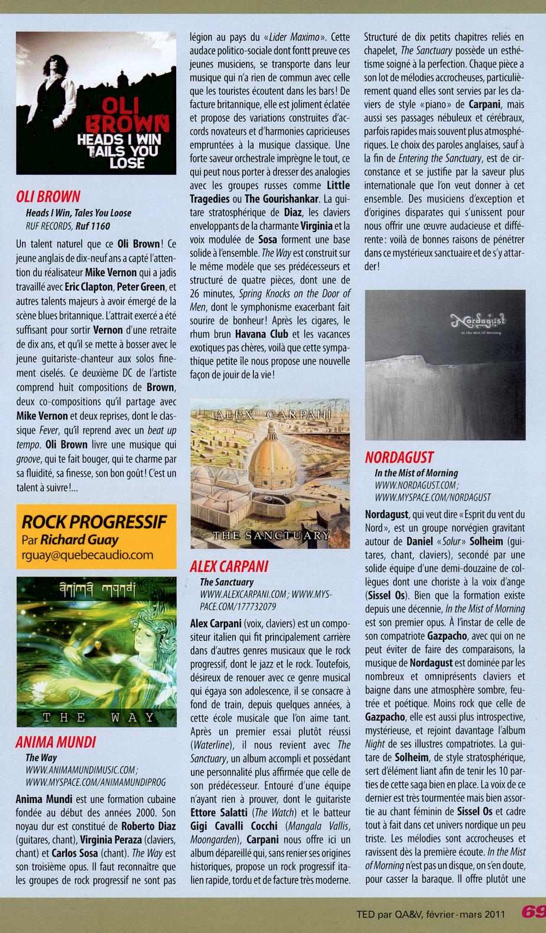
No. 35
ARTROCK.SE (SWEDEN)
http://www.artrock.se/artrock2011/recensioner2011_61.htm
by Mikael Bennerhed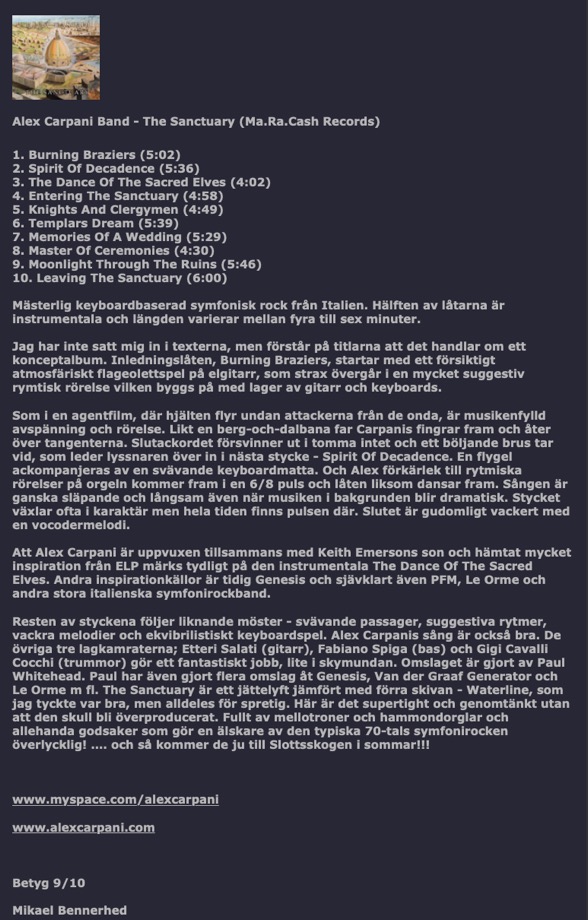
Mästerlig keyboardbaserad symfonisk rock från Italien. Hälften av låtarna är instrumentala och längden varierar mellan fyra till sex minuter.
Jag har inte satt mig in i texterna, men förstår på titlarna att det handlar om ett konceptalbum. Inledningslåten, Burning Braziers, startar med ett försiktigt atmosfäriskt flageolettspel på elgitarr, som strax övergår i en mycket suggestiv rymtisk rörelse vilken byggs på med lager av gitarr och keyboards. Som i en agentfilm, där hjälten flyr undan attackerna från de onda, är musikenfylld avspänning och rörelse. Likt en berg-och-dalbana far Carpanis fingrar fram och åter över tangenterna. Slutackordet försvinner ut i tomma intet och ett böljande brus tar vid, som leder lyssnaren över in i nästa stycke - Spirit Of Decadence. En flygel ackompanjeras av en svävande keyboardmatta. Och Alex förkärlek till rytmiska rörelser på orgeln kommer fram i en 6/8 puls och låten liksom dansar fram. Sången är ganska släpande och långsam även när musiken i bakgrunden blir dramatisk. Stycket växlar ofta i karaktär men hela tiden finns pulsen där. Slutet är gudomligt vackert med en vocodermelodi. Att Alex Carpani är uppvuxen tillsammans med Keith Emersons son och hämtat mycket inspiration från ELP märks tydligt på den instrumentala The Dance Of The Sacred Elves. Andra inspirationkällor är tidig Genesis och sjävklart även PFM, Le Orme och andra stora italienska symfonirockband.
Resten av styckena följer liknande möster - svävande passager, suggestiva rytmer, vackra melodier och ekvibrilistiskt keyboardspel. Alex Carpanis sång är också bra. De övriga tre lagkamraterna; Etteri Salati (gitarr), Fabiano Spiga (bas) och Gigi Cavalli Cocchi (trummor) gör ett fantastiskt jobb, lite i skymundan. Omslaget är gjort av Paul Whitehead. Paul har även gjort flera omslag åt Genesis, Van der Graaf Generator och Le Orme m fl. The Sanctuary är ett jättelyft jämfört med förra skivan - Waterline, som jag tyckte var bra, men alldeles för spretig. Här är det supertight och genomtänkt utan att den skull bli överproducerat. Fullt av mellotroner och hammondorglar och allehanda godsaker som gör en älskare av den typiska 70-tals symfonirocken överlycklig! .... och så kommer de ju till Slottsskogen i sommar!!! 9/10
No. 36
CHROMATIQUE.NET (FRANCE)
http://chromatique.net/index.php?option=com_k2&view=item&id=2915:The%20Sanctuary&Itemid=12
by Jérôme Walczak
Après Waterline, son précédent disque ouvertement marqué par les années soixante-dix et sur lequel les influences d'ELP et de Genesis étaient légions, le Franco-Italien, encouragé par un succès critique mérité, récidive avec un entêtement qu'il est bon de souligner. L'artiste continue ainsi d'assumer totalement la filiation directe évoquée et ne s'encombre pas d'esbroufes techniques qui seraient de simples prétextes pour faire moderne. Si le chant sur son précédent album laissait à désirer, l'écueil est ici très simplement contourné puisqu'il assume désormais lui-même la totalité des parties vocales. Avec à ses côtés le batteur Gigi Cavalli Cocchide (Mangalla Vallis), le guitariste Ettore Salati qui officia un temps avec The Watch et Fabiano Spiga à la basse, l'ensemble tient la route tout en bénéficiant d'une production très honorable. Finalement, loin d'être original par son attachement bien trop prononcé à ELP et leur Brain Salad Surgery (« Burning Braziers », « The Dance of the Sacred Elves »), il reste émouvant de constater que presque quarante ans après, ce style réussit encore à faire mouche en termes d'émotions. Un petit anachronisme réussi, qui saura trouver son public et qu'il est sympathique de soutenir. 6/10
No. 37
MUSIC STREET JOURNAL (U.S.A.)
http://www.musicstreetjournal.com/index_cdreviews_display.cfm?id=102854
by Gary Hill

2010 has seen the release of some of the best music in recent memory. That makes it very hard to come with a ten best list for the year. This album is certainly a contender, though. It has a modern sound, but is so firmly rooted in classic progressive rock that it wouldn’t be a big shock to find out it had been released in the 1970s and was a reissue. Of course, that’s not true. This should appeal to the fans of the original run of progressive rock. There is plenty here that feels like bands like Emerson Lake and Palmer, Yes, Kansas and Genesis. Of course, no matter which influences stand out to a given listener, it’s an amazing album however it’s sliced.
Track by Track Review:
Burning Braziers
Keyboards lead off and the track builds very gradually from there. Then it threatens to move to a metallic texture, but instead keyboards come over the top and the motif is closer to a harder rocking Emerson Lake and Palmer. It moves through a series of changes and alterations and at points comes close to metal, but the keyboards keep it more firmly grounded in progressive rock. This extensive instrumental covers a lot of musical ground, and while the closest comparison is ELP, hints of Yes and Genesis also appear. Some circus styled music and more classical progressions are also incorporated at times.
Spirit Of Decadence
This rises up gradually with ambience serving as the introduction. Then keyboards join and create wonderful worlds of instrumental sound. It builds in a powerful way from there. It modulates out to a progression that brings in lots of Yes and Genesis and the first vocals of the disc join amidst that progression. Once more the keyboards really dominate this thing, but while they sounded rather like Keith Emerson’s work in the opener, they are closer to Rick Wakeman’s style here. They take this into a very melodic movement later that’s closer to Genesis. It’s another powerful and dynamic piece that even seems a bit like Kansas at times. It changes often and in very great ways. A mellower movement later and the build up that follows are very much in keeping with the type of music that typified early Genesis. While the opener had a lot of changes and variety, this piece makes that one seem staid by comparison. In fact, it’s amazing how much is packed into a five and a half minute song. They even take it out to a mellow symphonic bit late.
The Dance Of The Sacred Elves
The retro keyboard sound that opens this is incredibly tasty. It has a sort of dancing nature to it, feeling like some kind of an elf dance. Other instruments join after a time and this is another piece that is likely to make a listener think about ELP at times and Yes at others. Still, another jam is more like the more proggy side of Kansas. It’s another dynamic and powerful cut that is full on prog and definitely dominated by the keyboards. It has a lot of symphonic elements built into its tapestry. It’s another instrumental piece.
Entering The Sanctuary
Keys once more start this off and hold it for a time. As it builds up there is some crunchy guitar, but the track still retains a progressive rock, rather than metal, nature. Emerson Lake and Palmer is again on the menu, but there are plenty of other sounds here, too – Yes being one of them. It gets quite symphonic at times and is very dynamic and full of changes and alterations.
Knights And Clergymen
A retro keyboard sound akin to early Genesis leads off and they build it from there. It turns out into a smoking hot progressive rock jam that’s got a lot of Emerson Lake and Palmer and a lot of Yes built into it. The closing segment of this instrumental calls to mind Kansas’ “Magnum Opus” again.
Templars Dream
While all the familiar players are back on this progressive rock jam in terms of influence, it definitely doesn’t risk seeming like the rest of the album. They take it through a number of intriguing and powerful changes and movements. There’s a great Wakeman-like piano solo that heralds the entrance of the vocals. This is another powerful piece of music with a lot of diversity and variety built into it. It’s one of those pieces that just keeps getting rearranged and turning corners here and there.
Memories Of A Wedding
The keyboard movement that starts this is quite classical in nature, but the song works out to more of the same killer retro progressive rock that’s been heard throughout. While all the familiar references are here, this one is perhaps more Genesis-like than some of the other material on show. It’s every bit as dynamic and powerful as the rest of the set, though.
Master Of Ceremonies
If the last piece was more Genesis-like, this one doesn’t seem to have a lot of that band in the mix. However, Yes, Kansas and ELP can all be heard at different points in this powerful cut. A mellower movement later calls to mind Klaatu a bit, but they power back out from there. This is a dynamic and very potent instrumental piece that is full of changes and twists. In a bit of a surprise there’s a little bit of flamenco music at the end of the piece.
Moonlight Through The Ruins
There’s a fairly long balladic movement that calls to mind Genesis, but it also moves out to some of the more modern and crunchy instrumental work of the whole set. In many ways this is the most complex and diverse cut on show. There is a lot of Genesis in the harder rocking movements, too, though. And that extensive instrumental movement gives a return to the Genesis-like balladic section. This is arguably the strongest piece on show. Of course, when everything is this good, it’s really hard to pick one standout.
Leaving The Sanctuary
This killer instrumental at times calls to mind Pentwater. At other points Emerson Lake and Palmer are on the bill. Still other sections make one think of Yes and others point to Genesis. All in all, though, it’s a smoking hot progressive rock jam and a great way to end the proceedings in style.
No. 38
MERLIN PROG (NORWAY)
http://www.merlinprog.com/soreuropa.htm
by THE STAFF
Med en fin debut i form av “Water Line” blir det naturlig nok stilt visseforventninger til Alec Capani sin oppfølger. Nå hører det også med til historien at ikke en eneste musiker fra forrige skive hadde anledning til å spille på ”The Sanctuary”. Andre faktum er at skiva klokker inn på noe over femtien minutter og er mastret av Mika Jussila i Finnvox Stuio i Finnand faktisk! Som en digresjon tar vi med at Alex Carpani Band er basert på tilfeldigheter fordi mens Carpani var rekonvalesent med et ankelbrudd så fikk han tid til å komponere temmelig mye. Det materialet som da ble produsert ble i sin tid til den omtalte debuten ”Water Line”. Dette albumet her hviler rimelig tungt på keyboard uten at det noen gang blir direkte plagsomt. Plagsom er i alle fall ikke produksjonen som er om ikke i stjerneklasse så i alle fall høyt der oppe, og som står seg virkelig bra til et klassisk symfonisk progalbum uten alt for god vokal av Carpani selv. På ”Burning Brazier” er det ingen vokal, og den våkne leser vil da skjønne at låten er instrumental. Noe nikk mot Tangent og mye flott keyboardspilling med mange snertne taktskifter og nok snacks til at lytteren blir på sin post. Ettore Salati viser sin klasse på “Entering The Sanctuary” og gir oss noen gitarlinjer av høy klasse. Låtene er rimelig dynamisk og Carpani sine keyboardspilling er av det mer subtile slaget selv om hans vokale prestasjoner også her ikke er av samme klasse. Klasse er det derimot over tangenttrakteringen på ”Master Of Ceremonies” som har anselige mengder med slikt, men som også suppleres og støttes bra av gitaren. Den formidable flamencoavslutningen er vel verdt å få med seg, og fullbyrder en flott låt. Keyboardene er også i sentrum på ”Knights And Clergymen”, men på tross av dette er låten den hvor samhandlingen til musikerne er på sitt beste. Det er også en rimelig dramatisk lyrisk kontekst her og rytmeskiftene og stemningene er nøyaktig og sublimt tilpasset. En rytmisk frodig og hypnotisk låt som nok er den beste låten fra Carpani sin hånd denne gangen. De ti låtene forteller en ikke alt for avansert lineær historie, og det er diverse stemningsskifter som musikken pent fanger opp med sin om ikke store så ok variasjon. ”Templares Dream” gir faktisk noen virkelig flotte gitarlinjer før keyboardene tar full kontroll som seg hør og bør på et album såpass stenket i keyboard. Produksjonen er av solid støpning, og låtene er ikke akkurat full av overraskelser men med såpass essens at de evner å holde på lytteren uten nødvendigvis å fjetre hun eller han. Det er et solid verk med symfonisk prog som er ok uten at det noen gang blir et festfyrverkeri men mer et verk med fin kvalitet!
No. 39
MUSIC BY MAIL (DENMARK)
http://www.musicbymail.dk/cds/new.htm
by THE STAFF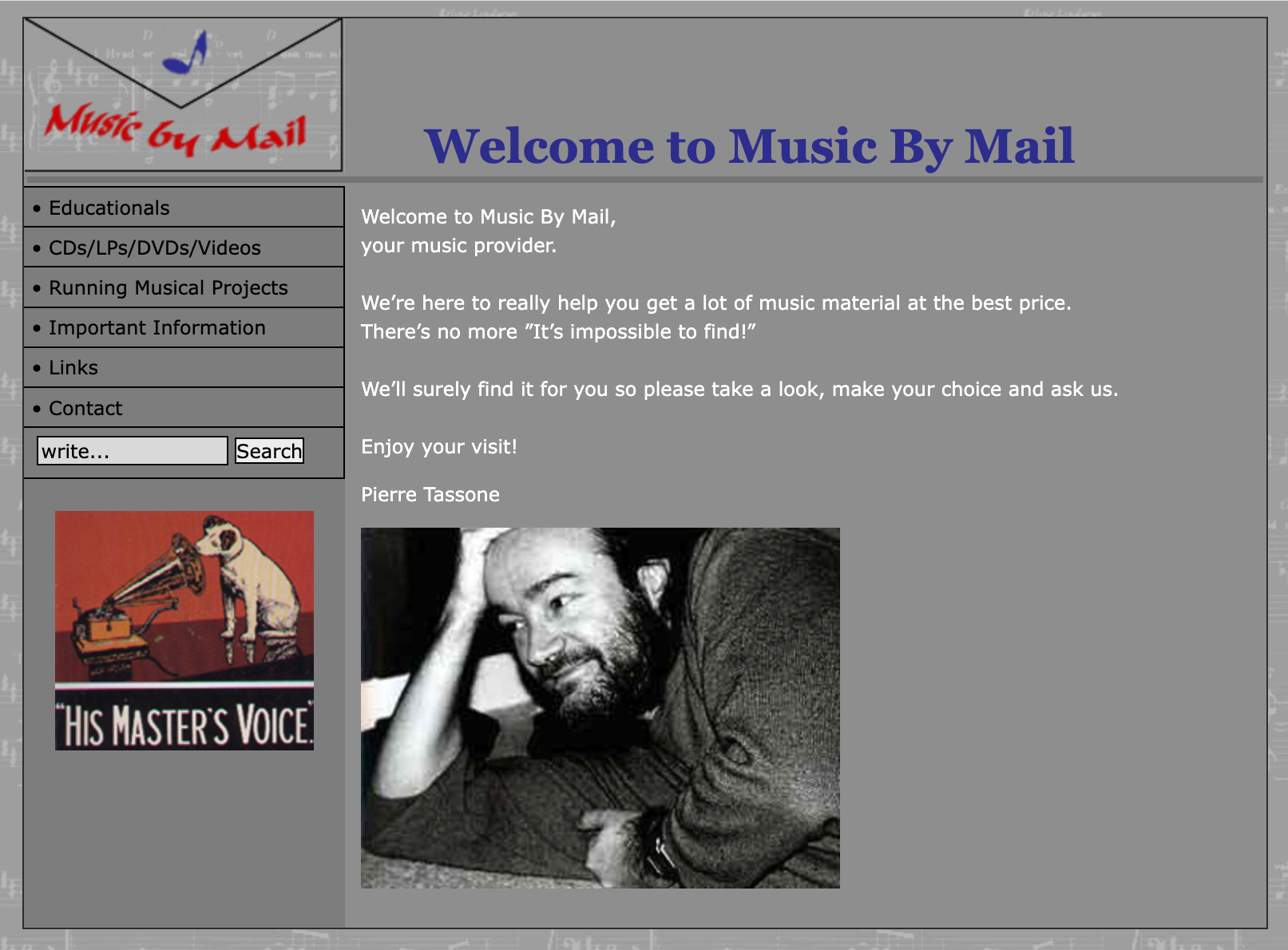
The Sanctuary. Ma.Ra.Cash Records (MRC 021 CD). 2010.
After the huge success of the critically acclaimed first album, the new one is a long story divided in 10 tracks forming a long suite. The incredible talent of Alex on keyboards is evident, both as regards orchestral background and magical solos. Along with the tried and tested band (in which stands the former guitarist of The Watch), we find Gigi Cavalli Cocchi on drums (Mangala Vallis, Moongarden, etc..), as well as Fabiano Spiga on bass. The artwork is signed by prog icon Paul Whitehead.
No. 40
PROGRESSIVE-NEWSLETTER (GERMANY)
http://www.musicbymail.dk/cds/new.htm
by Kristian Selm

No. 41
DA MUSIC (BELGIUM)
http://www.damusic.be/cd/alex-carpani/the-sanctuary
by Christoph Lintermans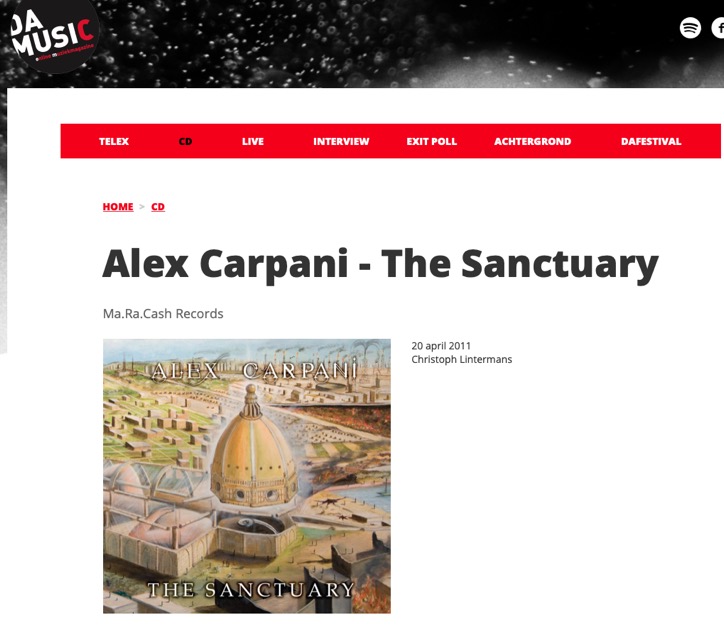
Italianen hebben een roemrijke geschiedenis om te koesteren. Ze hoeven doorgaans niet ver te stappen om hun materiële verleden te bewonderen. Het moet Alex Carpani zeker geïnspireerd hebben tot ‘The Sanctuary’. Maar het virtuele heiligdom dat hij op zijn tweede album optrekt, is ook een pantheon voor zijn Italiaanse en Engelse toetsenhelden.In het heiligdom dat Carpani beschrijft, wemelt het van elfen, ridders en monniken. Of een combinatie van die laatste twee, de tempeliers. Dit is waar de zogenaamde RPI (Rock Progressivo Italiano) goed in is: verhalen vertellen. Toch is de helft van de tien tracks instrumentaal. Maar Carpani vertelt vooral op zijn bij voorkeur antieke toetsen - het Hammondorgel, de Mellotron en de Moog. De cover werd getekend door Paul Whitehead (bekend van onder andere Genesis) en ademt een surrealistische sfeer uit. Het album begint net zo: de eerste akkoorden klinken als niet van deze wereld, maar al snel volgt een eerste duel tussen orgel en gitaar (Ettore Salati, ex-The Watch). Het pad wordt geëffend voor de talrijke instrumentale erupties die zullen komen. Een lavastroom van vintage toetsen doet de titel (Burning Braziers) alle eer aan. Een wind (of beter: een Mellotronkoor) stuurt de Spirit of Decadence op je af. Orgel, gitaar en Moog gaan hier in contrapunt met elkaar. Het is de opmaat naar een eerste gezongen gedeelte. Dan doen gitaararpeggio’s hun plechtige intrede. Dat doet natuurlijk aan Genesis denken, maar het geheel heeft ook wat weg van de onderschatte Duitse band versus X, al is Carpani een beter zanger. In The Dance of the Sacred Elves gaat het orgel helemaal gek. Hammond en Moog roepen herinneringen op aan de legendarische Keith Emerson. In dit nummer schurkt men inderdaad het dichtst aan bij ELP, met name de lp ‘Tarkus’. In Entering The Sanctuary overheerst een ander soort bewondering, die voor het heiligdom. Het ensemblespel is hier trouwens van een hemelse schoonheid. De hele band is hier in optima forma. Maar wanneer de kern van het heiligdom ontdekt wordt, kunnen enkel de menselijke stem en de Mellotron het onuitspreekbare uitdrukken. Knights and Clergymen is een swingend virtuoos nummer op de toetsen. Dit is voer voor Emerson- en Wakemanfanaten. De Mellotronkoortjes dompelen je onder in een middeleeuwse sfeer. Een lekker pompend ritme is de stuwende kracht achter Templars Dream. Toetsen- en zangpartijen worden hier gestut door een heerlijke baslijn. Wat een metamorfose: een verleidelijk pianootje leidt naar Memories of a Wedding. De ritmische veranderingen stellen bassist Fabiano Spiga en drummer Marco Fabbri op de proef en houden de luisteraar scherp. Zang wordt afgewisseld met intens spel op de Moog. Mellotronkoortjes ronden de herinnering met gepaste eerbied af. Master of Ceremonies is de signatuursound van Carpani. De maestro leidt de plechtigheid met feestelijk spel. Orkestrale toetsen maken het bruggetje naar een tweede uitwerking van het thema, waarin een onzelfzuchtige Carpani de gitaar meer ruimte geeft. De coda krijgt zelfs een flamencogitaar mee. Een klassieke gitaar reageert hierop met open, heldere akkoorden; het is de aanzet tot Moonlight through the Ruins. Een verhalende stem schetst het nachtelijke tafereel, en dan: ta-dam!! Korte erupties van tutti doen de geheime stilte wijken voor vette Moog- en Hammondklanken. Maar het geheim blijft intact, als gitaararpeggio’s de gewijde rust finaal doen weerkeren. Leaving the Sanctuary klinkt door de variatie aan fraaie inkleuringen en tempi als een synthese van al het voorgaande. Het meest opvallend zijn de plechtstatig schallende Moog en het duet tussen toetsen en tribale drums. Het mag duidelijk wezen: het teruggrijpen naar antieke instrumenten en inspiratiebronnen hoeft geen sta-in-de-weg te zijn voor originaliteit. Of hoe Alex Carpani de geest van het verleden - in meer dan één betekenis - een plaats weet te geven in de hedendaagse muziek.
No. 42
PROGRESSOR (UZBEKISTAN)
http://www.progressor.net/review/carpani_2010.html
by Olav M. Bjornsen
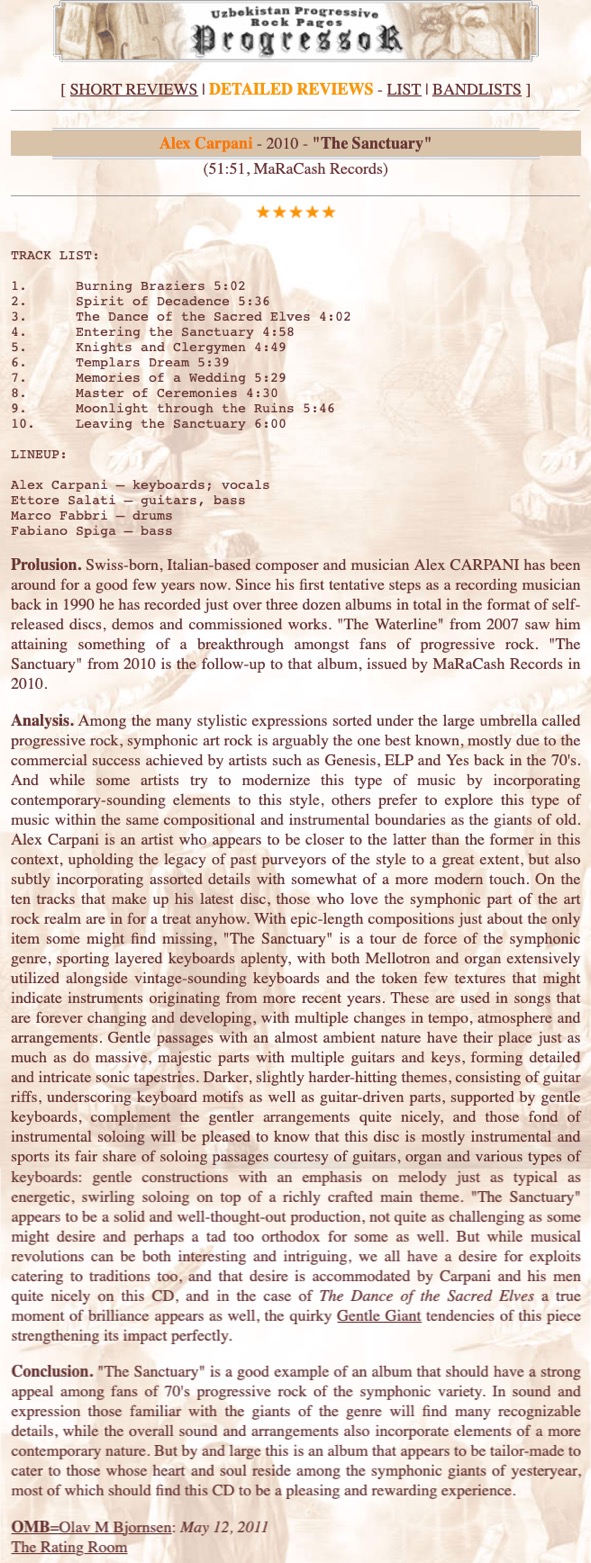
Prolusion.
Swiss-born, Italian-based composer and musician Alex CARPANI has been around for a good few years now. Since his first tentative steps as a recording musician back in 1990 he has recorded just over three dozen albums in total in the format of self-released discs, demos and commissioned works. "The Waterline" from 2007 saw him attaining something of a breakthrough amongst fans of progressive rock. "The Sanctuary" from 2010 is the follow-up to that album, issued by MaRaCash Records in 2010.
Analysis. Among the many stylistic expressions sorted under the large umbrella called progressive rock, symphonic art rock is arguably the one best known, mostly due to the commercial success achieved by artists such as Genesis, ELP and Yes back in the 70's. And while some artists try to modernize this type of music by incorporating contemporary-sounding elements to this style, others prefer to explore this type of music within the same compositional and instrumental boundaries as the giants of old. Alex Carpani is an artist who appears to be closer to the latter than the former in this context, upholding the legacy of past purveyors of the style to a great extent, but also subtly incorporating assorted details with somewhat of a more modern touch. On the ten tracks that make up his latest disc, those who love the symphonic part of the art rock realm are in for a treat anyhow. With epic-length compositions just about the only item some might find missing, "The Sanctuary" is a tour de force of the symphonic genre, sporting layered keyboards aplenty, with both Mellotron and organ extensively utilized alongside vintage-sounding keyboards and the token few textures that might indicate instruments originating from more recent years. These are used in songs that are forever changing and developing, with multiple changes in tempo, atmosphere and arrangements. Gentle passages with an almost ambient nature have their place just as much as do massive, majestic parts with multiple guitars and keys, forming detailed and intricate sonic tapestries. Darker, slightly harder-hitting themes, consisting of guitar riffs, underscoring keyboard motifs as well as guitar-driven parts, supported by gentle keyboards, complement the gentler arrangements quite nicely, and those fond of instrumental soloing will be pleased to know that this disc is mostly instrumental and sports its fair share of soloing passages courtesy of guitars, organ and various types of keyboards: gentle constructions with an emphasis on melody just as typical as energetic, swirling soloing on top of a richly crafted main theme. "The Sanctuary" appears to be a solid and well-thought-out production, not quite as challenging as some might desire and perhaps a tad too orthodox for some as well. But while musical revolutions can be both interesting and intriguing, we all have a desire for exploits catering to traditions too, and that desire is accommodated by Carpani and his men quite nicely on this CD, and in the case of The Dance of the Sacred Elves a true moment of brilliance appears as well, the quirky Gentle Giant tendencies of this piece strengthening its impact perfectly. Conclusion: "The Sanctuary" is a good example of an album that should have a strong appeal among fans of 70's progressive rock of the symphonic variety. In sound and expression those familiar with the giants of the genre will find many recognizable details, while the overall sound and arrangements also incorporate elements of a more contemporary nature. But by and large this is an album that appears to be tailor-made to cater to those whose heart and soul reside among the symphonic giants of yesteryear, most of which should find this CD to be a pleasing and rewarding experience.
No. 43
PROGWERELD (THE NETHERLANDS)
http://www.progwereld.org/cms/recensies/album/alex-carpani-%e2%80%93-the-sanctuary/
by Wouter Bessels
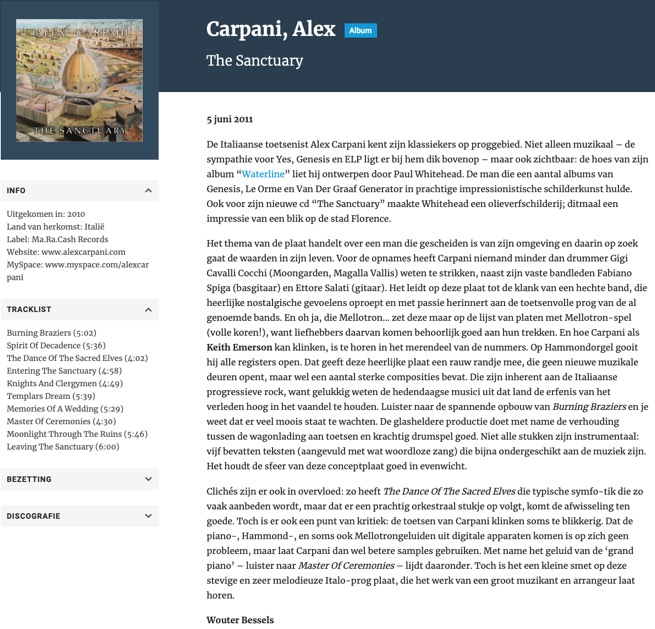
De Italiaanse toetsenist Alex Carpani kent zijn klassiekers op proggebied. Niet alleen muzikaal – de sympathie voor Yes, Genesis en ELP ligt er bij hem dik bovenop – maar ook zichtbaar: de hoes van zijn album “Waterline” liet hij ontwerpen door Paul Whitehead. De man die een aantal albums van Genesis, Le Orme en Van Der Graaf Generator in prachtige impressionistische schilderkunst hulde. Ook voor zijn nieuwe cd “The Sanctuary” maakte Whitehead een olieverfschilderij; ditmaal een impressie van een blik op de stad Florence. Het thema van de plaat handelt over een man die gescheiden is van zijn omgeving en daarin op zoek gaat de waarden in zijn leven. Voor de opnames heeft Carpani niemand minder dan drummer Gigi Cavalli Cocchi (Moongarden, Magalla Vallis) weten te strikken, naast zijn vaste bandleden Fabiano Spiga (basgitaar) en Ettore Salati (gitaar). Het leidt op deze plaat tot de klank van een hechte band, die heerlijke nostalgische gevoelens oproept en met passie herinnert aan de toetsenvolle prog van de al genoemde bands. En oh ja, die Mellotron… zet deze maar op de lijst van platen met Mellotron-spel (volle koren!), want liefhebbers daarvan komen behoorlijk goed aan hun trekken. En hoe Carpani als Keith Emerson kan klinken, is te horen in het merendeel van de nummers. Op Hammondorgel gooit hij alle registers open. Dat geeft deze heerlijke plaat een rauw randje mee, die geen nieuwe muzikale deuren opent, maar wel een aantal sterke composities bevat. Die zijn inherent aan de Italiaanse progressieve rock, want gelukkig weten de hedendaagse musici uit dat land de erfenis van het verleden hoog in het vaandel te houden. Luister naar de spannende opbouw van Burning Braziers en je weet dat er veel moois staat te wachten. De glasheldere productie doet met name de verhouding tussen de wagonlading aan toetsen en krachtig drumspel goed. Niet alle stukken zijn instrumentaal: vijf bevatten teksten (aangevuld met wat woordloze zang) die bijna ondergeschikt aan de muziek zijn. Het houdt de sfeer van deze conceptplaat goed in evenwicht. Clichés zijn er ook in overvloed: zo heeft The Dance Of The Sacred Elves die typische symfo-tik die zo vaak aanbeden wordt, maar dat er een prachtig orkestraal stukje op volgt, komt de afwisseling ten goede. Toch is er ook een punt van kritiek: de toetsen van Carpani klinken soms te blikkerig. Dat de piano-, Hammond-, en soms ook Mellotrongeluiden uit digitale apparaten komen is op zich geen probleem, maar laat Carpani dan wel betere samples gebruiken. Met name het geluid van de ‘grand piano’ – luister naar Master Of Ceremonies - lijdt daaronder. Toch is het een kleine smet op deze stevige en zeer melodieuze Italo-prog plaat, die het werk van een groot muzikant en arrangeur laat horen.
No. 44
HARMONIE MAGAZINE (FRANCE)
http://www.harmonie-magazine.com/
by Raymond Sérini

No. 45
METALLUS.IT (ITALY)
http://www.metallus.it/recensioni/the-sanctuary/
by Anna Minguzzi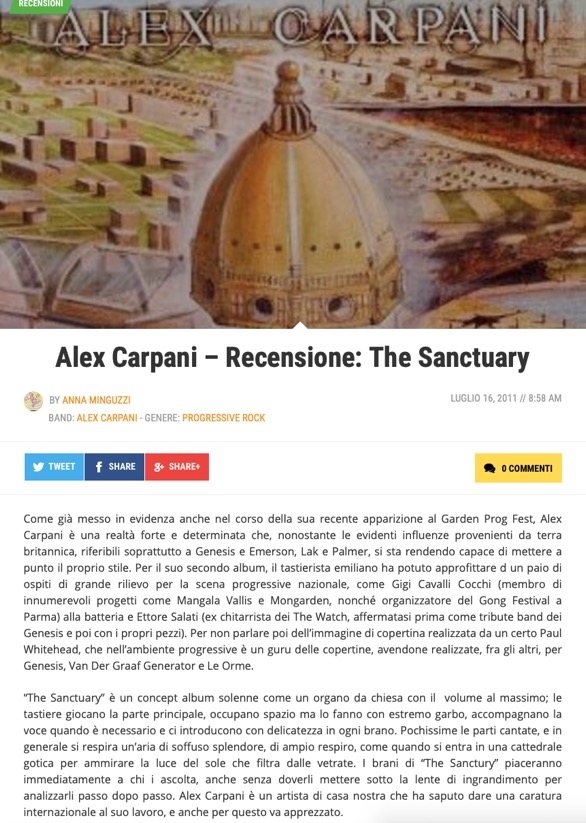
Come già messo in evidenza anche nel corso della sua recente apparizione al Garden Prog Fest, Alex Carpani è una realtà forte e determinata che, nonostante le evidenti influenze provenienti da terra britannica, riferibili soprattutto a Genesis e Emerson, Lak e Palmer, si sta rendendo capace di mettere a punto il proprio stile. Per il suo secondo album, il tastierista emiliano ha potuto approfittare d un paio di ospiti di grande rilievo per la scena progressive nazionale, come Gigi Cavalli Cocchi (membro di innumerevoli progetti come Mangala Vallis e Mongarden, nonché organizzatore del Gong Festival a Parma) alla batteria e Ettore Salati (ex chitarrista dei The Watch, affermatasi prima come tribute band dei Genesis e poi con i propri pezzi). Per non parlare poi dell’immagine di copertina realizzata da un certo Paul Whitehead, che nell’ambiente progressive è un guru delle copertine, avendone realizzate, fra gli altri, per Genesis, Van Der Graaf Generator e Le Orme. “The Sanctuary” è un concept album solenne come un organo da chiesa con il volume al massimo; le tastiere giocano la parte principale, occupano spazio ma lo fanno con estremo garbo, accompagnano la voce quando è necessario e ci introducono con delicatezza in ogni brano. Pochissime le parti cantate, e in generale si respira un’aria di soffuso splendore, di ampio respiro, come quando si entra in una cattedrale gotica per ammirare la luce del sole che filtra dalle vetrate. I brani di “The Sanctury” piaceranno immediatamente a chi i ascolta, anche senza doverli mettere sotto la lente di ingrandimento per analizzarli passo dopo passo. Alex Carpani è un artista di casa nostra che ha saputo dare una caratura internazionale al suo lavoro, e anche per questo va apprezzato. Voto: 7/10
No. 46
DUTCH PROGRESSIVE ROCK PAGE (THE NETHERLANDS)
http://www.dprp.net/reviews/201135.php#carpani
by Leo Koperdraat
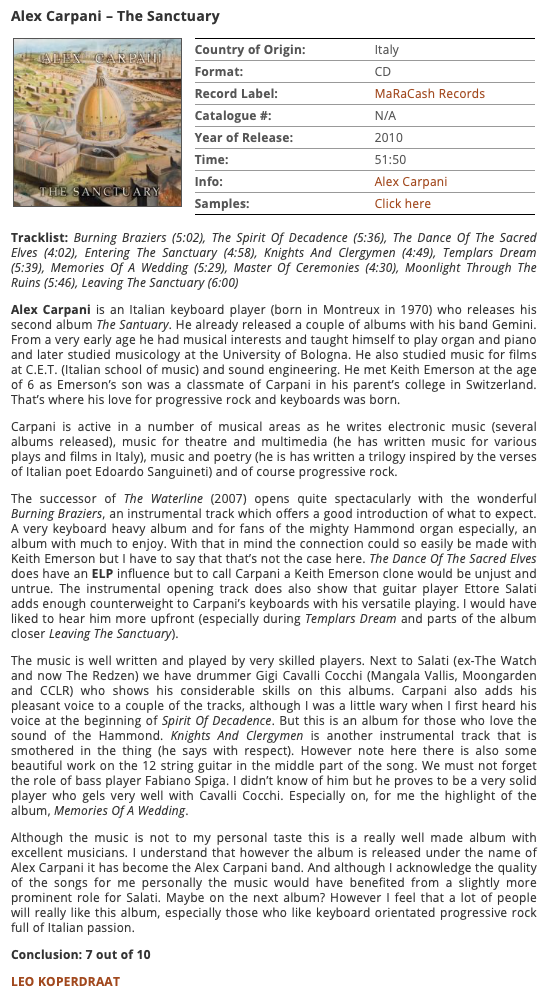
Tracklist:
Burning Braziers (5:02), The Spirit Of Decadence (5:36), The Dance Of The Sacred Elves (4:02), Entering The Sanctuary (4:58), Knights And Clergymen (4:49), Templars Dream (5:39), Memories Of A Wedding (5:29), Master Of Ceremonies (4:30), Moonlight Through The Ruins (5:46), Leaving The Sanctuary (6:00) Alex Carpani is an Italian keyboard player (born in Montreux in 1970) who releases his second album The Santuary. He already released a couple of albums with his band Gemini. From a very early age he had musical interests and taught himself to play organ and piano and later studied musicology at the University of Bologna. He also studied music for films at C.E.T. (Italian school of music) and sound engineering. He met Keith Emerson at the age of 6 as Emerson’s son was a classmate of Carpani in his parent’s college in Switzerland. That’s where his love for progressive rock and keyboards was born. Carpani is active in a number of musical areas as he writes electronic music (several albums released), music for theatre and multimedia (he has written music for various plays and films in Italy), music and poetry (he is has written a trilogy inspired by the verses of Italian poet Edoardo Sanguineti) and of course progressive rock. The successor of The Waterline (2007) opens quite spectacularly with the wonderful Burning Braziers, an instrumental track which offers a good introduction of what to expect. A very keyboard heavy album and for fans of the mighty Hammond organ especially, an album with much to enjoy. With that in mind the connection could so easily be made with Keith Emerson but I have to say that that’s not the case here. The Dance Of The Sacred Elves does have an ELP influence but to call Carpani a Keith Emerson clone would be unjust and untrue. The instrumental opening track does also show that guitar player Ettore Salati adds enough counterweight to Carpani’s keyboards with his versatile playing. I would have liked to hear him more upfront (especially during Templars Dream and parts of the album closer Leaving The Sanctuary). The music is well written and played by very skilled players. Next to Salati (ex-The Watch and now The Redzen) we have drummer Gigi Cavalli Cocchi (Mangala Vallis, Moongarden and CCLR) who shows his considerable skills on this albums. Carpani also adds his pleasant voice to a couple of the tracks, although I was a little wary when I first heard his voice at the beginning of Spirit Of Decadence. But this is an album for those who love the sound of the Hammond. Knights And Clergymen is another instrumental track that is smothered in the thing (he says with respect). However note here there is also some beautiful work on the 12 string guitar in the middle part of the song. We must not forget the role of bass player Fabiano Spiga. I didn’t know of him but he proves to be a very solid player who gels very well with Cavalli Cocchi. Especially on, for me the highlight of the album, Memories Of A Wedding. Although the music is not to my personal taste this is a really well made album with excellent musicians. I understand that however the album is released under the name of Alex Carpani it has become the Alex Carpani band. And although I acknowledge the quality of the songs for me personally the music would have benefited from a slightly more prominent role for Salati. Maybe on the next album? However I feel that a lot of people will really like this album, especially those who like keyboard orientated progressive rock full of Italian passion. Conclusion: 7 out of 10
No. 47
SINFOMUSIC
http://sinfomusic.net/portal/index.php?option=com_k2&view=item&id=968:alex-carpani-the-sanctuary-2010&Itemid=53
by the staff
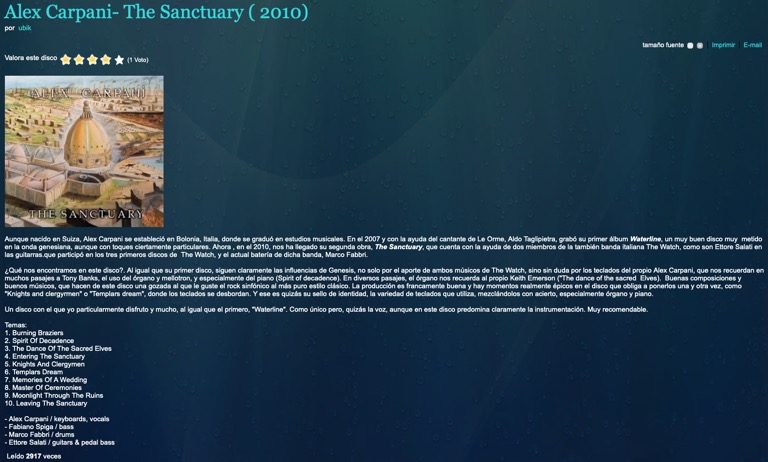
Aunque nacido en Suiza, Alex Carpani se estableció en Bolonia, Italia, donde se graduó en estudios musicales. En el 2007 y con la ayuda del cantante de Le Orme, Aldo Taglipietra, grabó su primer álbum Waterline, un muy buen disco muy metido en la onda genesiana, aunque con toques ciertamente particulares. Ahora , en el 2010, nos ha llegado su segunda obra, The Sanctuary, que cuenta con la ayuda de dos miembros de la también banda italiana The Watch, como son Ettore Salati en las guitarras. que participó en los tres primeros discos de The Watch, y el actual batería de dicha banda, Marco Fabbri. ¿Qué nos encontramos en este disco?. Al igual que su primer disco, siguen claramente las influencias de Genesis, no solo por el aporte de ambos músicos de The Watch, sino sin duda por los teclados del propio Alex Carpani, que nos recuerdan en muchos pasajes a Tony Banks, el uso del órgano y mellotron, y especialmente del piano (Spirit of decadence). En diversos pasajes, el órgano nos recuerda al propio Keith Emerson ("The dance of the sacred Elves). Buenas composiciones y buenos músicos, que hacen de este disco una gozada al que le guste el rock sinfónico al más puro estilo clásico. La producción es francamente buena y hay momentos realmente épicos en el disco que obliga a ponerlos una y otra vez, como "Knights and clergyrmen" o "Templars dream", donde los teclados se desbordan. Y ese es quizás su sello de identidad, la variedad de teclados que utiliza, mezclándolos con acierto, especialmente órgano y piano. Un disco con el que yo particularmente disfruto y mucho, al igual que el primero, "Waterline". Como único pero, quizás la voz, aunque en este disco predomina claramente la instrumentación. Muy recomendable.
No. 48
TEMPI DURI (ITALY)
http://www.tempi-duri.it/readreviewsdischi.asp?id=1108
by Pierluigi Daglio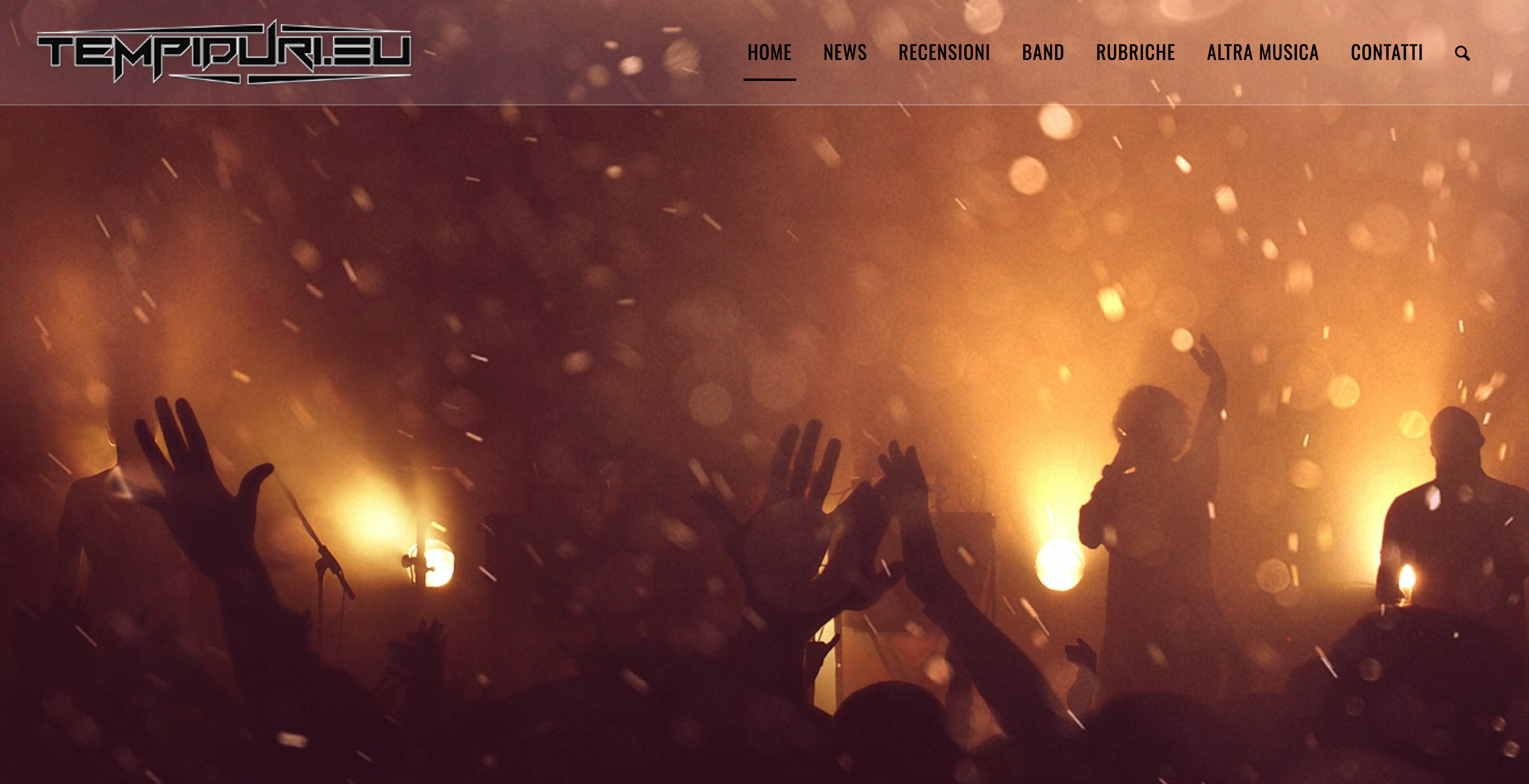
Secondo disco ispirato alla musica progressive per Alex Carpani e la sua band. Alex è un virtuoso delle tastiere e un musicista molto prolifico. Dal 2000 in avanti la sua attenzione compositiva si è maggiormente concentrata sul rock progressivo, genere che lo ha da sempre influenzato e ispirato, sulla musica elettronica e sulla musica per il teatro. Prendendo in considerazione il filone e le produzioni progressive, Alex nel 2005 ha firmato un contratto con l'etichetta indipendente americana CypherArts che ha in seguito pubblicato il suo primo album di matrice progressive dal titolo “Waterline” nel 2007. Alex in questo ambito ha anche collaborato con David Jackson, indimenticato sassofonista dei Van der Graaf Generator, Aldo Tagliapietra, front-man e bassista delle orme, e Paul Withehead, famoso per le illustrazioni sulle copertine di alcuni dischi dei Genesis. “Waterline” è un concept album di rock progressivo dedicato al quel sottile confine tra il mondo sommerso e il mondo emerso, tra due universi confinanti e attigui, ma profondamente diversi. La sottile linea di demarcazione tra ciò che ci è familiare, o ci sembra familiare, e l’ignoto. Alla fine di ottobre 2010 arriva finalmente il suo secondo disco progressive “The sanctuary”, un altro concept album dedicato questa volta ad un immaginario santuario che divide il protagonista dal mondo esterno che lo circonda. Il disco si apre con una bella ouverture strumentale, “Burning Braziers”, subito in atmosfera progressive, che parte lieve e lenta per poi evolvere repentinamente in potenti tastiere alla ELP che mantengono un ottimo ritmo e un groove coinvolgente. Ci sono interessanti variazioni musicali e riprese del tema dominante che si susseguono nel brano. Rimane però in secondo piano la parte ritmica a discapito delle tastiere. Un ottimo inizio per un disco che promette bene. Alcuni passaggi di tastiera ricordano le cadenze e le atmosfere di Tony Banks, tastierista dei Genesis. Il finale è particolare, caratterizzato da scale di note che si susseguono. Attraverso un bridge ventoso si prosegue con “Spirit Of Decadence” che ha un inizio maestoso, quasi epico, di pianoforte solo. Poi partono le tastiere con un ritmo sincopato molto intrigante intramezzato da qualche parte cantata. La voce resta, tuttavia, in secondo piano rispetto alla musica che recita sempre la parte preponderante del pezzo. Peccato per la scelta di cantare in inglese per un artista di lingua italiana. Non dimentichiamoci della grandiosa stagione del progressive italiano tra l’inizio e la metà degli anni settanta con ottimi dischi cantati anche in italiano. Il brano prosegue conservando sempre un ritmo avvolgente fino a un cambio di battuta marcatamente genesiano che introduce la seconda parte del pezzo, sempre di stampo genesiano, dove si sentono anche chitarre acustiche, per poi terminare nuovamente col pianoforte. Molto avvincente. “The Dance Of The Sacred Elves” ha un inizio prorompente sempre in stile ELP con una bella cadenza di organo hammond. Le tastiere sono le padrone assolute della prima parte del disco. Il brano è totalmente strumentale ed è suonato con una tecnica sopraffina. Le melodie si susseguono e si intersecano in un crescendo fino a mutare quasi improvvisamente in un suono vintage che poi riparte fragoroso e potente. Ottimi i contrappunti tra pianoforte e tastiere. Qua e là si riesce anche a sentire la chitarra elettrica. Segue “Entering The Sanctuary” con un inizio lento che però diventa subito ritmato e cadenzato. Ci sono anche parti cantate. Anche questa traccia è molto genesiana sia per i tappeti sonori che sostengono le parti cantate (The colony of slippermen) sia nei raccordi tra le diverse strofe. Alla fine troviamo anche una piccola parte cantata in italiano. La seguente “Knights And Clergymen” parte con una chitarra acustica per passare in breve tempo a un pregevole riff di organo hammond. Grande tecnica da parte di Alex che ricorda in alcuni passaggi la velocità e la modulazione di Rustichelli in Opera Prima, capolavoro del progressive italiano del 1973. Il brano sale di tono, sempre in crescendo. Finalmente anche basso e batteria fanno capolino tra le tastiere e hanno più spazio. Pregevoli i cambi di ritmo. Uno dei pezzi più riusciti dell’album. In “Templars Dream” finalmente sentiamo bene anche la chitarra elettrica. Brano veloce e ritmato, molto interessante. Forse il migliore del disco per musicalità e per varietà di temi. Assoli di tastiere che si susseguono. Il pezzo è molto ricco, quasi barocco, coinvolgente e bello. Troviamo più spazio per tutti gli altri strumenti, a volte troppo soffocati dalle tastiere. La musica è molto ben amalgamata, pur elargendo vari cambi di ritmo, volume e cadenza, elementi tipici e caratterizzanti della musica progressive. Ottimo groove. Nella seconda parte del disco le tastiere lasciano più spazio alla parte ritmica, basso e batteria, e spesso si sentono anche chitarre acustiche ed elettriche. Il disco ne guadagna molto. “Memories Of A Wedding” ha un inizio struggente di pianoforte poi sale un ritmo più frenetico, in crescendo, sincopato, e parte un organo che avvolge. Troviamo anche una parte cantata e delle chitarre acustiche. Atmosfera epica. Uso frequente e massiccio del pitch bend. Brano delizioso sempre in crescendo. Il disco mantiene un alto livello compositivo senza cadute di tono e questo è un fattore molto positivo. Un bridge acustico ci accompagna alla canzone successiva “Master Of Ceremonies” allegra e giocosa, ancora in stile genesiano, che ricorda gli stacchetti di Nursery Crime, quasi una ballata dalle caratteristiche veramente progressive dei primi anni settanta. Molto variegata con continue evoluzioni, cambi di ritmo e impostazione. “Moonlight Through The Ruins” è un brano dolce che inizia con chitarre acustiche poi batteria e cambio di ritmo. Ritornano le tastiere alla ELP come all’inizio del disco, poi di nuovo lento e poi di nuovo veloce. Un bel pezzo. La seconda parte del disco riserva delle piacevoli sorprese. Buona sezione ritmica. Il finale ci conduce verso l’ultimo brano di questo bel disco. “Leaving The Sanctuary” ha un inizio orchestrale e sinfonico, quasi classico, poi si fa più cupo, lento e grave poi improvvisamente parte un pezzo incredibile di tastiere questa volta ben supportate dal basso che si sente a pari livello. Il riff di tastiere è molto piacevole, martellante. La parte melodica cambia spesso di tono e di ritmo. La canzone scorre via elegantemente, con una musica ispirata, un ritmo adeguato e una bella cadenza. Degna conclusione di un bel disco. In questo brano più che nel resto dell’album emerge uno stile più personale, identificativo, che non richiama lo stile di altri tastieristi del passato. Uno dei brani migliori del disco. Proprio una bella produzione di Alex in vero stile progressive. Disco riuscito e splendidamente suonato con tecnica sopraffina. Ci sono molti richiami e reminiscenze verso ELP e verso i Genesis, non è facile, infatti, affrancarsi completamente da questi monumenti della musica però il disco contiene, soprattutto nell’ultimo brano, anche molti spunti originali e interessanti. Peccato che sia cantato in inglese. Nella prima parte dell’album si concede troppo poco spazio alla chitarra e alla sezione ritmica, infatti le tastiere sono eccessivamente preponderanti. La seconda parte, invece, lascia più spazio a questi strumenti e quindi il disco ne trae beneficio e si arricchisce. I pezzi migliori da un punto di vista musicale sono “Burning Braziers”, “Knights And Clergymen”, “Templars Dream” e “Leaving The Sanctuary”. Mi piacerebbe molto vedere la rappresentazione live del disco in quanto sono sicuro che sia ancora più coinvolgente dell’album, se suonata di seguito tutta di un fiato. Ottima produzione sia per quanto riguarda la musica che il packaging. Come consiglio direi che bisogna fare ancora uno sforzo per tentare di affrancarsi il più possibile dal ricordare altri musicisti, cercando di trovare uno stile proprio esclusivo. Penso sinceramente che Alex ce la possa fare, partendo proprio dal brano finale di questo disco. Da sentire e da comprare.
No. 49
PROGARCHIVES (U.S.A.)
http://www.progarchives.com/Review.asp?id=423468
by Windhawk
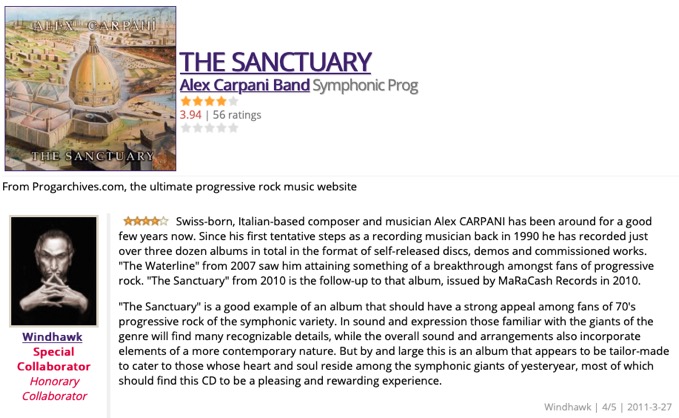
Swiss-born, Italian-based composer and musician Alex CARPANI has been around for a good few years now. Since his first tentative steps as a recording musician back in 1990 he has recorded just over three dozen albums in total in the format of self-released discs, demos and commissioned works. "The Waterline" from 2007 saw him attaining something of a breakthrough amongst fans of progressive rock. "The Sanctuary" from 2010 is the follow-up to that album, issued by MaRaCash Records in 2010.
"The Sanctuary" is a good example of an album that should have a strong appeal among fans of 70's progressive rock of the symphonic variety. In sound and expression those familiar with the giants of the genre will find many recognizable details, while the overall sound and arrangements also incorporate elements of a more contemporary nature. But by and large this is an album that appears to be tailor-made to cater to those whose heart and soul reside among the symphonic giants of yesteryear, most of which should find this CD to be a pleasing and rewarding experience.
No. 50
BACKGROUND MAGAZINE (THE NETHERLANDS)
http://www.backgroundmagazine.nl/QLinks/CarpaniSanctuary.html
by André de Waal
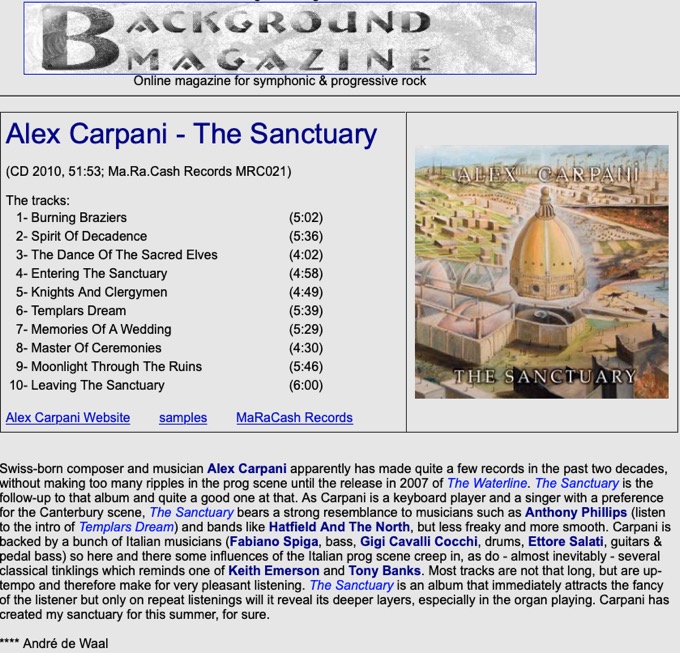
Swiss-born composer and musician Alex Carpani apparently has made quite a few records in the past two decades, without making too many ripples in the prog scene until the release in 2007 of The Waterline. The Sanctuary is the follow-up to that album and quite a good one at that. As Carpani is a keyboard player and a singer with a preference for the Canterbury scene, The Sanctuary bears a strong resemblance to musicians such as Anthony Phillips (listen to the intro of Templars Dream) and bands like Hatfield And The North, but less freaky and more smooth. Carpani is backed by a bunch of Italian musicians (Fabiano Spiga, bass, Gigi Cavalli Cocchi, drums, Ettore Salati, guitars & pedal bass) so here and there some influences of the Italian prog scene creep in, as do, almost inevitably, several classical tinklings which reminds one of Keith Emerson and Tony Banks. Most tracks are not that long, but are up-tempo and therefore make for very pleasant listening. The Sanctuary is an album that immediately attracts the fancy of the listener but only on repeat listenings will it reveal its deeper layers, especially in the organ playing. Carpani has created my sanctuary for this summer, for sure.
No. 51
PROGARCHIVES (U.S.A.)
http://www.progarchives.com/review.asp?id=610179
by Andrea
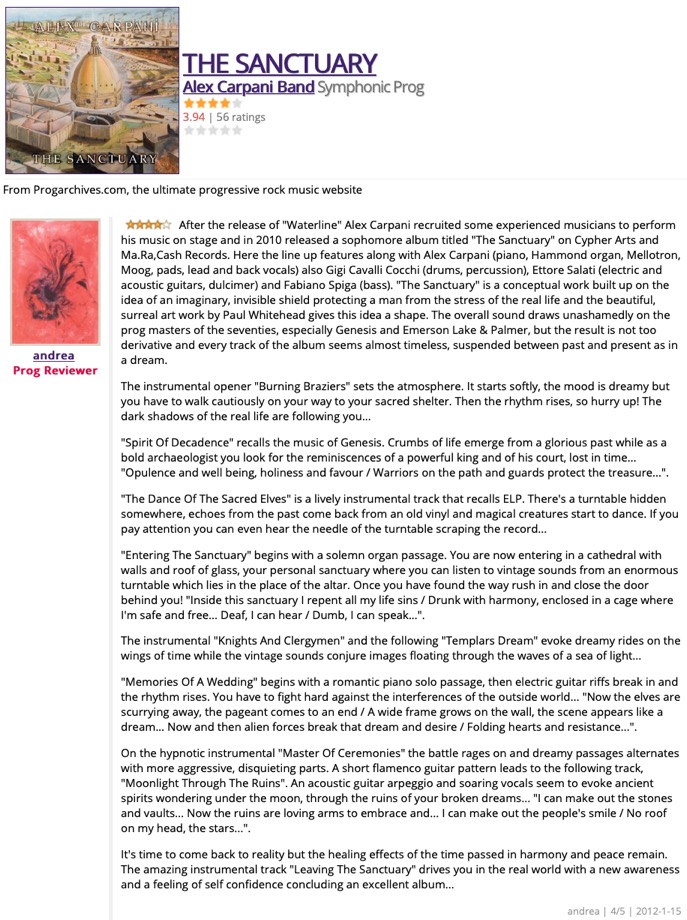
After the release of "Waterline" Alex Carpani recruited some experienced musicians to perform his music on stage and in 2010 released a sophomore album titled "The Sanctuary" on Cypher Arts and Ma.Ra,Cash Records. Here the line up features along with Alex Carpani (piano, Hammond organ, Mellotron, Moog, pads, lead and back vocals) also Gigi Cavalli Cocchi (drums, percussion), Ettore Salati (electric and acoustic guitars, dulcimer) and Fabiano Spiga (bass). "The Sanctuary" is a conceptual work built up on the idea of an imaginary, invisible shield protecting a man from the stress of the real life and the beautiful, surreal art work by Paul Whitehead gives this idea a shape. The overall sound draws unashamedly on the prog masters of the seventies, especially Genesis and Emerson Lake & Palmer, but the result is not too derivative and every track of the album seems almost timeless, suspended between past and present as in a dream. The instrumental opener "Burning Braziers" sets the atmosphere. It starts softly, the mood is dreamy but you have to walk cautiously on your way to your sacred shelter. Then the rhythm rises, so hurry up! The dark shadows of the real life are following you... "Spirit Of Decadence" recalls the music of Genesis. Crumbs of life emerge from a glorious past while as a bold archaeologist you look for the reminiscences of a powerful king and of his court, lost in time... "Opulence and well being, holiness and favour / Warriors on the path and guards protect the treasure...". "The Dance Of The Sacred Elves" is a lively instrumental track that recalls ELP. There's a turntable hidden somewhere, echoes from the past come back from an old vinyl and magical creatures start to dance. If you pay attention you can even hear the needle of the turntable scraping the record... "Entering The Sanctuary" begins with a solemn organ passage. You are now entering in a cathedral with walls and roof of glass, your personal sanctuary where you can listen to vintage sounds from an enormous turntable which lies in the place of the altar. Once you have found the way rush in and close the door behind you! "Inside this sanctuary I repent all my life sins / Drunk with harmony, enclosed in a cage where I'm safe and free... Deaf, I can hear / Dumb, I can speak...". The instrumental "Knights And Clergymen" and the following "Templars Dream" evoke dreamy rides on the wings of time while the vintage sounds conjure images floating through the waves of a sea of light... "Memories Of A Wedding" begins with a romantic piano solo passage, then electric guitar riffs break in and the rhythm rises. You have to fight hard against the interferences of the outside world... "Now the elves are scurrying away, the pageant comes to an end / A wide frame grows on the wall, the scene appears like a dream... Now and then alien forces break that dream and desire / Folding hearts and resistance...". On the hypnotic instrumental "Master Of Ceremonies" the battle rages on and dreamy passages alternates with more aggressive, disquieting parts. A short flamenco guitar pattern leads to the following track, "Moonlight Through The Ruins". An acoustic guitar arpeggio and soaring vocals seem to evoke ancient spirits wondering under the moon, through the ruins of your broken dreams... "I can make out the stones and vaults... Now the ruins are loving arms to embrace and... I can make out the people's smile / No roof on my head, the stars...". It's time to come back to reality but the healing effects of the time passed in harmony and peace remain. The amazing instrumental track "Leaving The Sanctuary" drives you in the real world with a new awareness and a feeling of self confidence concluding an excellent album... (4/5)
No. 52
PROGARCHIVES (U.S.A.)
http://www.progarchives.com/Review.asp?id=612129
by Conor Fynes
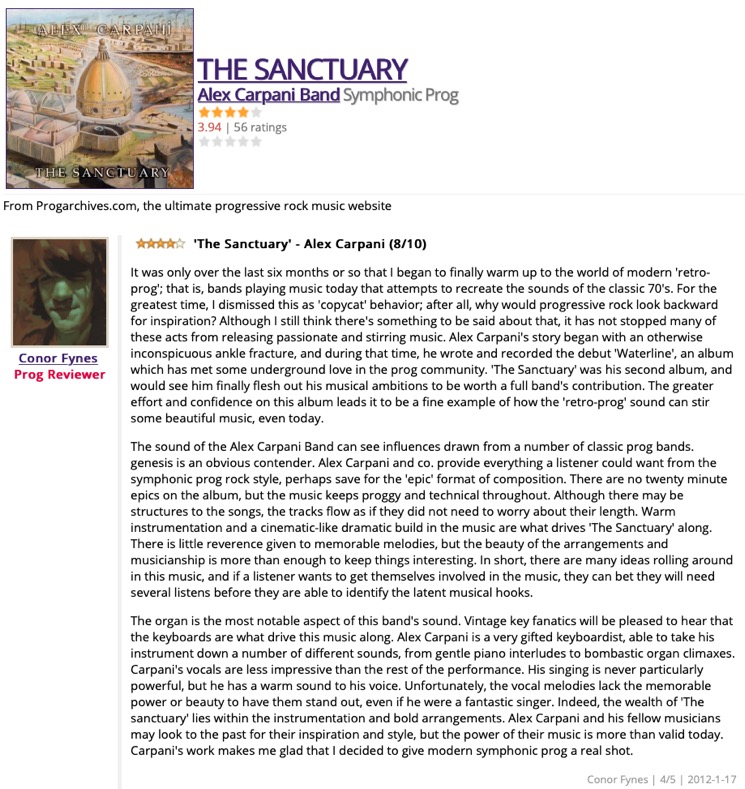
It was only over the last six months or so that I began to finally warm up to the world of modern 'retro-prog'; that is, bands playing music today that attempts to recreate the sounds of the classic 70's. For the greatest time, I dismissed this as 'copycat' behavior; after all, why would progressive rock look backward for inspiration? Although I still think there's something to be said about that, it has not stopped many of these acts from releasing passionate and stirring music. Alex Carpani's story began with an otherwise inconspicuous ankle fracture, and during that time, he wrote and recorded the debut 'Waterline', an album which has met some underground love in the prog community. 'The Sanctuary' was his second album, and would see him finally flesh out his musical ambitions to be worth a full band's contribution. The greater effort and confidence on this album leads it to be a fine example of how the 'retro-prog' sound can stir some beautiful music, even today. The sound of the Alex Carpani Band can see influences drawn from a number of classic prog bands. genesis is an obvious contender. Alex Carpani and co. provide everything a listener could want from the symphonic prog rock style, perhaps save for the 'epic' format of composition. There are no twenty minute epics on the album, but the music keeps proggy and technical throughout. Although there may be structures to the songs, the tracks flow as if they did not need to worry about their length. Warm instrumentation and a cinematic-like dramatic build in the music are what drives 'The Sanctuary' along. There is little reverence given to memorable melodies, but the beauty of the arrangements and musicianship is more than enough to keep things interesting. In short, there are many ideas rolling around in this music, and if a listener wants to get themselves involved in the music, they can bet they will need several listens before they are able to identify the latent musical hooks. The organ is the most notable aspect of this band's sound. Vintage key fanatics will be pleased to hear that the keyboards are what drive this music along. Alex Carpani is a very gifted keyboardist, able to take his instrument down a number of different sounds, from gentle piano interludes to bombastic organ climaxes. Carpani's vocals are less impressive than the rest of the performance. His singing is never particularly powerful, but he has a warm sound to his voice. Unfortunately, the vocal melodies lack the memorable power or beauty to have them stand out, even if he were a fantastic singer. Indeed, the wealth of 'The sanctuary' lies within the instrumentation and bold arrangements. Alex Carpani and his fellow musicians may look to the past for their inspiration and style, but the power of their music is more than valid today. Carpani's work makes me glad that I decided to give modern symphonic prog a real shot. (8/10)
No. 53
DE BASER (ITALY)
http://www.debaser.it/recensionidb/ID_36701/Alex_Carpani_The_Sanctuary.htm
by Federock
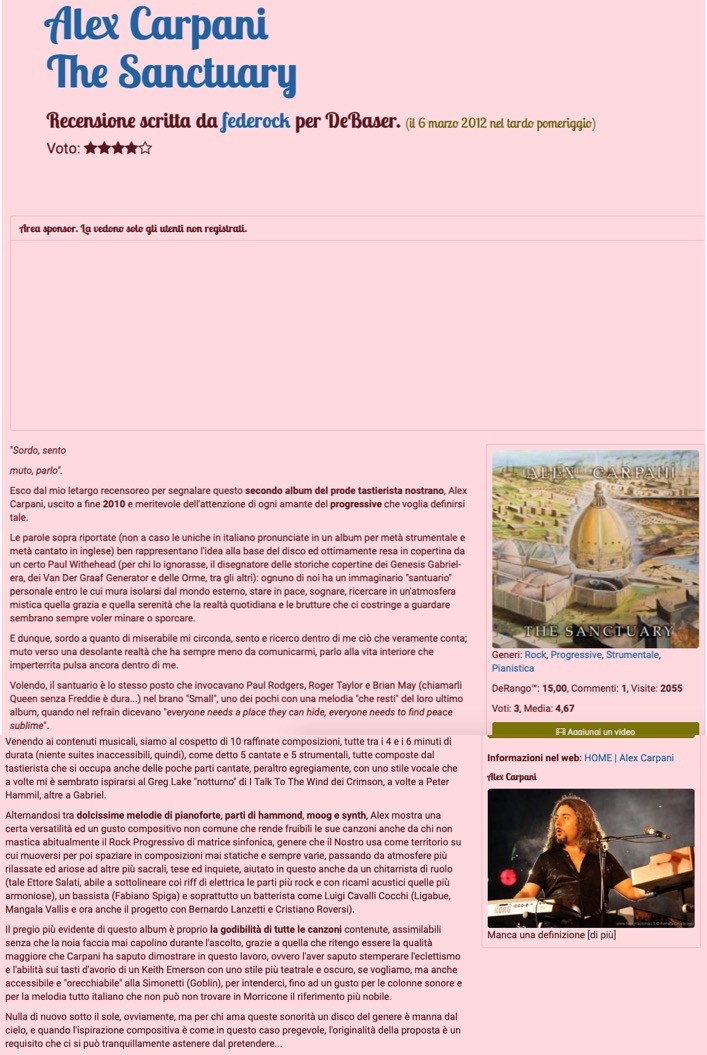
Esco dal mio letargo recensoreo per segnalare questo secondo album del prode tastierista nostrano, Alex Carpani, uscito a fine 2010 e meritevole dell'attenzione di ogni amante del progressive che voglia definirsi tale. Le parole sopra riportate (non a caso le uniche in italiano pronunciate in un album per metà strumentale e metà cantato in inglese) ben rappresentano l'idea alla base del disco ed ottimamente resa in copertina da un certo Paul Withehead (per chi lo ignorasse, il disegnatore delle storiche copertine dei Genesis Gabriel-era, dei Van Der Graaf Generator e delle Orme, tra gli altri): ognuno di noi ha un immaginario "santuario" personale entro le cui mura isolarsi dal mondo esterno, stare in pace, sognare, ricercare in un'atmosfera mistica quella grazia e quella serenità che la realtà quotidiana e le brutture che ci costringe a guardare sembrano sempre voler minare o sporcare. E dunque, sordo a quanto di miserabile mi circonda, sento e ricerco dentro di me ciò che veramente conta; muto verso una desolante realtà che ha sempre meno da comunicarmi, parlo alla vita interiore che imperterrita pulsa ancora dentro di me. Volendo, il santuario è lo stesso posto che invocavano Paul Rodgers, Roger Taylor e Brian May (chiamarli Queen senza Freddie è dura...) nel brano "Small", uno dei pochi con una melodia "che resti" del loro ultimo album, quando nel refrain dicevano "everyone needs a place they can hide, everyone needs to find peace sublime". Venendo ai contenuti musicali, siamo al cospetto di 10 raffinate composizioni, tutte tra i 4 e i 6 minuti di durata (niente suites inaccessibili, quindi), come detto 5 cantate e 5 strumentali, tutte composte dal tastierista che si occupa anche delle poche parti cantate, peraltro egregiamente, con uno stile vocale che a volte mi è sembrato ispirarsi al Greg Lake "notturno" di I Talk To The Wind dei Crimson, a volte a Peter Hammil, altre a Gabriel. Alternandosi tra dolcissime melodie di pianoforte, parti di hammond, moog e synth, Alex mostra una certa versatilità ed un gusto compositivo non comune che rende fruibili le sue canzoni anche da chi non mastica abitualmente il Rock Progressivo di matrice sinfonica, genere che il Nostro usa come territorio su cui muoversi per poi spaziare in composizioni mai statiche e sempre varie, passando da atmosfere più rilassate ed ariose ad altre più sacrali, tese ed inquiete, aiutato in questo anche da un chitarrista di ruolo (tale Ettore Salati, abile a sottolineare coi riff di elettrica le parti più rock e con ricami acustici quelle più armoniose), un bassista (Fabiano Spiga) e soprattutto un batterista come Luigi Cavalli Cocchi (Ligabue, Mangala Vallis e ora anche il progetto con Bernardo Lanzetti e Cristiano Roversi). Il pregio più evidente di questo album è proprio la godibilità di tutte le canzoni contenute, assimilabili senza che la noia faccia mai capolino durante l'ascolto, grazie a quella che ritengo essere la qualità maggiore che Carpani ha saputo dimostrare in questo lavoro, ovvero l'aver saputo stemperare l'eclettismo e l'abilità sui tasti d'avorio di un Keith Emerson con uno stile più teatrale e oscuro, se vogliamo, ma anche accessibile e "orecchiabile" alla Simonetti (Goblin), per intenderci, fino ad un gusto per le colonne sonore e per la melodia tutto italiano che non può non trovare in Morricone il riferimento più nobile. Nulla di nuovo sotto il sole, ovviamente, ma per chi ama queste sonorità un disco del genere è manna dal cielo, e quando l'ispirazione compositiva è come in questo caso pregevole, l'originalità della proposta è un requisito che ci si può tranquillamente astenere dal pretendere...
No. 54
PROGULATOR
http://progulator.com/reviews/bite-size/bite-size-prog-leftovers-and-snacks/
by the staff
The keyboards are incredible and it’s got great old school Italian appeal; it’s soaked with great analog synths and vintage organs. Composition is solid and doesn’t leave you bored. Although this is not a groundbreaking album by any means, it carries on the classic 70’s Italian spirit with flying colors. Great melodies abound throughout. Basically if you love great sounding synths, I don’t see why you wouldn’t like this. It can even get slightly jazzy at times :) And there’s something about the vocalist that reminds me of Wobbler’s original singer???
No. 55
PROGMEISTER
http://progmeister.com/alex-carpani-the-sanctuary
by Steve Petch
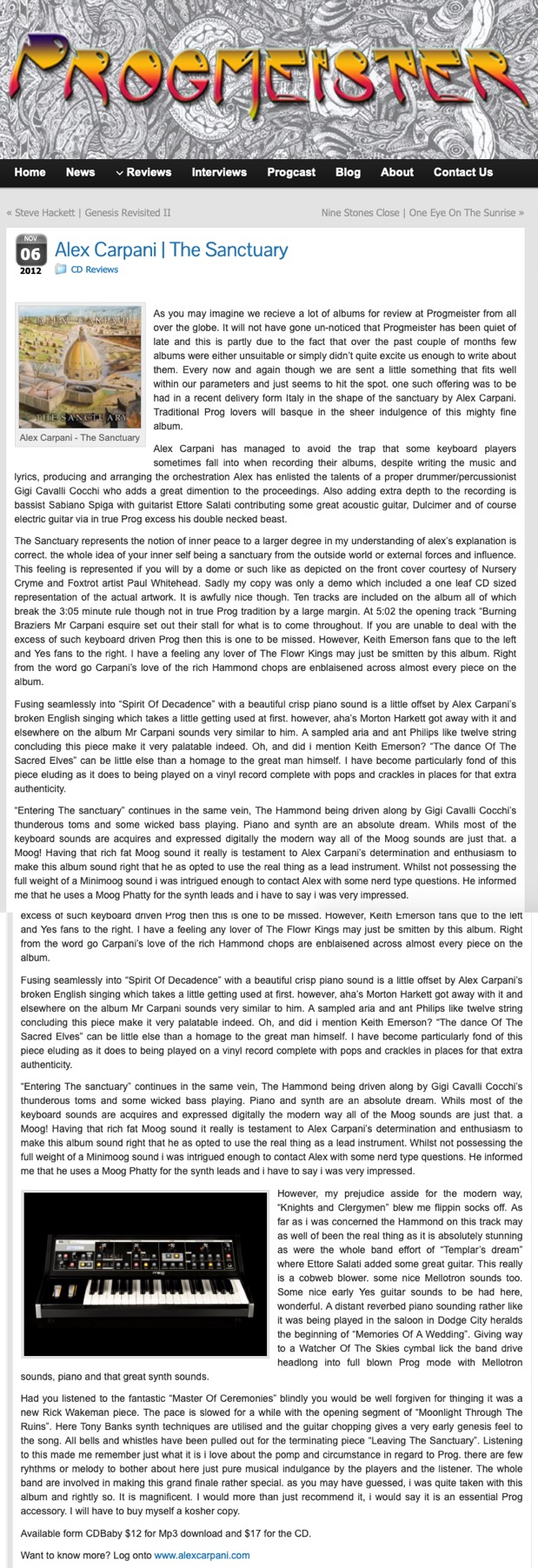
As you may imagine we recieve a lot of albums for review at Progmeister from all over the globe. It will not have gone un-noticed that Progmeister has been quiet of late and this is partly due to the fact that over the past couple of months few albums were either unsuitable or simply didn’t quite excite us enough to write about them. Every now and again though we are sent a little something that fits well within our parameters and just seems to hit the spot. One such offering was to be had in a recent delivery form Italy in the shape of the sanctuary by Alex Carpani. Traditional Prog lovers will basque in the sheer indulgence of this mighty fine album. Alex Carpani has managed to avoid the trap that some keyboard players sometimes fall into when recording their albums, despite writing the music and lyrics, producing and arranging the orchestration Alex has enlisted the talents of a proper drummer/percussionist Gigi Cavalli Cocchi who adds a great dimention to the proceedings. Also adding extra depth to the recording is bassist Fabiano Spiga with guitarist Ettore Salati contributing some great acoustic guitar, Dulcimer and of course electric guitar via in true Prog excess his double necked beast. The Sanctuary represents the notion of inner peace to a larger degree in my understanding of alex’s explanation is correct. The whole idea of your inner self being a sanctuary from the outside world or external forces and influence. This feeling is represented if you will by a dome or such like as depicted on the front cover courtesy of Nursery Cryme and Foxtrot artist Paul Whitehead. Sadly my copy was only a demo which included a one leaf CD sized representation of the actual artwork. It is awfully nice though. Ten tracks are included on the album all of which break the 3:05 minute rule though not in true Prog tradition by a large margin. At 5:02 the opening track “Burning Braziers Mr Carpani esquire set out their stall for what is to come throughout. If you are unable to deal with the excess of such keyboard driven Prog then this is one to be missed. However, Keith Emerson fans que to the left and Yes fans to the right. I have a feeling any lover of The Flowr Kings may just be smitten by this album. Right from the word go Carpani’s love of the rich Hammond chops are enblaisened across almost every piece on the album. Fusing seamlessly into “Spirit Of Decadence” with a beautiful crisp piano sound is a little offset by Alex Carpani’s broken English singing which takes a little getting used at first. However, aha’s Morton Harkett got away with it and elsewhere on the album Mr Carpani sounds very similar to him. A sampled aria and ant Philips like twelve string concluding this piece make it very palatable indeed. Oh, and did i mention Keith Emerson? “The dance Of The Sacred Elves” can be little else than a homage to the great man himself. I have become particularly fond of this piece eluding as it does to being played on a vinyl record complete with pops and crackles in places for that extra authenticity. “Entering The sanctuary” continues in the same vein, The Hammond being driven along by Gigi Cavalli Cocchi’s thunderous toms and some wicked bass playing. Piano and synth are an absolute dream. Whils most of the keyboard sounds are acquires and expressed digitally the modern way all of the Moog sounds are just that. A Moog! Having that rich fat Moog sound it really is testament to Alex Carpani’s determination and enthusiasm to make this album sound right that he as opted to use the real thing as a lead instrument. Whilst not possessing the full weight of a Minimoog sound i was intrigued enough to contact Alex with some nerd type questions. He informed me that he uses a Moog Phatty for the synth leads and i have to say i was very impressed. However, my prejudice asside for the modern way, “Knights and Clergymen” blew me flippin socks off. As far as i was concerned the Hammond on this track may as well of been the real thing as it is absolutely stunning as were the whole band effort of “Templar’s dream” where Ettore Salati added some great guitar. This really is a cobweb blower. Some nice Mellotron sounds too. Some nice early Yes guitar sounds to be had here, wonderful. A distant reverbed piano sounding rather like it was being played in the saloon in Dodge City heralds the beginning of “Memories Of A Wedding”. Giving way to a Watcher Of The Skies cymbal lick the band drive headlong into full blown Prog mode with Mellotron sounds, piano and that great synth sounds. Had you listened to the fantastic “Master Of Ceremonies” blindly you would be well forgiven for thinging it was a new Rick Wakeman piece. The pace is slowed for a while with the opening segment of “Moonlight Through The Ruins”. Here Tony Banks synth techniques are utilised and the guitar chopping gives a very early genesis feel to the song. All bells and whistles have been pulled out for the terminating piece “Leaving The Sanctuary”. Listening to this made me remember just what it is i love about the pomp and circumstance in regard to Prog. there are few ryhthms or melody to bother about here just pure musical indulgance by the players and the listener. The whole band are involved in making this grand finale rather special. as you may have guessed, i was quite taken with this album and rightly so. It is magnificent. I would more than just recommend it, i would say it is an essential Prog accessory. I will have to buy myself a kosher copy. Available form CDBaby $12 for Mp3 download and $17 for the CD. Want to know more? Log onto www.alexcarpani.com
No. 56
ITALIAN PROG MAP (ITALY)
http://italianprogmap.blogspot.it/2012/12/shelter-from-storm.html
by Andrea Parentin

SHELTER FROM THE STORM
After the release of “Waterline” Alex Carpani recruited some experienced musicians to perform his music on stage and in 2010 released a sophomore album titled “The Sanctuary” on Cypher Arts and Ma.Ra,Cash Records. Here the line up features along with Alex Carpani (piano, Hammond organ, Mellotron, Moog, pads, lead and back vocals) also Gigi Cavalli Cocchi (drums, percussion), Ettore Salati (electric and acoustic guitars, dulcimer) and Fabiano Spiga (bass). “The Sanctuary” is a conceptual work built up on the idea of an imaginary, invisible shield protecting a man from the stress of the real life and the beautiful, surreal art work by Paul Whitehead gives this idea a shape. The overall sound draws unashamedly on the prog masters of the seventies, especially Genesis and Emerson Lake & Palmer, but the result is not too derivative and every track of the album seems almost timeless, suspended between past and present as in a dream. The instrumental opener “Burning Braziers” sets the atmosphere. It starts softly, the mood is dreamy but you have to walk cautiously on your way to your sacred shelter. Then the rhythm rises, so hurry up! The dark shadows of the real life are following you... “Spirit Of Decadence” recalls the music of Genesis. Crumbs of life emerge from a glorious past while as a bold archaeologist you look for the reminiscences of a powerful king and of his court, lost in time... “Opulence and well being, holiness and favour / Warriors on the path and guards protect the treasure...”. “The Dance Of The Sacred Elves” is a lively instrumental track that recalls ELP. There’s a turntable hidden somewhere, echoes from the past come back from an old vinyl and magical creatures start to dance. If you pay attention you can even hear the needle of the turntable scraping the record... “Entering The Sanctuary” begins with a solemn organ passage. You are now entering in a cathedral with walls and roof of glass, your personal sanctuary where you can listen to vintage sounds from an enormous turntable which lies in the place of the altar. Once you have found the way rush in and close the door behind you! “Inside this sanctuary I repent all my life sins / Drunk with harmony, enclosed in a cage where I’m safe and free... Deaf, I can hear / Dumb, I can speak...”. The instrumental “Knights And Clergymen” and the following “Templars Dream” evoke dreamy rides on the wings of time while the vintage sounds conjure images floating through the waves of a sea of light... “Memories Of A Wedding” begins with a romantic piano solo passage, then electric guitar riffs break in and the rhythm rises. You have to fight hard against the interferences of the outside world... “Now the elves are scurrying away, the pageant comes to an end / A wide frame grows on the wall, the scene appears like a dream... Now and then alien forces break that dream and desire / Folding hearts and resistance...”. On the hypnotic instrumental “Master Of Ceremonies” the battle rages on and dreamy passages alternates with more aggressive, disquieting parts. A short flamenco guitar pattern leads to the following track, “Moonlight Through The Ruins”. An acoustic guitar arpeggio and soaring vocals seem to evoke ancient spirits wondering under the moon, through the ruins of your broken dreams... “I can make out the stones and vaults... Now the ruins are loving arms to embrace and... I can make out the people’s smile / No roof on my head, the stars...”. It’s time to come back to reality but the healing effects of the time passed in harmony and peace remain. The amazing instrumental track “Leaving The Sanctuary” drives you in the real world with a new awareness and a feeling of self confidence concluding an excellent album...
No. 57
NEO PROG (FRANCE)
http://www.neoprog.eu/critique/alex_carpani_band/the_sanctuary
by Jean-Christophe
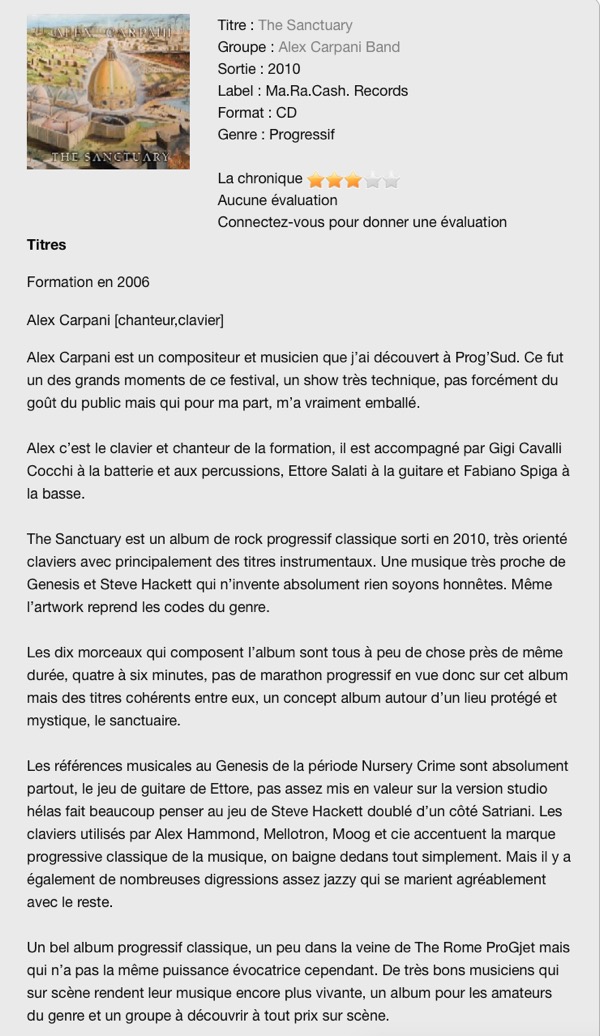
Alex Carpani est un compositeur et musicien que j’ai découvert à Prog’Sud. Ce fut un des grands moments de ce festival, un show très technique, pas forcément du goût du public mais qui pour ma part, m’a vraiment emballé. Alex c’est le clavier et chanteur de la formation, il est accompagné par Gigi Cavalli Cocchi à la batterie et aux percussions, Ettore Salati à la guitare et Fabiano Spiga à la basse. The Sanctuary est un album de rock progressif classique sorti en 2010, très orienté claviers avec principalement des titres instrumentaux. Une musique très proche de Genesis et Steve Hackett qui n’invente absolument rien soyons honnêtes. Même l’artwork reprend les codes du genre. Les dix morceaux qui composent l’album sont tous à peu de chose près de même durée, quatre à six minutes, pas de marathon progressif en vue donc sur cet album mais des titres cohérents entre eux, un concept album autour d’un lieu protégé et mystique, le sanctuaire. Les références musicales au Genesis de la période Nursery Crime sont absolument partout, le jeu de guitare de Ettore, pas assez mis en valeur sur la version studio hélas fait beaucoup penser au jeu de Steve Hackett doublé d’un côté Satriani. Les claviers utilisés par Alex Hammond, Mellotron, Moog et cie accentuent la marque progressive classique de la musique, on baigne dedans tout simplement. Mais il y a également de nombreuses digressions assez jazzy qui se marient agréablement avec le reste. Un bel album progressif classique, un peu dans la veine de The Rome ProGjet mais qui n’a pas la même puissance évocatrice cependant. De très bons musiciens qui sur scène rendent leur musique encore plus vivante, un album pour les amateurs du genre et un groupe à découvrir à tout prix sur scène.
No. 58
KAKERECO MAGAZINE (JAPAN)
http://kakereco.com/magazine/?p=4773
by the staff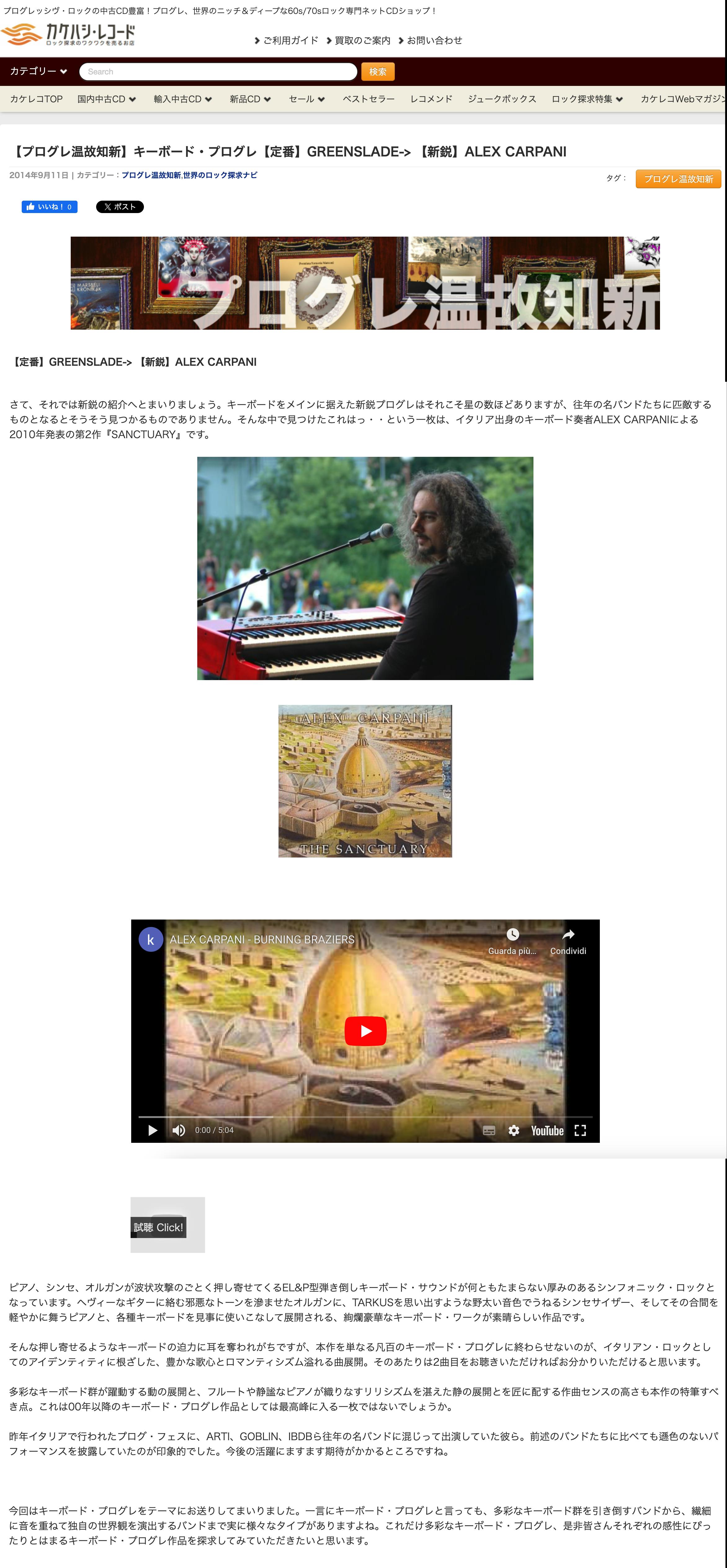
ピアノ、シンセ、オルガンが波状攻撃のごとく押し寄せてくるEL&P型弾きまくりキーボード・サウンドが何ともたまらない重厚なシンフォ ニック・ロックとなっています。ヘヴィーなギターに絡む邪悪さを滲ませたオルガンに、TARKUSを思い出すような野太い音色でうねるシンセサイザー、そ してその合間を軽やかに舞うピアノと、各種キーボードを見事に使いこなして展開される、目のくらむようなテクニカルでアグレッシヴなキーボード・ワークが あまりに見事な作品です。
ついキーボードの迫力に耳を奪われがちですが、本作を単なる一キーボード・プログレに終わらせないのが、イタリアン・ロックとしてのアイデンティ ティが息づいた、豊かな歌心とロマンティシズム溢れる曲展開。そのあたりは2曲目をお聴きいただければお分かりいただけると思います。
多彩なキーボード群が疾走する動の展開と、フルートや静謐なピアノによって織りなされるリリシズムいっぱいの静の展開とのバランスの素晴らしさも本作の特筆すべき点。これは00年以降のキーボード・プログレ作品としてはおそらく最高峰の一枚ではないでしょうか。
昨年イタリアで行われたプログ・フェスに往年のタリアン・ロック・バンドに混じって出演していた彼ら。これはそろそろ次回作が待たれるところですね。
今回はキーボード・プログレをテーマにお送りしてまいりました。一言にキーボード・プログレと言っても、多彩なキーボード群を引き倒すバンドから、 繊細に音を重ねて独自の世界観を演出するバンドまで実に様々なタイプがありますよね。これだけ多彩なキーボード・プログレ、是非皆さんそれぞれの感性に ぴったりとはまるキーボード・プログレ作品を探求してみていただきたいと思います。
No. 59
PROGARCHIVES (U.S.A.)
http://www.progarchives.com/Review.asp?id=939983
by b_olariu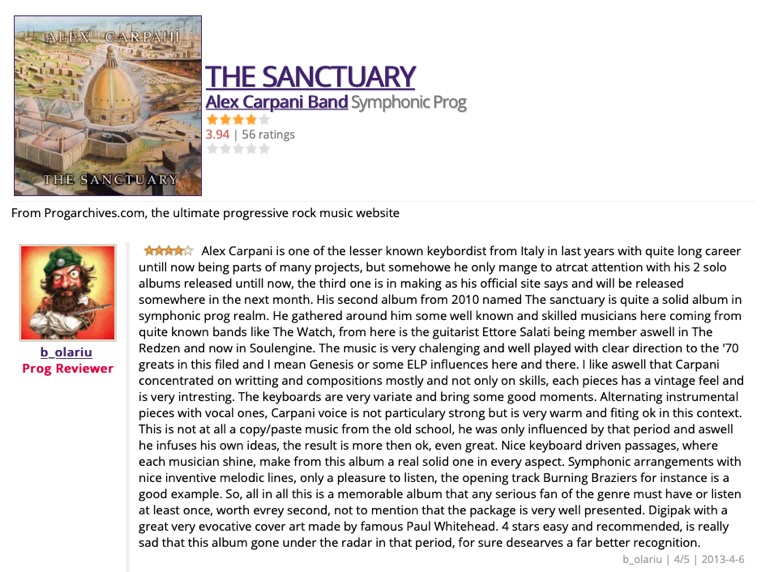
Alex Carpani is one of the lesser known keybordist from Italy in last years with quite long career untill now being parts of many projects, but somehowe he only mange to atrcat attention with his 2 solo albums released untill now, the third one is in making as his official site says and will be released somewhere in the next month. His second album from 2010 named The sanctuary is quite a solid album in symphonic prog realm. He gathered around him some well known and skilled musicians here coming from quite known bands like The Watch, from here is the guitarist Ettore Salati being member aswell in The Redzen and now in Soulengine. The music is very chalenging and well played with clear direction to the '70 greats in this filed and I mean Genesis or some ELP influences here and there. I like aswell that Carpani concentrated on writting and compositions mostly and not only on skills, each pieces has a vintage feel and is very intresting. The keyboards are very variate and bring some good moments. Alternating instrumental pieces with vocal ones, Carpani voice is not particulary strong but is very warm and fiting ok in this context. This is not at all a copy/paste music from the old school, he was only influenced by that period and aswell he infuses his own ideas, the result is more then ok, even great. Nice keyboard driven passages, where each musician shine, make from this album a real solid one in every aspect. Symphonic arrangements with nice inventive melodic lines, only a pleasure to listen, the opening track Burning Braziers for instance is a good example. So, all in all this is a memorable album that any serious fan of the genre must have or listen at least once, worth evrey second, not to mention that the package is very well presented. Digipak with a great very evocative cover art made by famous Paul Whitehead. 4 stars easy and recommended, is really sad that this album gone under the radar in that period, for sure deserves a far better recognition.
No. 60
PROGRESSIVE ROCK CENTRAL (U.S.A.)
http://progressiverockcentral.com/2014/12/04/alex-carpanis-keyboard-masterpiece/
by Angel Romero
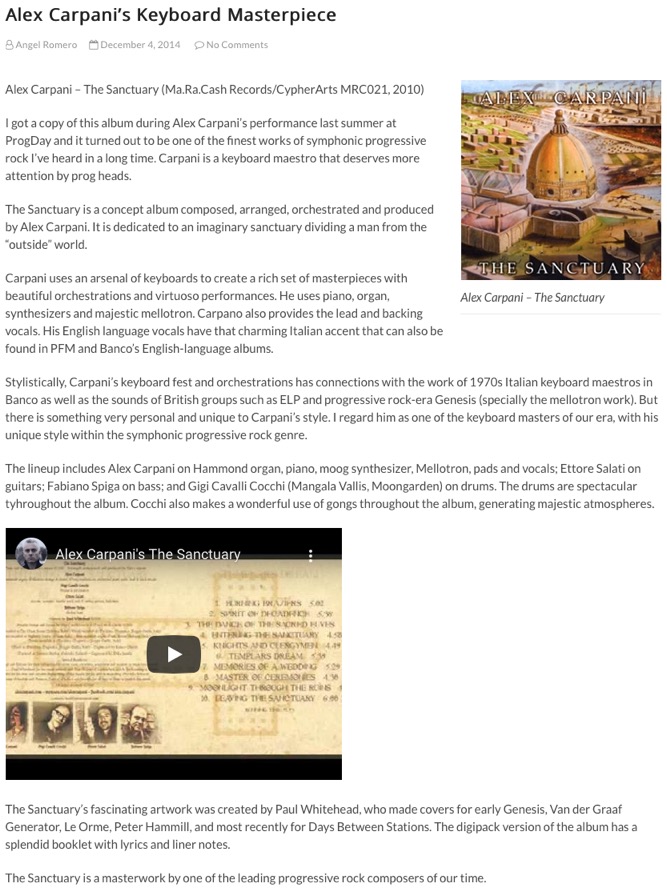
I got a copy of this album during Alex Carpani’s performance last summer at ProgDay and it turned out to be one of the finest works of symphonic progressive rock I’ve heard in a long time. Carpani is a keyboard maestro that deserves more attention by prog heads. The Sanctuary is a concept album composed, arranged, orchestrated and produced by Alex Carpani. It is dedicated to an imaginary sanctuary dividing a man from the “outside” world. Carpani uses an arsenal of keyboards to create a rich set of masterpieces with beautiful orchestrations and virtuoso performances. He uses piano, organ, synthesizers and majestic mellotron. Carpano also provides the lead and backing vocals. His English language vocals have that charming Italian accent that can also be found in PFM and Banco’s English-language albums. Stylistically, Carpani’s keyboard fest and orchestrations has connections with the work of 1970s Italian keyboard maestros in Banco as well as the sounds of British groups such as ELP and progressive rock-era Genesis (specially the mellotron work). But there is something very personal and unique to Carpani’s style. I regard him as one of the keyboard masters of our era, with his unique style within the symphonic progressive rock genre. The lineup includes Alex Carpani on Hammond organ, piano, moog synthesizer, Mellotron, pads and vocals; Ettore Salati on guitars; Fabiano Spiga on bass; and Gigi Cavalli Cocchi (Mangala Vallis, Moongarden) on drums. The drums are spectacular tyhroughout the album. Cocchi also makes a wonderful use of gongs throughout the album, generating majestic atmospheres. The Sanctuary’s fascinating artwork was created by Paul Whitehead, who made covers for early Genesis, Van der Graaf Generator, Le Orme, Peter Hammill, and most recently for Days Between Stations. The digipack version of the album has a splendid booklet with lyrics and liner notes. The Sanctuary is a masterwork by one of the leading progressive rock composers of our time.
No. 61
EXPOSE’ (U.S.A.)
http://www.expose.org/index.php/articles/display/alex-carpani-the-sanctuary-3.html
by Peter Thelen
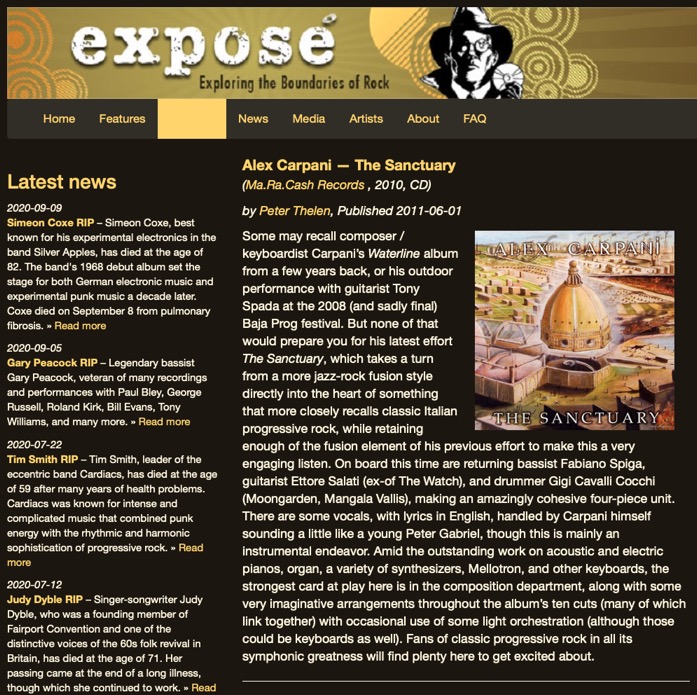
Some may recall composer / keyboardist Carpani’s Waterlinealbum from a few years back, or his outdoor performance with guitarist Tony Spada at the 2008 (and sadly final) Baja Prog festival. But none of that would prepare you for his latest effort The Sanctuary, which takes a turn from a more jazz-rock fusion style directly into the heart of something that more closely recalls classic Italian progressive rock, while retaining enough of the fusion element of his previous effort to make this a very engaging listen. On board this time are returning bassist Fabiano Spiga, guitarist Ettore Salati (ex-of The Watch), and drummer Gigi Cavalli Cocchi (Moongarden, Mangala Vallis), making an amazingly cohesive four-piece unit. There are some vocals, with lyrics in English, handled by Carpani himself sounding a little like a young Peter Gabriel, though this is mainly an instrumental endeavor. Amid the outstanding work on acoustic and electric pianos, organ, a variety of synthesizers, Mellotron and other keyboards, the strongest card at play here is in the composition department, along with some very imaginative arrangements throughout the album’s ten cuts (many of which link together) with occasional use of some light orchestration (although those could be keyboards as well). Fans of classic progressive rock in all its symphonic greatness will find plenty here to get excited about.
